|
Additional Council Meeting Agenda
|
7 June 2022
|
Kapiti Coast District Council
Notice is hereby given
that a meeting of the Kapiti Coast District Council will
be held in the Council Chamber,
Ground Floor, 175 Rimu Road, Paraparaumu, on Tuesday 7 June 2022, 1.30pm.
Council Members
|
Mayor K Gurunathan
|
Chair
|
|
Deputy
Mayor Janet Holborow
|
Deputy
|
|
Cr
Angela Buswell
|
Member
|
|
Cr
James Cootes
|
Member
|
|
Cr
Jackie Elliott
|
Member
|
|
Cr
Gwynn Compton
|
Member
|
|
Cr
Jocelyn Prvanov
|
Member
|
|
Cr
Martin Halliday
|
Member
|
|
Cr
Sophie Handford
|
Member
|
|
Cr
Robert McCann
|
Member
|
|
Cr
Bernie Randall
|
Member
|
2 Council
Blessing
“As we deliberate on the
issues before us, we trust that we will reflect positively on the
communities we serve. Let us all seek to be effective and just, so that with
courage, vision and energy, we provide positive leadership in a spirit of
harmony and compassion.”
I a mātou e whiriwhiri ana
i ngā take kei mua i ō mātou aroaro, e pono ana mātou ka
kaha tonu ki te whakapau mahara huapai mō ngā hapori e mahi nei
mātou. Me kaha hoki mātou katoa kia whaihua, kia tōtika
tā mātou mahi, ā, mā te māia, te tiro whakamua me te
hihiri ka taea te arahi i roto i te kotahitanga me te aroha.
3 Apologies
4 Declarations
of Interest Relating to Items on the Agenda
Notification from Elected
Members of:
4.1 – any interests that
may create a conflict with their role as an elected member relating to the
items of business for this meeting, and
4.2 – any interests in
items in which they have a direct or indirect pecuniary interest as provided
for in the Local Authorities (Members’ Interests) Act 1968
5 Public
Speaking Time for Items Relating to the Agenda
6 Members’
Business
(a)
Public Speaking Time Responses
(b)
Leave of Absence
(c)
Matters of an Urgent Nature (advice to be provided to the Chair prior to
the commencement of the meeting)
|
Additional Council Meeting Agenda
|
7 June 2022
|
7 Reports
7.1 Council
Response to Ātiawa Ki Whakarongotai Charitable Trust Review
Kaituhi |
Author: Morag
Taimalietane, Principal Advisor
Kaiwhakamana
| Authoriser: Janice McDougall, Group Manager People and
Partnerships
Te pūtake |
Purpose
1 The
purpose of this report is to formally table Ātiawa ki Whakarongotai
Charitable Trust’s review of its partnership with Kāpiti Coast
District Council (the Council) and to seek approval of the recommended actions
for Council in response to the review.
2 This
report also seeks to outline wider matters with regard to Council reviewing its
partnership with all three iwi mana whenua – Ātiawa ki
Whakarongotai, Ngāti Raukawa (Ngā Hapū o Ōtaki) and
Ngāti Toa Rangatira (Te Rūnanga o Toa Rangatira).
He
whakarāpopoto | Executive summary
3 In
September 2017, Ātiawa ki Whakarongotai Charitable Trust (the Trust)
commenced an independent review of its partnership with Council and on 24
November 2019 signalled its intention to withdraw from Te Whakaminenga o
Kāpiti.
4 On
20 October 2020 the findings of the Trust’s review were presented to a
group of elected members and council staff at the Trust’s offices in
Waikanae.
5 Council
officers have undertaken work in order to address some of the key findings and
recommendations from the Trust’s review, as well as progressing other
work which more broadly enables Council to take some important steps towards
improving our partnership with mana whenua. This report seeks
Council’s endorsement of actions in response to the review.
6 There
is strong alignment between the Trust’s recommendations and the
Council’s proposed actions, and council officers are committed to
continuing to work with Ātiawa ki Whakarongotai Charitable Trust on a
mechanism to enable better partnership around operational planning and
delivery.
Te tuku haepapa
| Delegation
7 The
Council has the authority to consider this matter under Part A, section A.1 of
the Governance Structure and Delegations 2019-2022 Triennium
Taunakitanga | RECOMMENDATIONS
That the
Council:
A. formally
receives the Ātiawa ki Whakarongotai Charitable Trust’s review of
its partnership with Kāpiti Coast District Council and in doing so notes
its recommendations for strengthening the partnership, as set out in Appendix
One.
B. notes
the responses of council officers to the findings of the review, and the six
themes that guide them, as outlined in this report.
C. notes
the strong alignment between the Trust’s recommendations and the
Council’s proposed actions, and council officers’ commitment to
continuing to work with Ātiawa ki Whakarongotai Charitable Trust on a
mechanism to enable better partnership around operational planning and
delivery.
D. approves
the proposed actions developed in response to the Ātiawa ki Whakarongotai
Charitable Trust’s partnership review findings, as set out in Appendix
Two.
E. notes
that provision was made within budgets agreed through the Long Term Plan
2021-41 to deliver on the actions arising from the review.
F. notes
progress on implementing the proposed actions will be reported via the
Tāngata Whenua section of the Council’s quarterly performance
report.
G. notes
funding for iwi capacity will be reviewed annually to ensure it keeps pace with
the growing partnership between Council and its three mana whenua partners.
Tūāpapa | Background
Council Partnership
with Mana Whenua
8 The
Council has long shared a partnership with the three iwi mana whenua of the
Kāpiti Coast - Ngāti Raukawa, Ātiawa ki Whakarongotai, and
Ngāti Toa Rangatira.
9 In
1994, a Memorandum of Partnership was signed between the Council and the three
iwi to establish Te Whakaminenga o Kāpiti, a unique forum which was set up
to enable Council to engage meaningfully with mana whenua in order to fulfil
its legal and moral duties under legislation and Te Tiriti o Waitangi.
10 Under
the Memorandum of Partnership, Council’s goal is to forge a relationship
of mutual benefit between the Council and our iwi partners that will develop
into an effective and meaningful partnership.
11 Te
Whakaminenga o Kāpiti has become one of the
longest-standing partnerships between mana whenua and a council across the
motu. There is a sense of pride attached to that for Council at both a
governance and operational level, but this is accompanied by an acknowledgement
that what has got us this far together won’t necessarily be what’s
needed for us to continue to travel together for the next 25 years.
12 Ātiawa ki Whakarongotai Charitable Trust made the decision to
withdraw from Te Whakaminenga o Kāpiti on 24 November 2019 due to concerns
about the current state of the partnership. It had already begun a review of
the partnership at that point.
13 It is clear that much work is needed to strenghten our partnerships
to ensure mana whenua have a strong voice at all levels of decision making,
planning and delivery within the Council.
14
As noted in the 2020 Martin Jenkins Independent Organisational Review (Appendix
Three), Council and mana whenua have had different understandings of what
‘partnership’ means, and work needs to be done to explore
aspirations for the partnership moving forward.
Partnership
Review by Ātiawa ki Whakarongotai Charitable Trust
15 In
September 2017 a motion was moved at the Ātiawa ki Whakarongotai
Charitable Trust’s (ĀKW) Annual General Meeting to review the
Trust’s Memorandum of Partnership with the Council and to review the
effectiveness of the Te Whakaminenga o Kāpiti forum. This review was
conducted by the Trust’s Taiao unit.
16 On
20 October 2020 the findings of the Trust’s review were presented to a
group of elected members and council staff at the Trust’s offices in
Waikanae.
He
kōrerorero | Discussion
Review
findings
17 The
Review identified seven key findings and made 13 specific recommendations in
relation to those findings.
18 The
key findings and recommendations were:
18.1 Key
Finding One - Key kaupapa to support Ātiawa ki Whakarongotai Partnership
Strategy.
18.1.1
Nōu te rourou, Nāku te rourou; Clear designation of roles.
18.1.2 Mahi
Ngaio; Ensuring the competence of ĀKW representation and work.
18.1.3 Kotahitanga;
A cohesive approach to representing ĀKW’s Interests
18.2 Key
Finding Two - Critical partnership issues.
18.3 Key
Finding Three – Reinstate a direct relationship between the governance of
ĀKW and KCDC.
18.3.1 KCDC
provide for the resource for the chair or other appointed representative of
ĀKW Board to attend and contribute to Council and enable the upholding of
the partnership.
18.3.2 Councillors
attend a meeting once a year, or as required, with the Board, with the ability
to meet at Whakarongotai marae.
18.3.3 KCDC
provide resourcing to enable operational support to governance representation
at Council level.
18.3.4 Adequately
resource ĀKW succession to representative positions.
18.4 Key
Finding Four – Consolidate Ātiawa ki Whakarongotai representation
across other Standing Committees, Joint Committees and External Bodies of KCDC.
18.4.1 ĀKW
consolidate their representation on these other groups by way of as few
resourced individuals as possible.
18.4.2 That
resourcing of this representation could be identified as a single budgetary
item.
18.5 Key
Finding Five – Shift the operational relationship from being reactive to
delivering joint planning and implementation.
18.5.1 Establish
a District Services Partnership Group that provides for engagement
between the partners.
18.5.2 The
function of the Group be supported by resource to engage in internal
consultation with the Marae Reservation Trust,
key hapū and Māori landowner groups.
18.6 Key
Finding Six – Reinstate Te Whakaminenga o Kāpiti to its original
role guiding Council consultation at the right level.
18.6.1
Renew protocols for TWOK as set out in this finding.
18.7 Key
Finding Seven – Implement mechanisms of accountability for the partnership.
18.7.1
The presentation and discussion of ‘Ko te mana, ko te maramatanga’
to full Council once a year.
19 Overall,
the review highlighted an overwhelming need for our council to work
collectively with our iwi mana whenua partner to strengthen our Treaty-based
partnership.
Council
officers’ response to review findings and recommendations
20 After
receiving the Trust’s report, council officers sought and consolidated
feedback on the review findings from members of staff who regularly work with
iwi. This informed a set of responses to the Trust’s findings that was
considered and agreed by the councils Senior Leadership Team.
21 The
following is some of the general feedback received from council officers
regarding the findings and recommendations of the Trust’s Review:
21.1 Acknowledgement
of the difficulties arising from a lack of clarity around the timing and nature
of engagement with iwi;
21.2 Observed
challenges with a lack of clarity about our iwi partner’s governance
role;
21.3 Recognition
that Council needs to have in place consistently good practice for engagement
and collaboration occurring at the right level in the best interests of both
our iwi partners and Council;
21.4 Recognition
of a need for better organisational approaches and frameworks to drive more
visibility and understanding of mana whenua aspirations and a more consistent,
joined up approach (while also recognising that the Iwi Partnership team has a
key role to play in achieving that);
21.5 Agreement
that Council providing better support for developing iwi capacity would have
significant benefit for engagement and project delivery across the Council.
22 The
significant challenges around organisational workload, particularly due to the
ongoing pandemic, meant work on a response to the review findings progressed
slowly. Council officers acknowledge this has been a frustration for the Trust.
However, it is important to note that while a formal response was developed,
the findings of the review were reflected in officer advice and council
decision making, including through the development of the LTP 2021-41.
23 In
considering the Trust’s findings, Council has reflected on the degree to
which they speak to our partnership with all three of our mana whenua partners
– and as such, the proposed actions in response to the review are
recommended with all three iwi, to whom we have equal obligation, in mind.
Key
themes
24 Six
key themes guide the Council’s response to the review findings. These
themes have framed the Council’s proposed actions developed by council
officers in response to the Trust’s review at Appendix Two.
25 These
themes are outlined below:
25.1 Rangatiratanga:
That the three confederated iwi and their affiliated hāpu continue to
express tino rangatiratanga as mana whenua, giving effect to the partnership
with Council under Te Tiriti o Waitangi and embracing their expression of
Kāwanatanga.
25.2 Whanaungatanga:
That Council’s governance functions are guided by a partnership
between elected members and the three iwi mana whenua of Kāpiti Coast.
25.3 Manaakitanga:
The importance of better support at an operational level to enable iwi and
Council to better work together.
25.4 Ūkaipotanga:
The importance of supporting succession pathways within / for iwi.
25.5 Kaitiakitanga:
A commitment to improving Council’s understanding of the significance
of Te Ao Māori and our iwi partners’ role as kaitiaki.
25.6 Kotahitanga:
That disagreements are common in partnerships, but focus should be on
working through them in a mana enhancing way.
26 Council
officers are proposing 12 actions in response to the findings and
recommendations stated in the Review:
26.1 Enhance
pre-election information provided to candidates based on up-to-date detailed
information provided from iwi around the role of our iwi partners, their
governance structures and good governance.
26.2 Encourage
our iwi partners to be part of pre-election discussions with potential
candidates about the importance of their role as iwi partners, their governance
structures and histories.
26.3 Establish
opportunities for council officers, elected members and management to receive
an induction around the role of our iwi partners, their governance structures
and good governance.
26.4 Develop
a 3-year capability programme to build staff members’ understanding of Te
Ao Māori and the Council's legislative and partnership obligations to our
iwi partners. This programme would form part of the Council’s ongoing
core training programme.
26.5 Council
has worked with our iwi partners to understand how to more appropriately
resource iwi to participate in the work of Council. This is reflected in our
2021 Long Term Plan and will be an ongoing conversation.
26.6 Council
wants to ensure strong direct partnership between Council and ĀKW, and our
other two iwi partners. We are working with all three iwi partners to
review partnership arrangements.
26.7 Councillors
agree to attend a meeting once a year, or as required, with the ĀKW Board
at Whakarongotai marae.
26.8 Increased funding
is included in the Long-Term Plan 2021-41 to enable resourcing of
operational support for ĀKW representatives on Council governance bodies.
Further conversations needed regarding resourcing succession.
26.9 Increased
mana whenua representation within Council’s governance structure.
26.10 Officers
will actively seek early and constructive collaboration with our iwi partners
on operational planning and delivery.
26.11 Review Te
Whakaminenga o Kāpiti. This forms part of our Iwi Partnership Team’s
work programme and will be developed and scoped in partnership with our iwi
partners.
26.12 Council
will work with ĀKW to agree on key performance indicators for the
partnership, and how we can implement this mechanism to ensure accountability
for the partnership.
Progress
to date
27 Since
the Trust’s Review, as well as the Council’s Organisational Review,
council officers have already undertaken some work in order to address some of
the key findings and recommendations of both reviews.
28 At
an operational level there has been a notable shift in the nature and timing of
engagement with iwi – although there is much work left to do to make this
consistent and natural part of our planning and delivery processes.
29 Additionally,
the Long Term Plan 2021-41 was the foundation for enabling the Council at a
governance level to take some important steps towards ensuring a stronger voice
for mana whenua values, perspectives and priorities in establishing the
strategic direction for the district.
30 The
plan includes a community outcome highlighting the importance of the Mana
whenua-Council relationship – “Mana whenua and Council have a
mutually mana-enhancing partnership”.
31 Through
the LTP the concept of the ’pā harakeke’ was adopted to
represent the enduring relationship between Mana-whenua and Council at the
heart of our activities for the community. Council plans to contribute to this
outcome by partnering with local iwi to identify and achieve Mana Whenua community
wellbeing goals, strengthening capacity of iwi to work within government
frameworks and adequately resourcing Mana Whenua to engage with Council as
partners
32 Provisions
were also made through the LTP for additional budget to support the implementation
of the findings identified through the Trust’s review and our response,
as well as in response to our review of iwi representation more broadly.
33 In
July 2021, council officers met with the Trust to discuss Council’s
proposed set of actions in response to the Review.
He
take | Issues
Alignment
with the Trust’s recommendations
34 Broadly
there is strong alignment between the Review’s recommendations and the
council officers’ proposed actions in response.
35 There
are three areas where the proposed actions for Council do not fully align with
the Trust’s recommendations.
Chief Executive Performance and Employment Subcommittee
36 This report recommends
that Council does not appoint mana whenua representatives to the Chief
Executive Performance and Employment Subcommittee. Under the Local Government
Act 2002, Council is the employing body of the Chief Executive and this is
delegated to a subcommittee to ensure the effective management of this
employment relationship under the Employment Relations Act 2000. Given this
subcommittee’s sole purpose as an employer and the importance of
maintaining clear lines of accountability within the employment relationship, Council officers do not recommend appointing mana whenua representatives
to this subcommittee.
37 It
should be noted that there are differing approaches to this matter amongst
Councils across the motu. For example, last year Wellington City Council
voted in favour of one representative from each iwi to sit on each Council
committee and subcommittee with voting rights. The arrangement did not however
extend to the Council’s CEO Performance Review Committee. Council
officers noted that as this committee represents the employing body, it is not
seen as appropriate to include external members onto this committee, which may
result in confusion to the lines of accountability.
38 There
are other Councils who have decided differently on the matter. For example,
Rotorua Lakes Council has one iwi representative on the Chief Executive
Performance Review Committee. Porirua City Council has representation from Te
Runanga o Toa Rangatira on its Chief Executive’s Employment Committee.
Audit and Risk Subcommittee
39 Effective
audit and risk management is an essential function of local government. The
current composition of Council’s Audit and Risk Subcommittee reflects
best practice for the following reasons:
39.1 as
a subcommittee of Council, it comprises a smaller number of members (five
elected members and two external appointees with voting rights) to enable
Council to effectively and efficiently carry out the audit and risk function
39.2 the
appointment of an independent member as Chair, as well as an additional
independent appointee, to ensure a degree of independence from Council and
management and robust consideration of financial and non-financial risks
39.3 elected
members and appointees to the subcommittee have diverse and appropriate skills
and experience relevant to the role
40 Council
officers propose that one further independent representative be appointed to
this Subcommittee on behalf of all three iwi partners. This would give mana
whenua a stronger voice while at the same time maintaining a smaller
subcommittee of Councillors complimented by appointees with relevant
qualifications and experience that is able to effectively and efficiently carry
out the audit and risk function.
41 This
is not fully aligned with the recommendations of the Trust’s review,
which if carried through and applied to all three mana whenua iwi, would see
the committee change in size and potentially function.
District Services Partnership Group
42 Officers
recognise the need for better early and constructive collaboration with our iwi
partners on operational planning and delivery. However, staff have some
concerns that the District Services Model proposed by the Trust might not be
the right mechanism to support working together across the full range of
council activities and functions due to what appears to be a strong focus on
infrastructure in its make up and focus. Staff also have concerns that its name
could lead to a lack of clarity around its role. Council officers propose that
officers, and the Trust workshop this idea further, alongside the discussions
around increased capacity funding to support iwi resourcing and resourcing
succession.
43 Council
officers also note that the Trust’s representation at the table of
Council and Strategy and Operations committee, where direction is set for
Council’s key work programme and progress monitored, will also contribute
to a better reflection of iwi values in our operational activity.
Ngā
kōwhiringa | Options
44 Council
officers’ have not framed multiple options for Council consideration
given the close alignment between the Review’s finding and officer
recommendations.
45 While
officers’ note that there are some areas where further work will be
required for Council and Ātiawa ki Whakarongotai to develop an agreed
outcome, we did not consider this to outweigh the significant areas where there
was agreement on the way forward.
46 It
should be noted that Council does have the option of choosing to accept the
Ātiawa ki Whakarongotai review’s recommendations in relation to the
Chief Executive Performance and Employment Committee and Audit and Risk
Subcommittee, which as outlined above have not been recommended by council
staff.
Tangata whenua
47 While
the Trust’s review represents its own experience of partnerships, the key
findings and recommendations contained within it speak to matters of
partnership that directly affect all three of our iwi partners.
48 In
addressing the Trust’s review, Council’s has sought to address and
identify ways of strengthening our partnership with all three iwi partners.
This is because we have equal obligation towards all three iwi mana whenua as
our partners.
49 As
noted previously, council officers met with representatives of the Trust in
July 2021 to outline the officer recommendations in response to the report.
Trust representatives welcomed the strong alignment between their
recommendations and the staff position, but also noted their disappointment at
the position taken by staff in relation to CEPEC and Audit and Risk
Subcommittee in particular. It was agreed further conversation was needed to
agree the right mechanism to enable greater partnership at an operational
level.
50 For
a range of reasons, there has been no further meaningful engagement with the
Trust on these matters but council officers remain committed to creating
opportunities for it in the near future.
Panonitanga āhuarangi | Climate change
51 The
six key themes which guide the Council’s response to the review findings
clearly underpin the Councils commitment to improving our understanding of the
significance of Te Ao Māori and our iwi partners’ role as kaitiaki.
52 A
mana-enhancing partnership with our iwi partners would enable Council to better
support iwi aspirations for environmental improvements, as well as supporting
Council to better consider matauranga Māori knowledge through our response
to Climate Change.
Ahumoni me ngā rawa | Financial
and resourcing
53 Provision
was made within the LTP 2021-41 for additional budget to support the
implementation of actions proposed in response to the review.
54 There
will be additional budget implications to be considered as our partnership
approach with our iwi partnerships is further developed and refined.
These budget implications will be presented to the Council through the relevant
Annual or Long-Term Plan process.
Ture me ngā Tūraru | Legal
and risk
55 Legal
advice has been sought wherever appropriate in preparing a response to the
Trust’s review.
56 Legal
implications have been considered as part of the actions proposed, particularly
those which relate to the proposed governance structure changes.
Ngā pānga ki ngā kaupapa here | Policy impact
57 There
are no specific policy considerations at this time, however the implementation
of any of the proposed actions may create a need for new or amended policies,
particularly in relation to governance arrangements.
Te whakawhiti kōrero me te
tūhono | Communications &
engagement
58 This
matter has a moderate degree of significance under Council’s Significance
and Engagement Policy given the importance of our partnerships with mana
whenua, but does not trigger the consultation requirements of our Significance
and Engagement Policy.
Te mahere tūhono | Engagement
planning
59 Engagement
with our three iwi partners will be required to implement Council’s
proposed actions, as noted in Appendix Two.
Whakatairanga |
Publicity
60 There
may be public interest in this report, and Council will use its established
communications channels to inform the community of this decision and to explain
the rational for why it made this decision.
Ngā āpitihanga | Attachments
1. ĀKW
- KCDC Independent Partnership Review ⇩ 
2. Council
Response to ĀKW Review ⇩ 
3. Martin
Jenkins Organisational Review 2020 ⇩ 
|
Additional Council Meeting Agenda
|
7 June 2022
|


















|
Additional Council Meeting Agenda
|
7 June 2022
|




|
Additional Council Meeting Agenda
|
7 June 2022
|












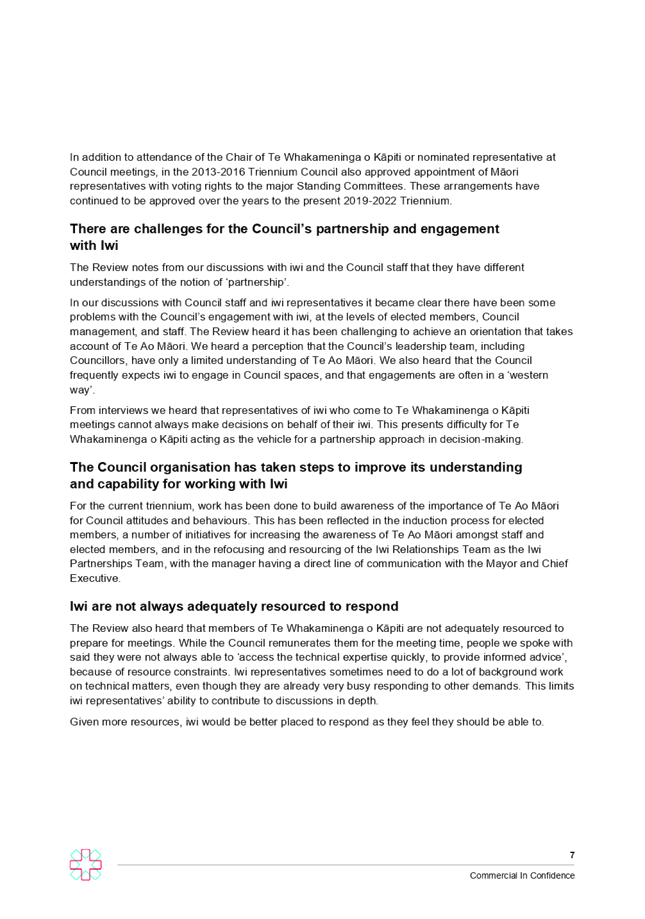


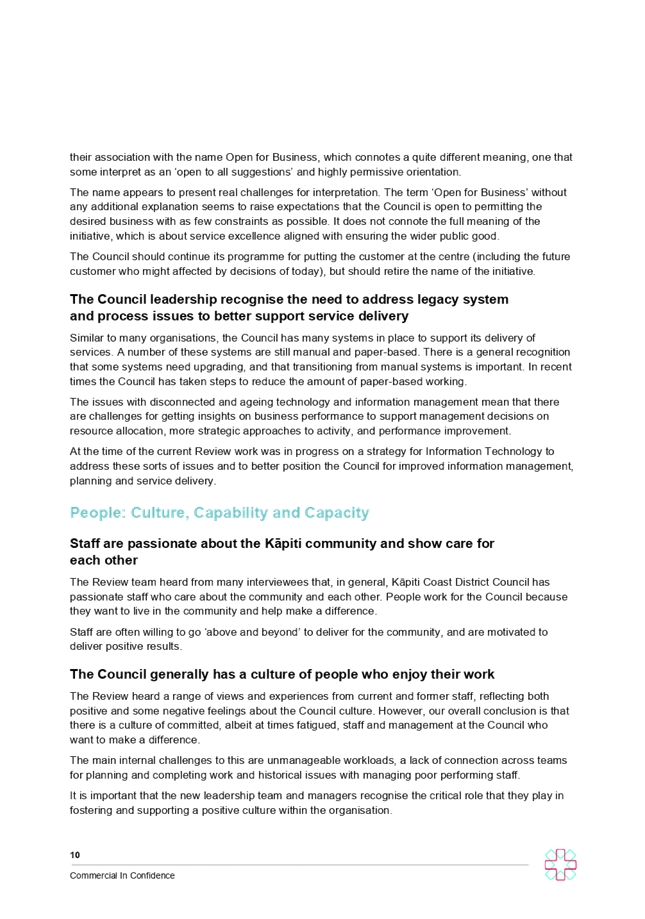




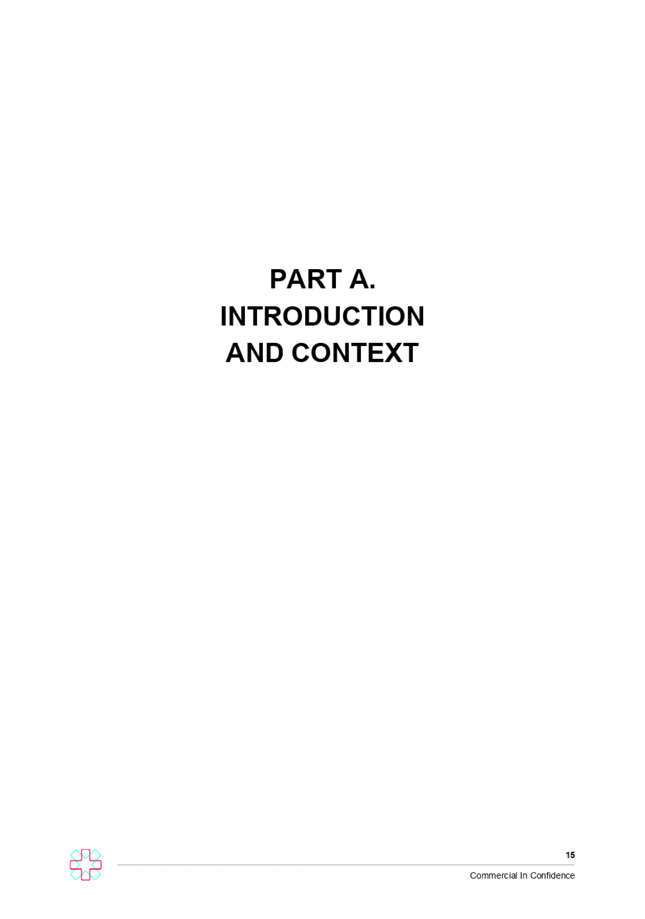
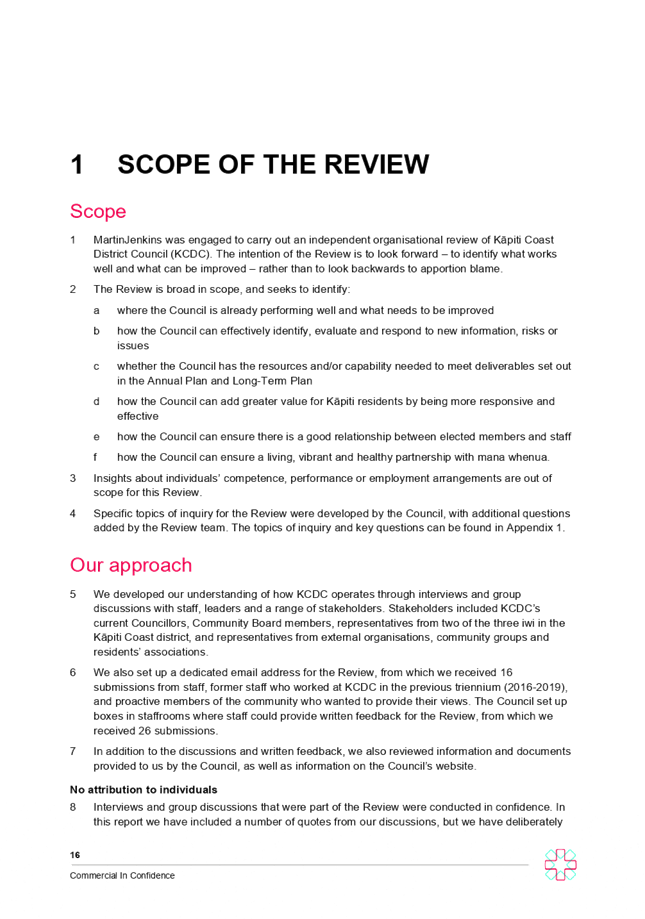
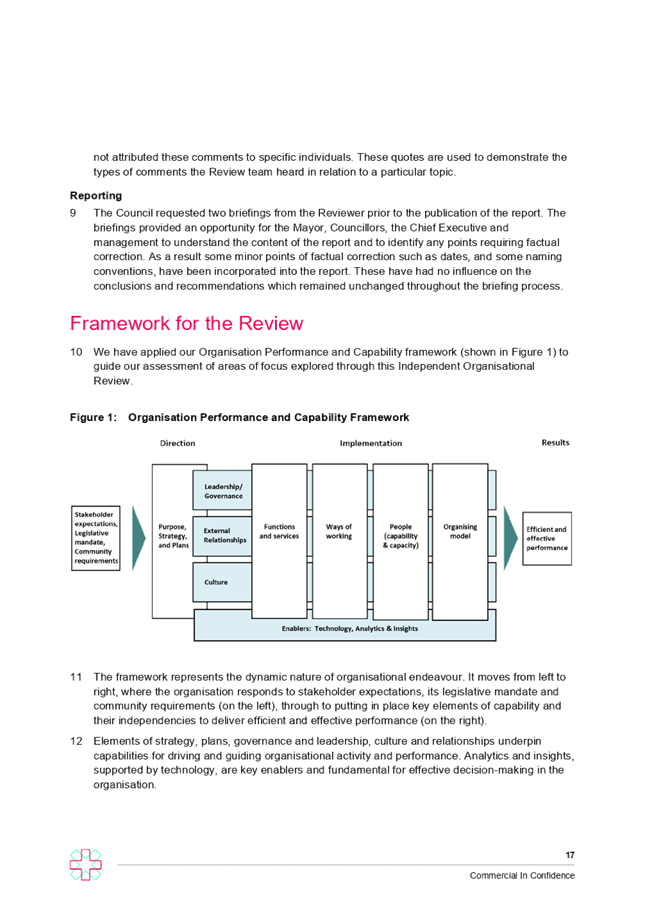

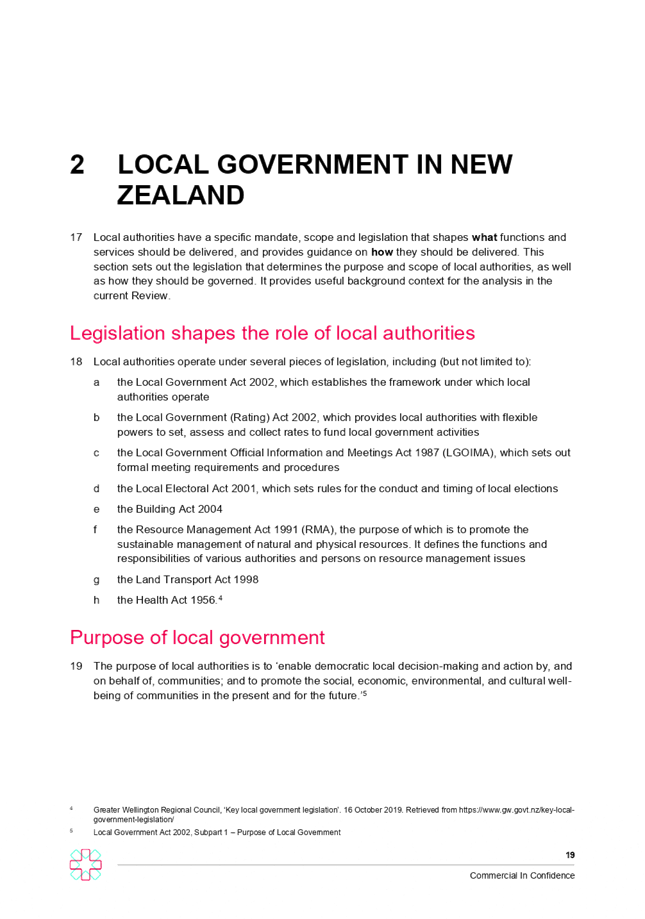
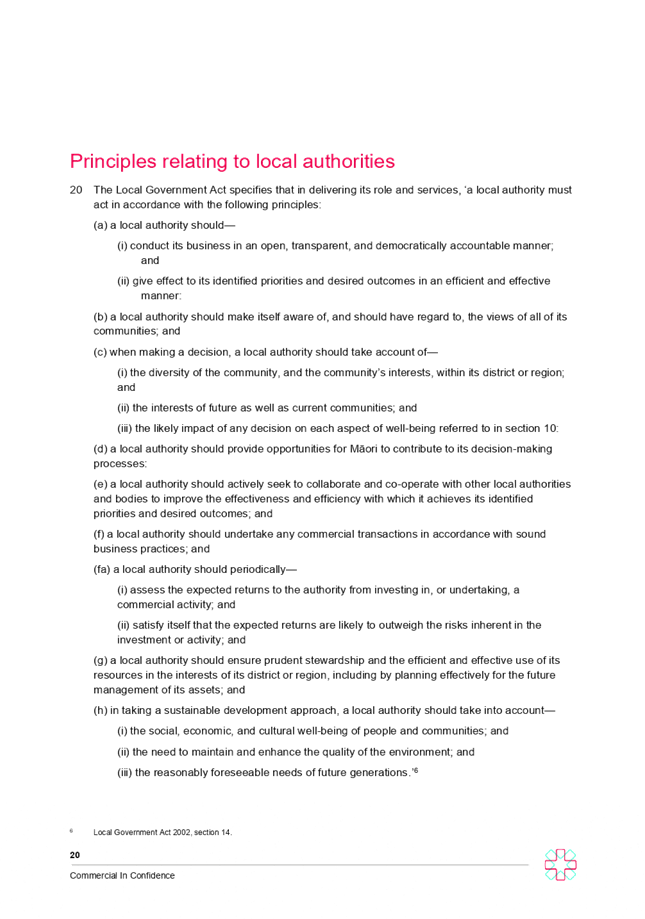
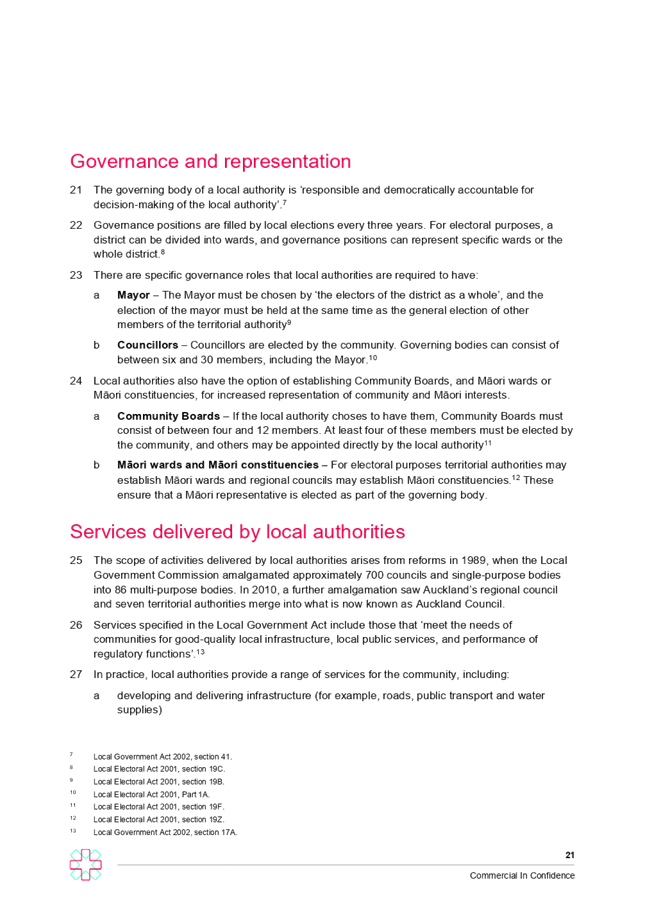

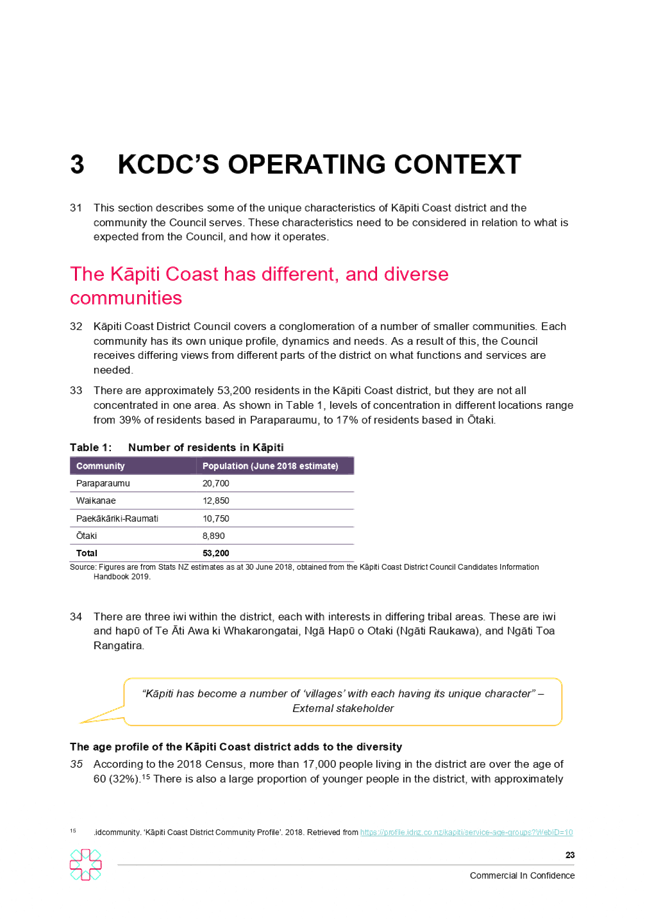
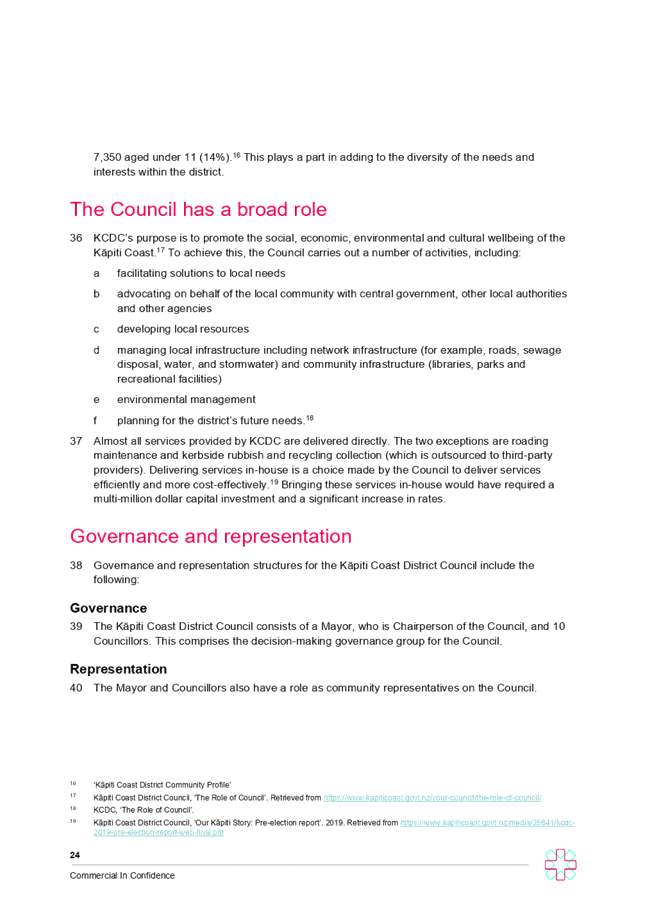
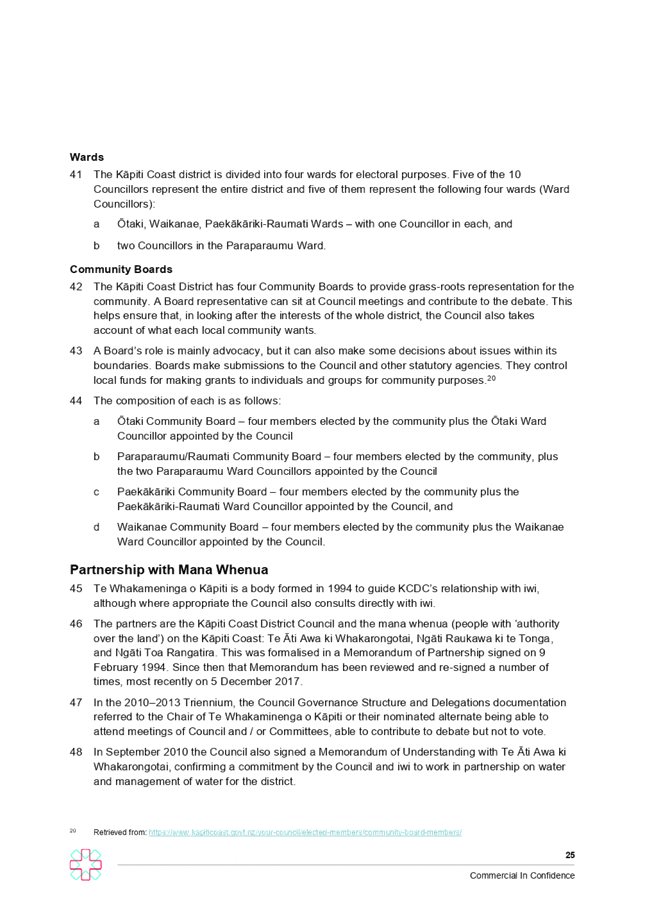
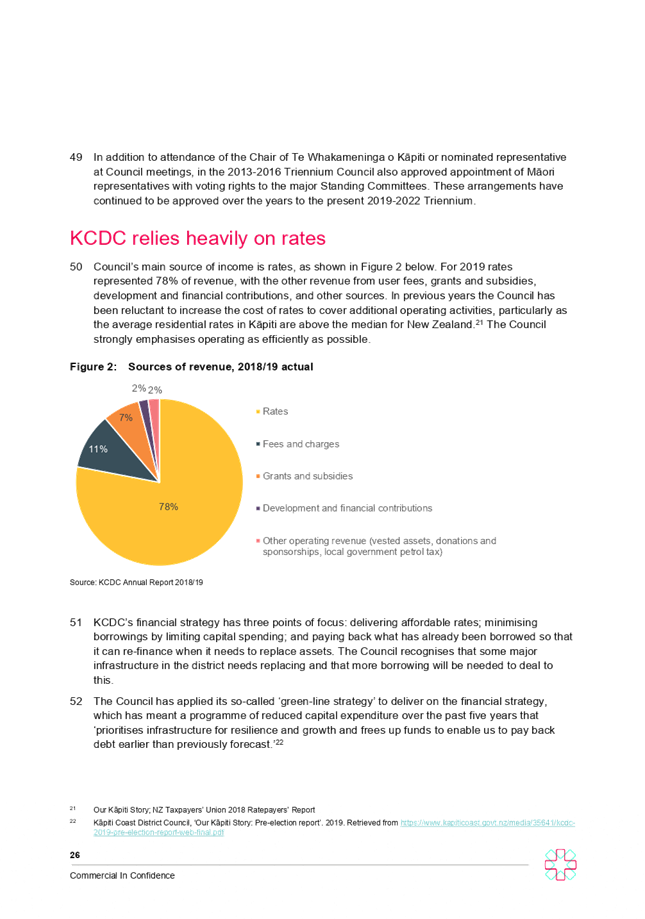

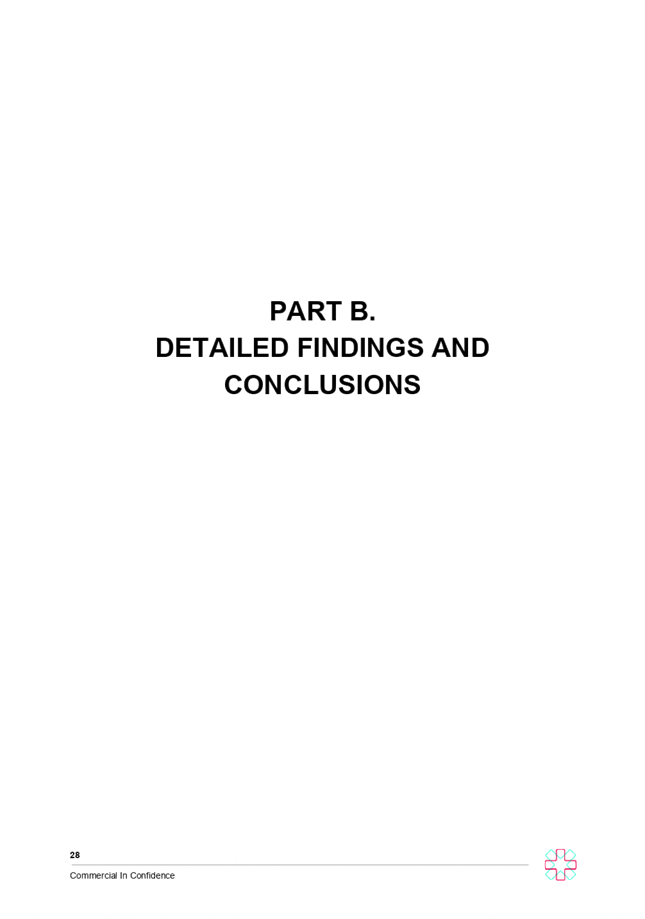
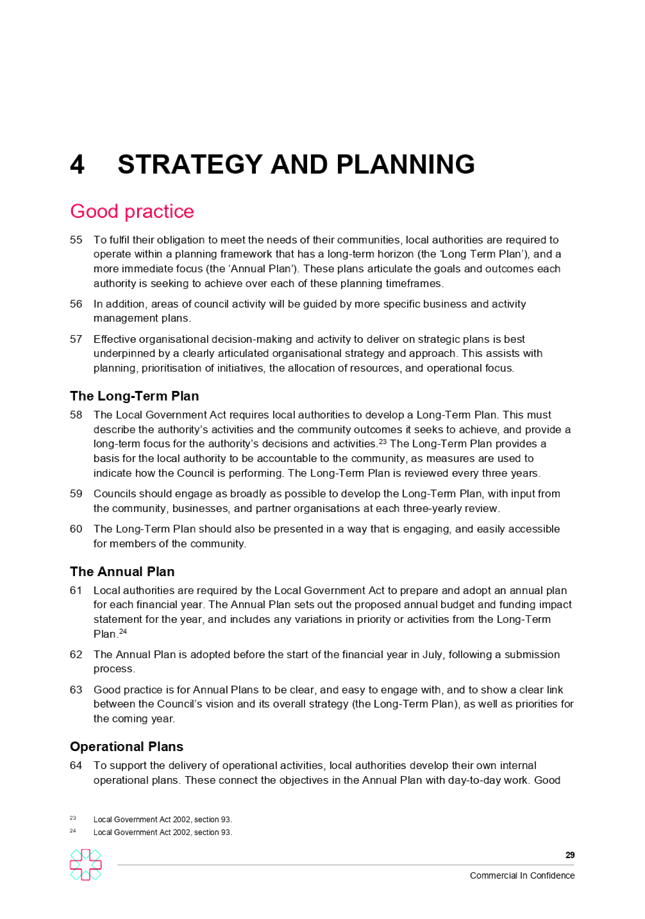
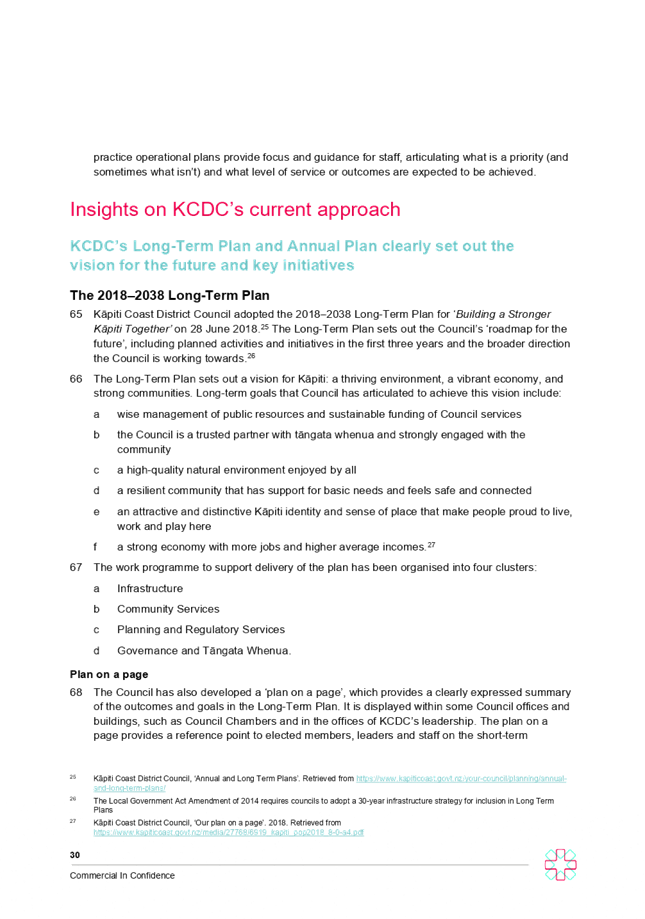

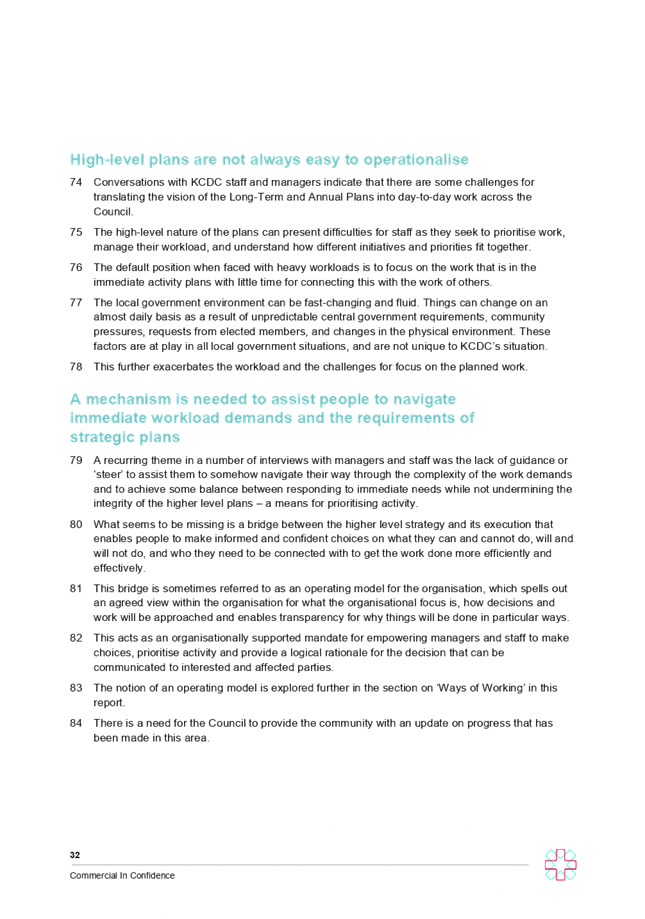
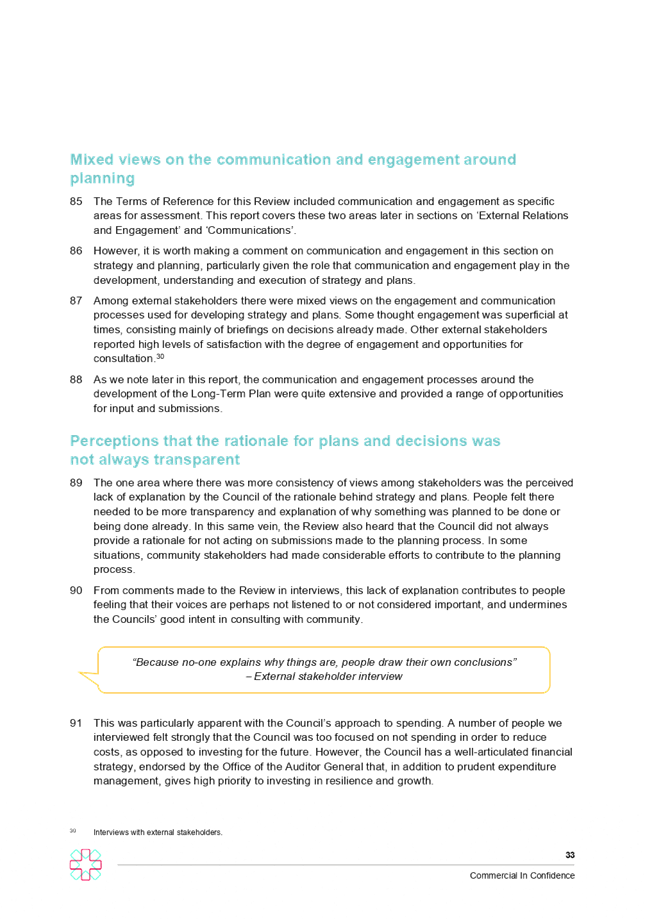

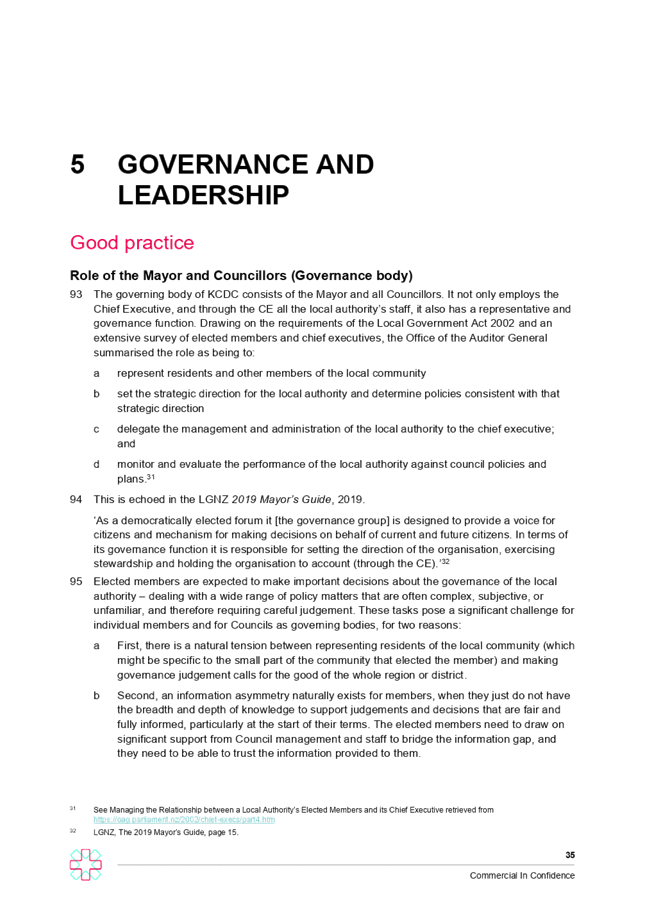
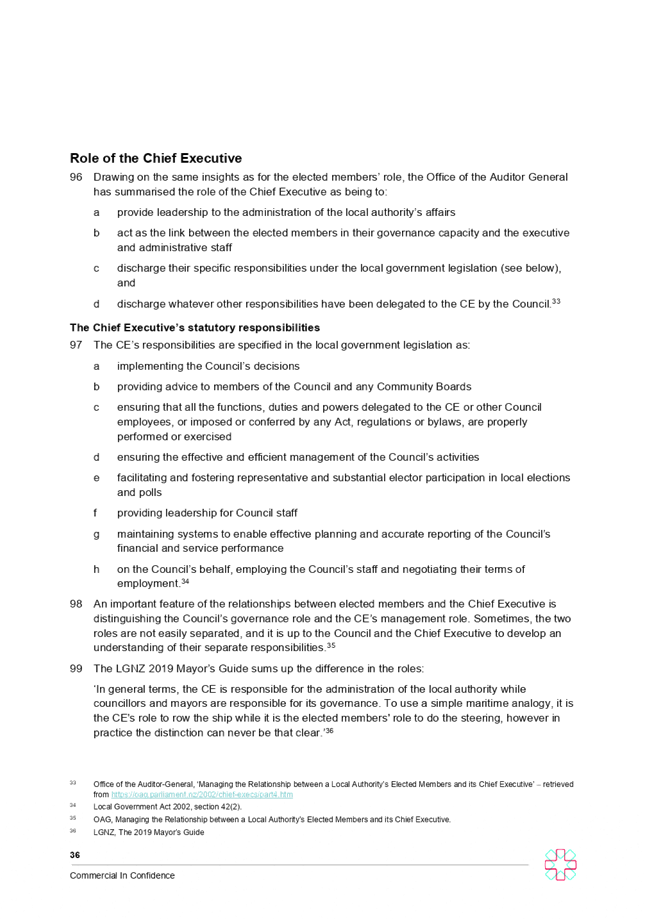

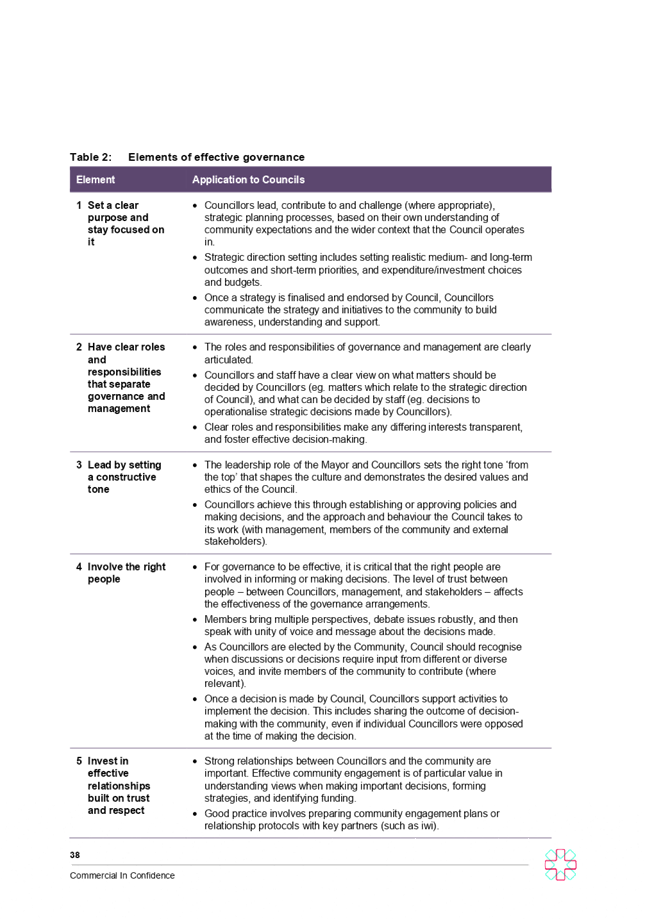
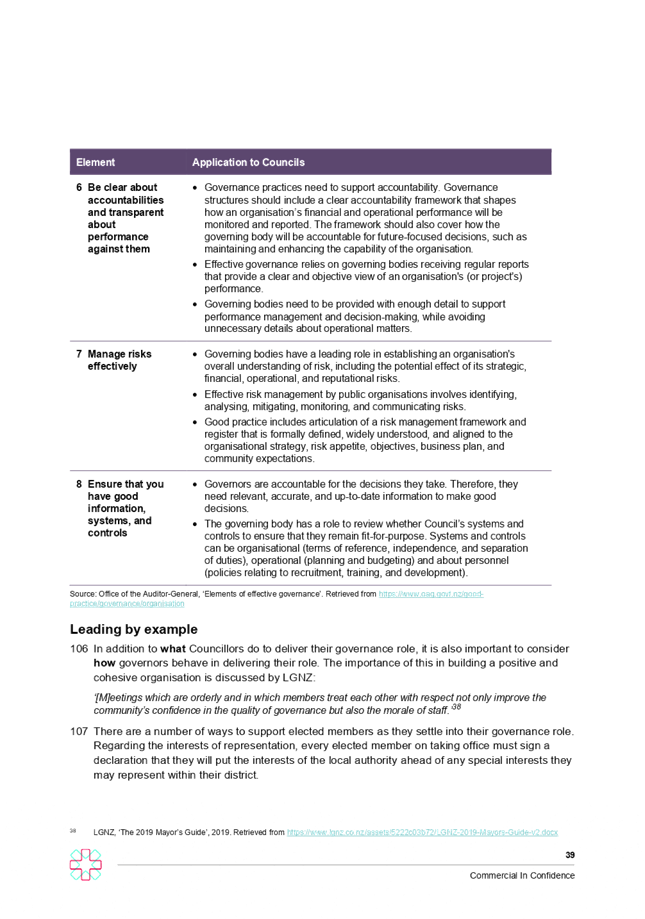
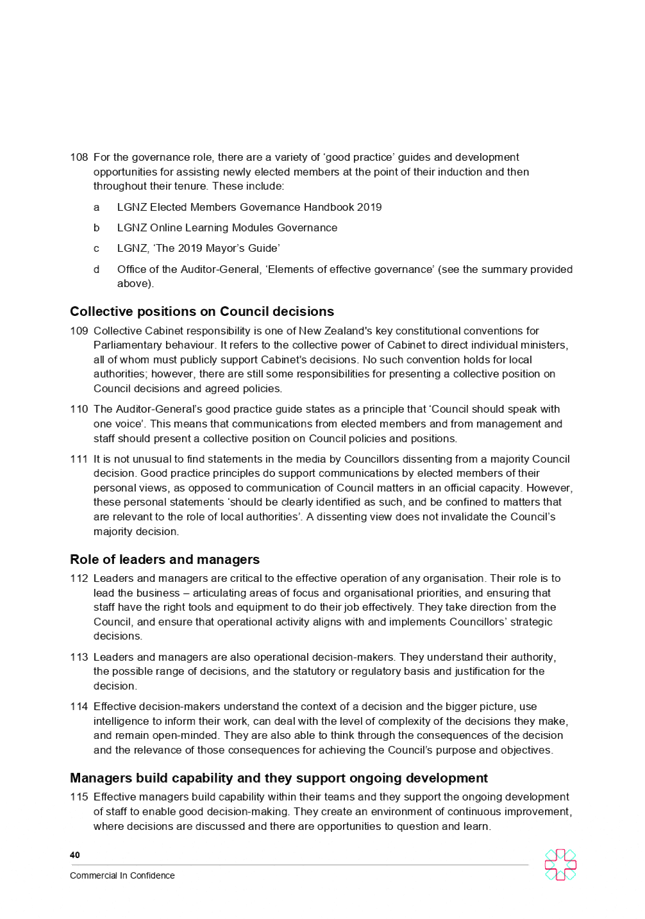
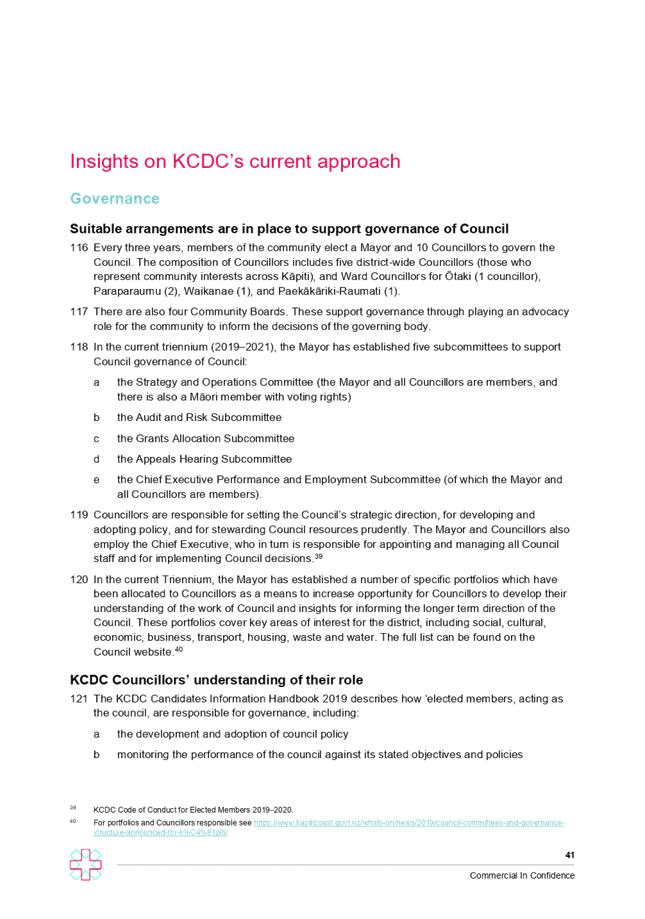
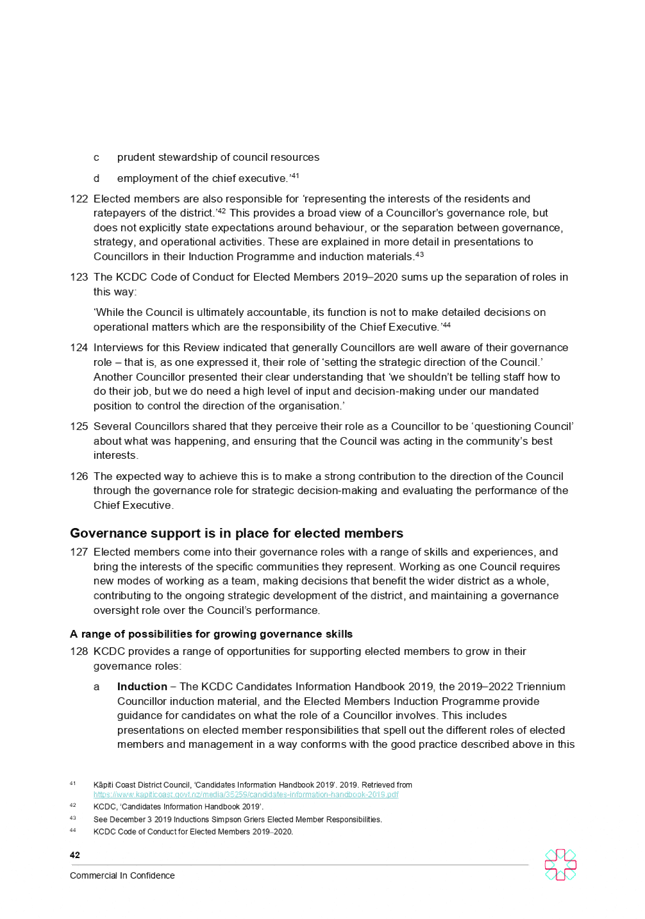
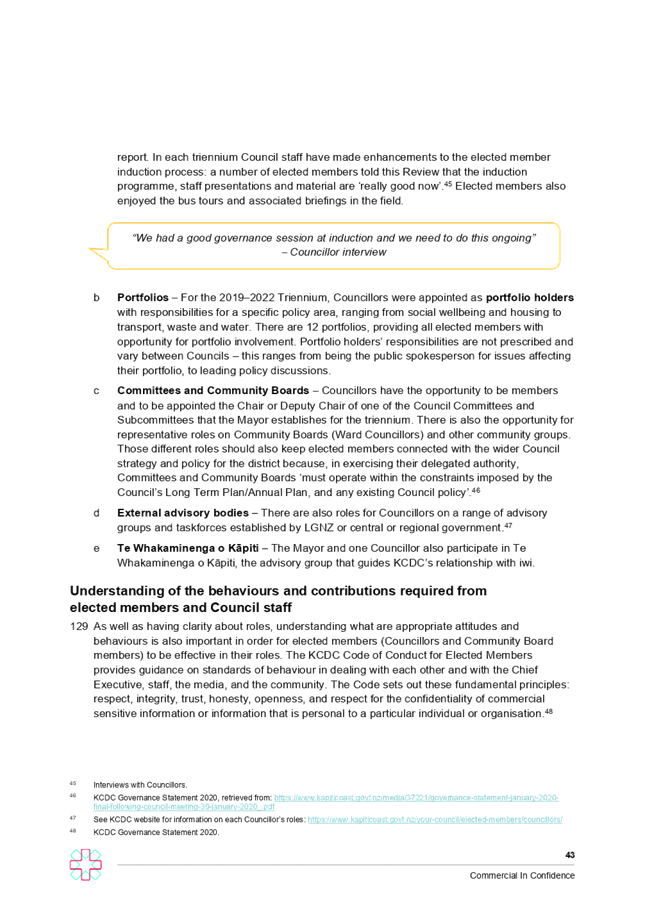
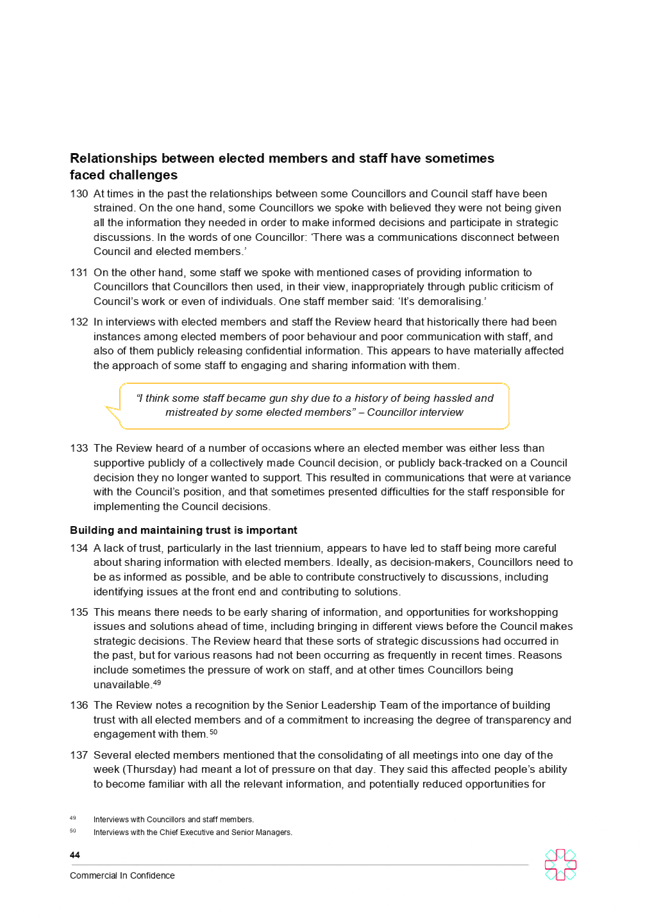

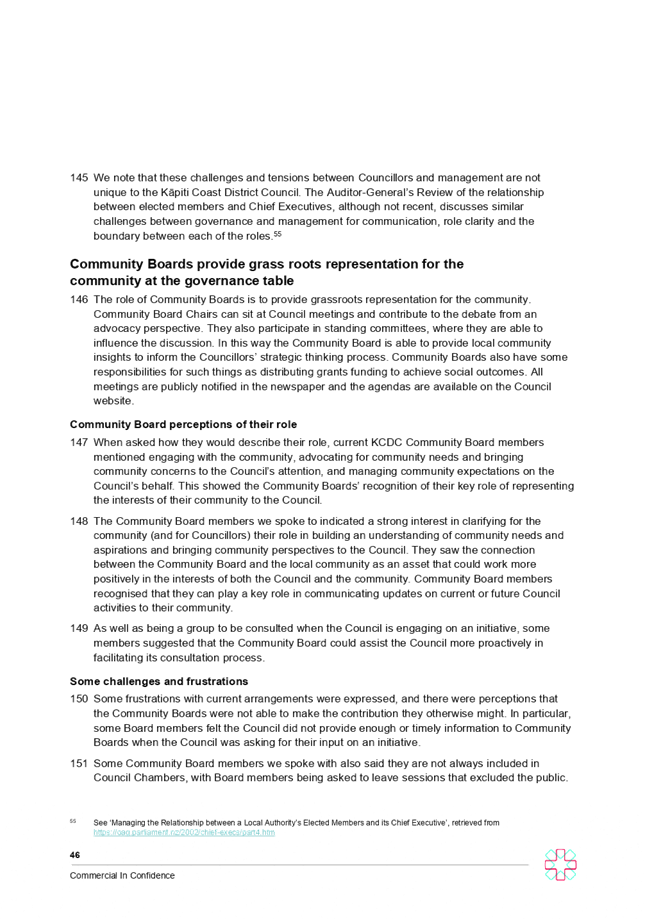

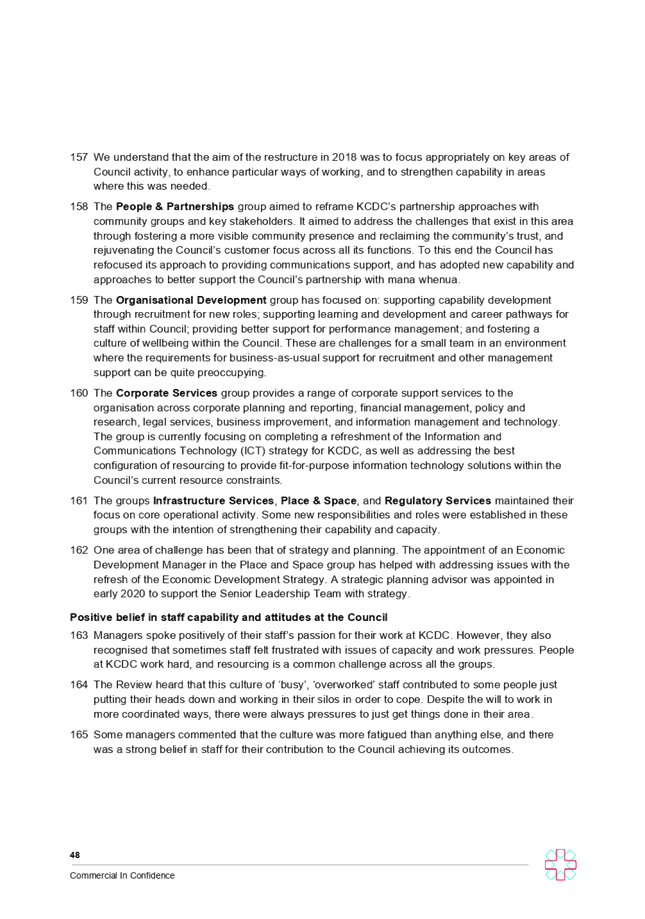


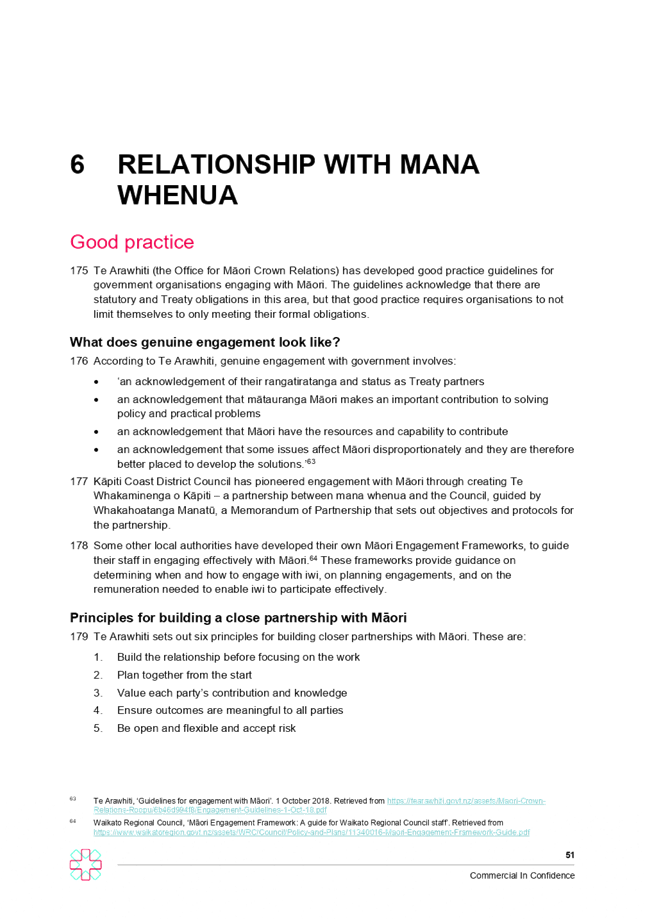
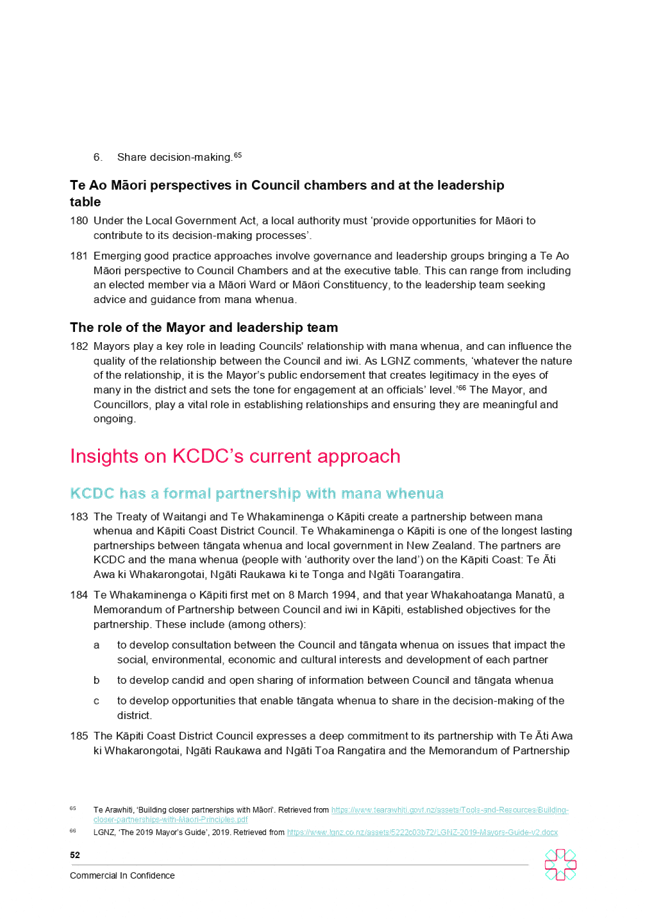
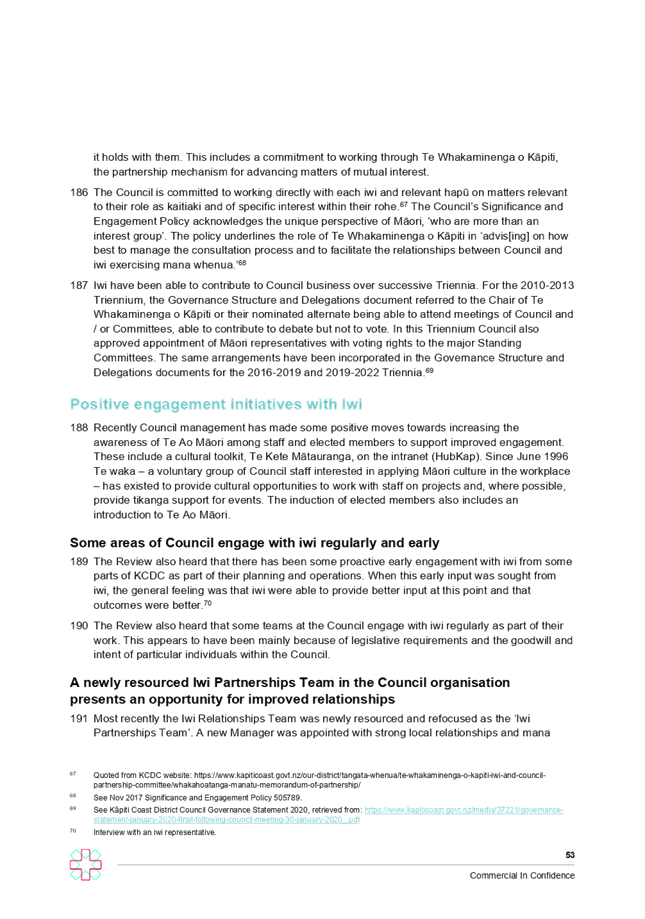
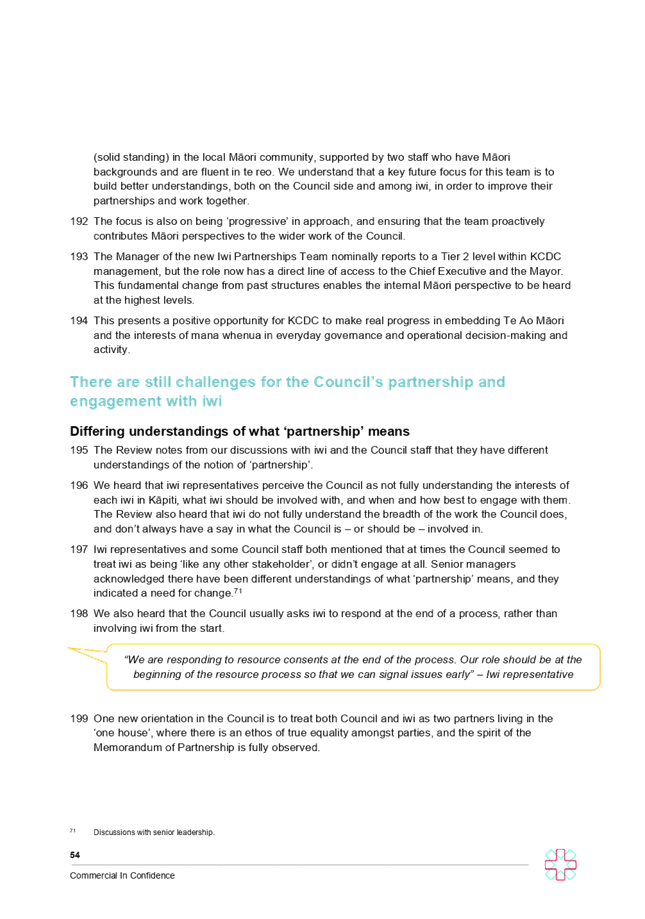

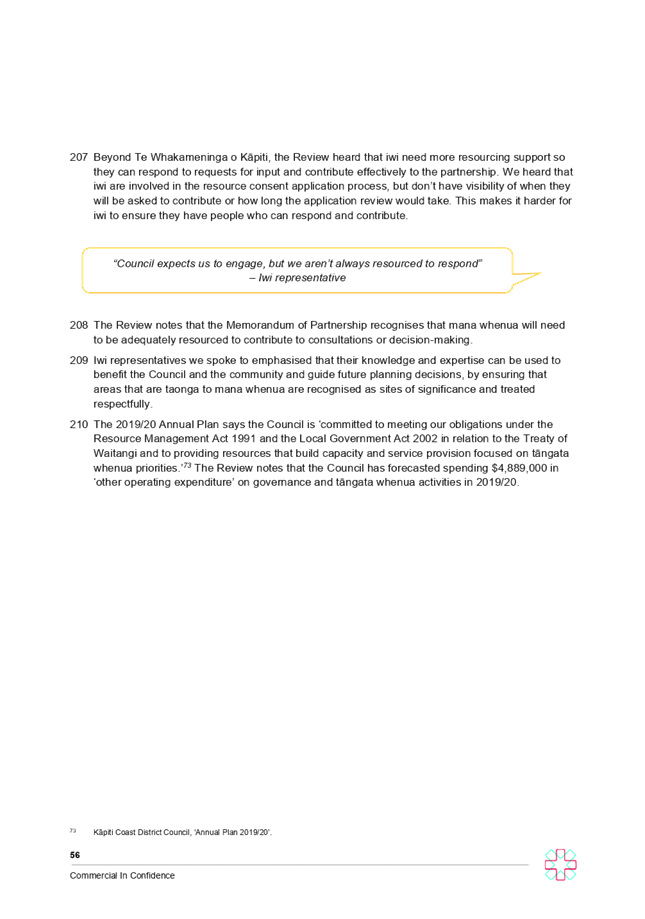
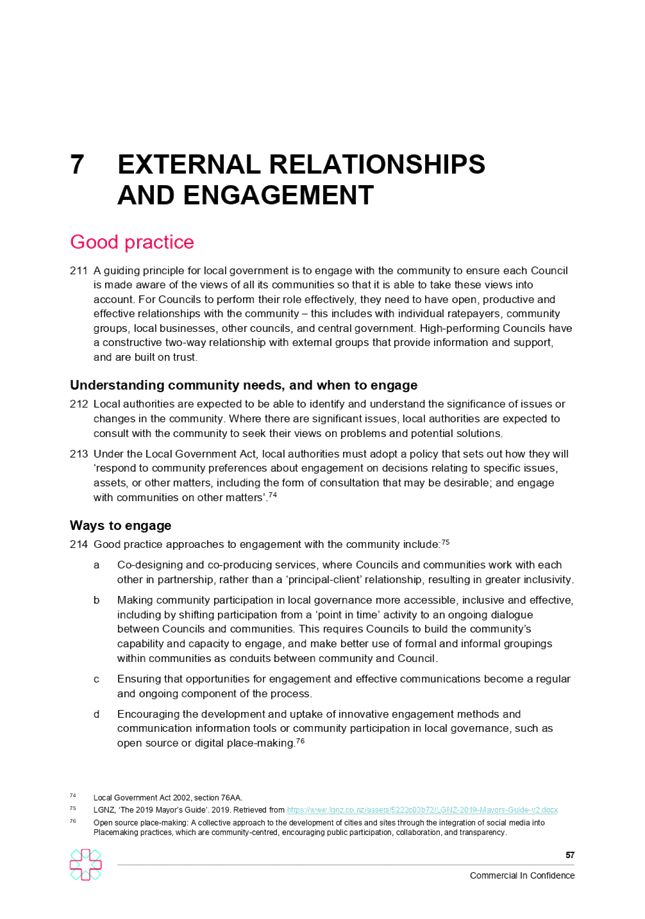
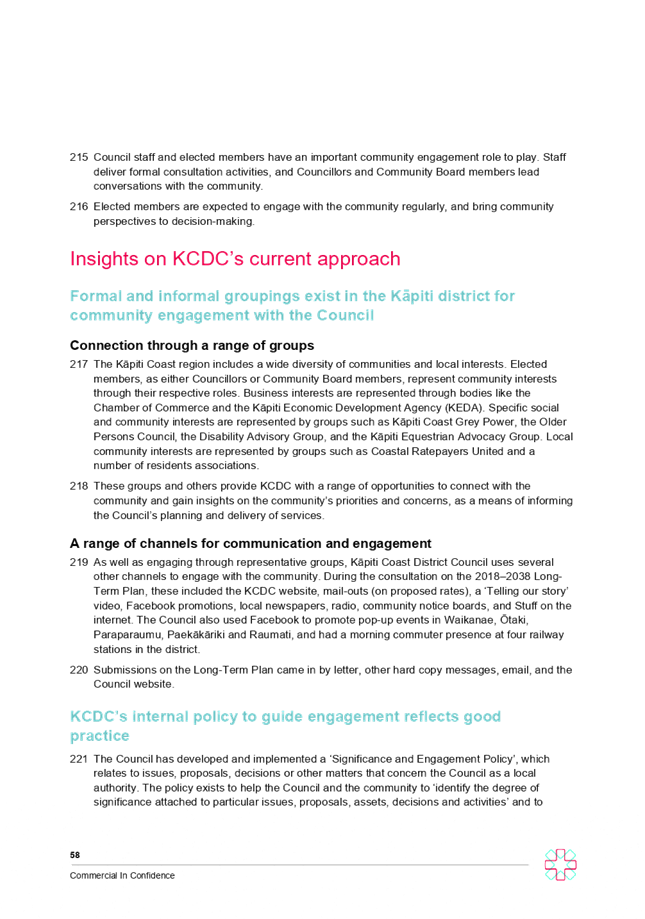
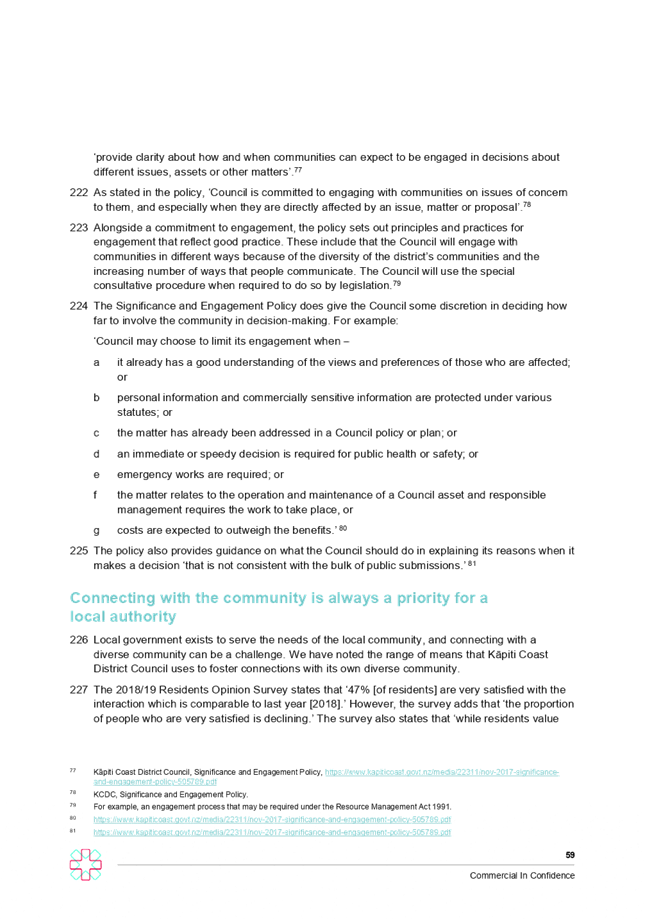
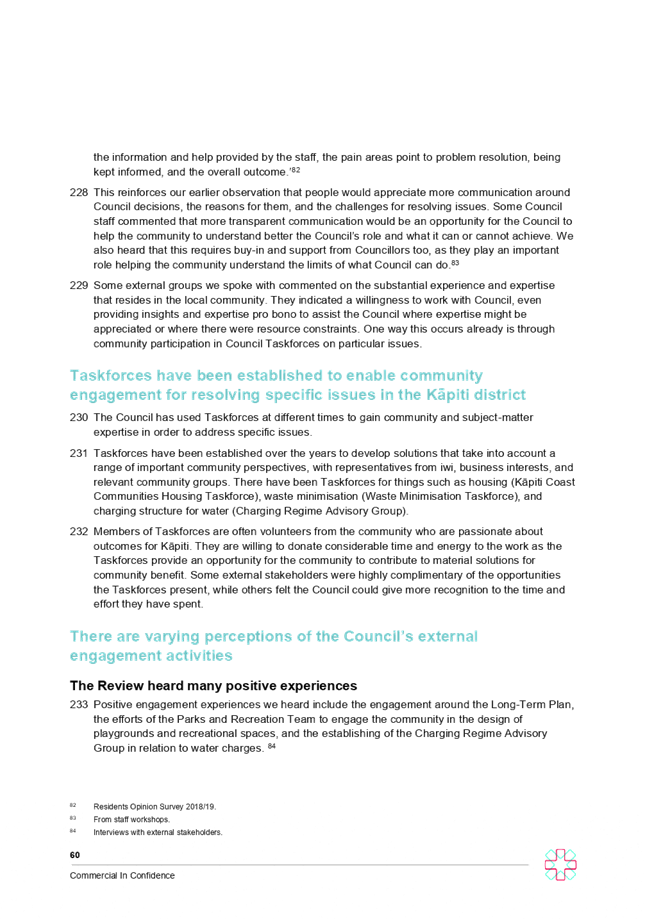
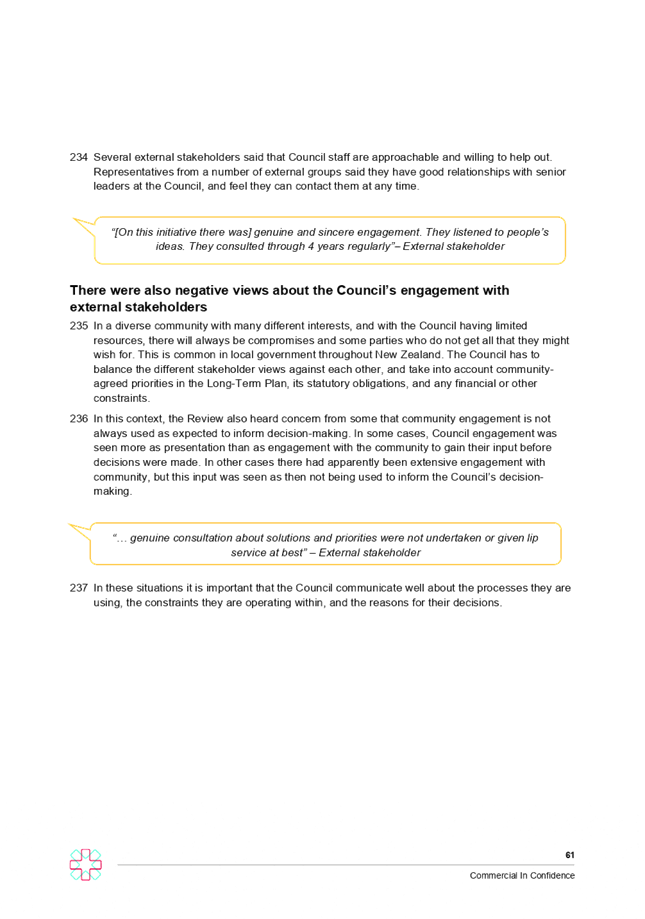
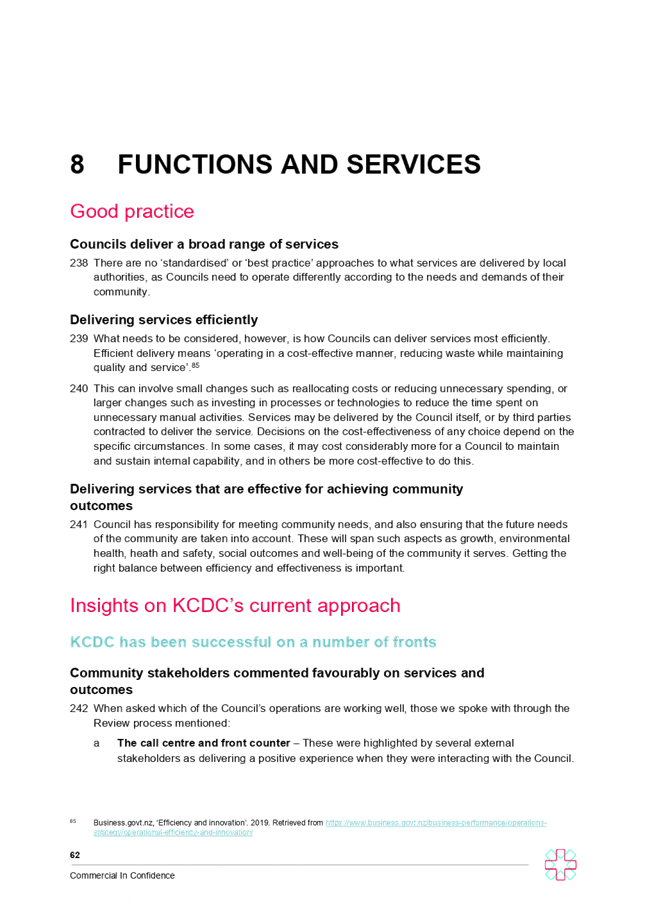
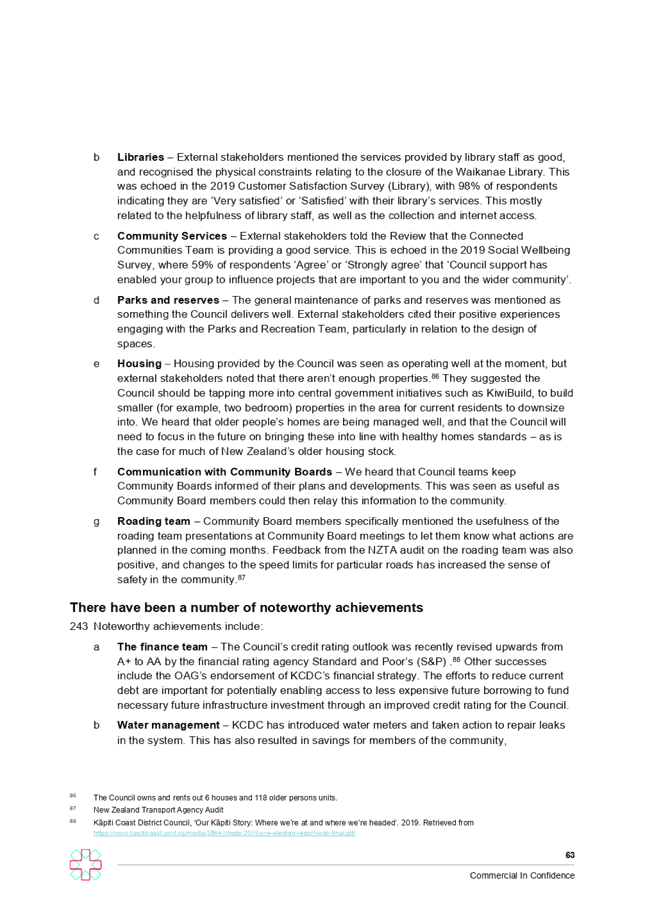
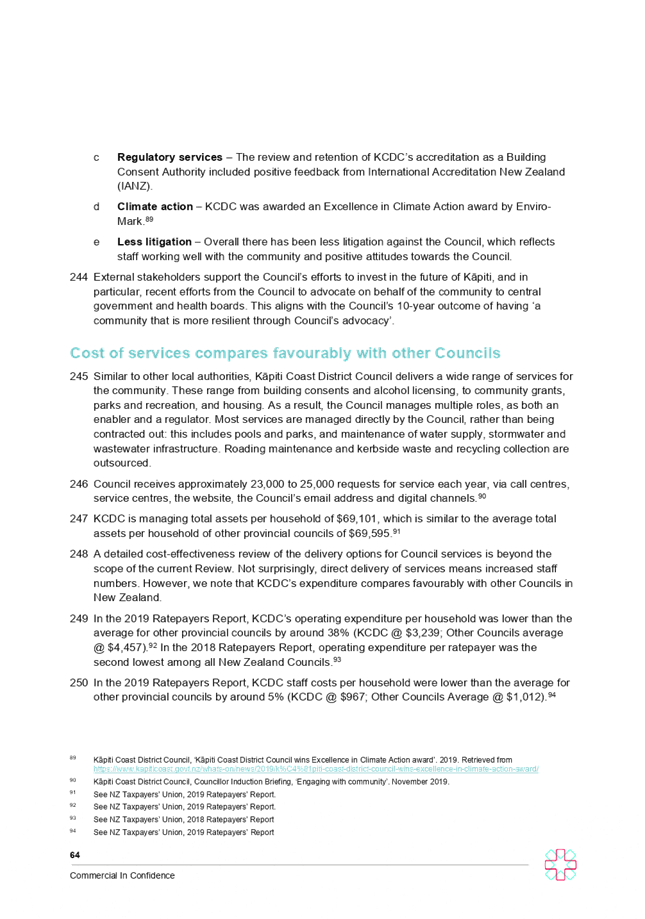
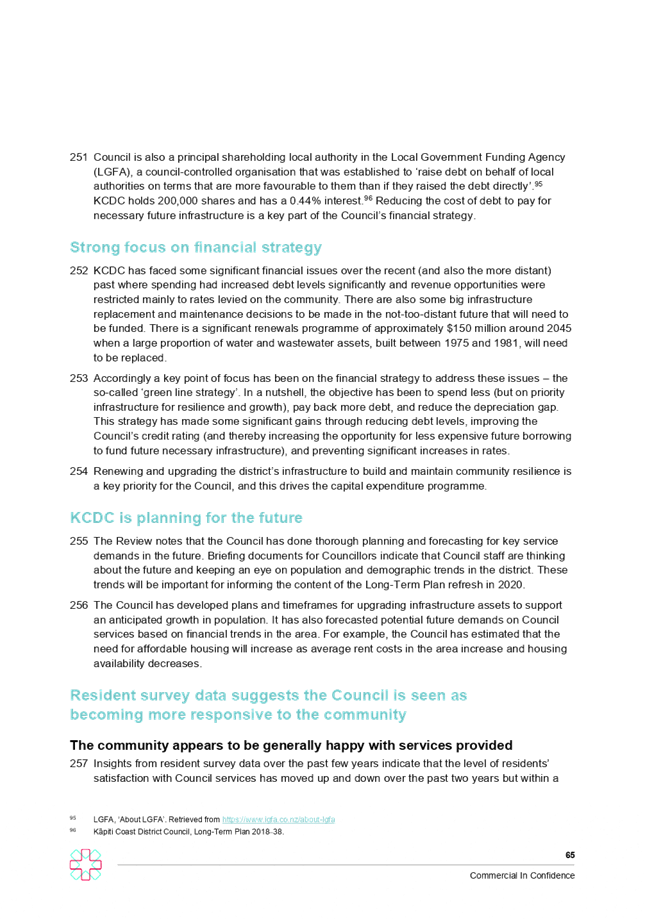

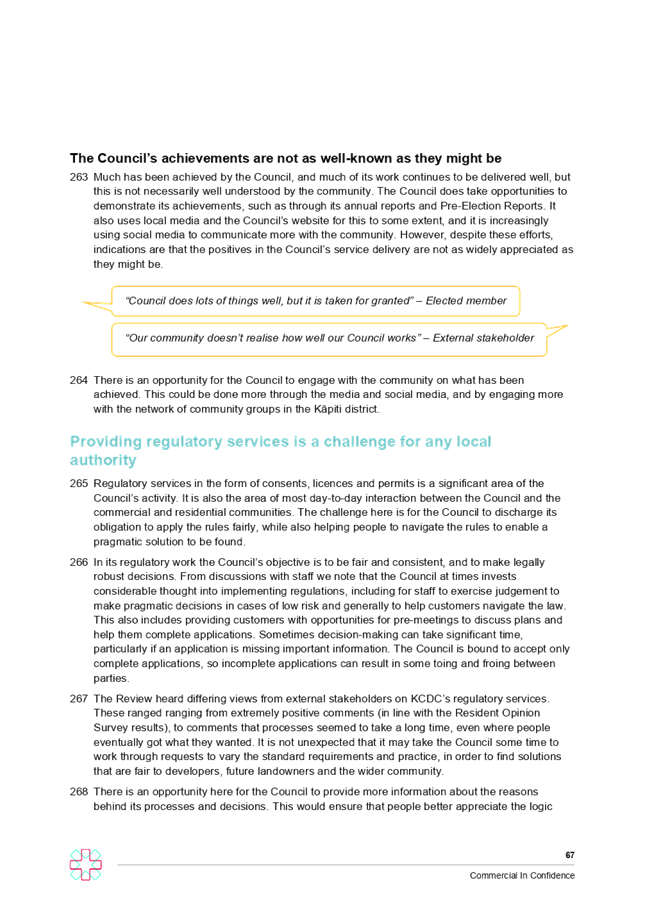

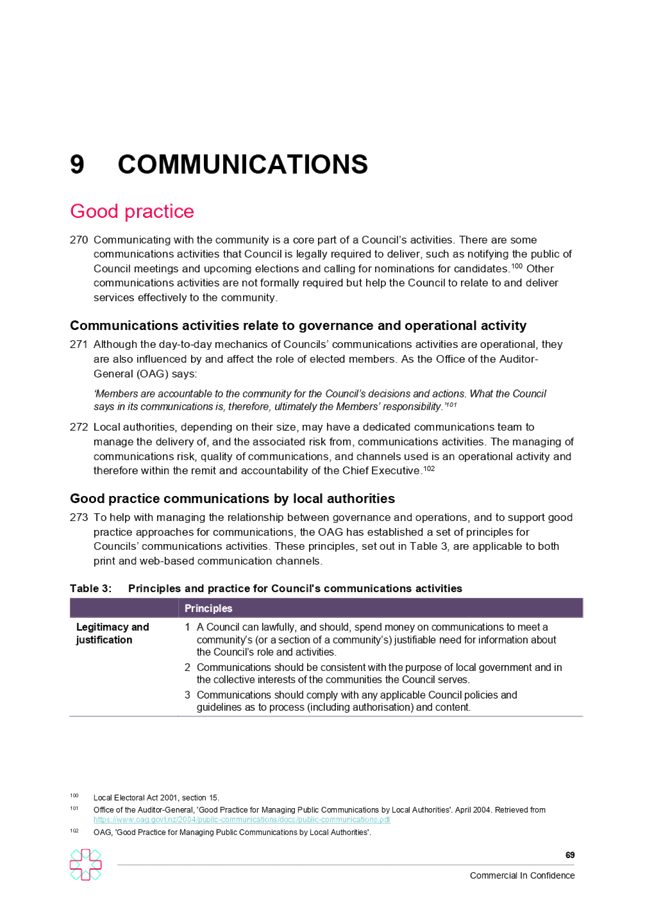
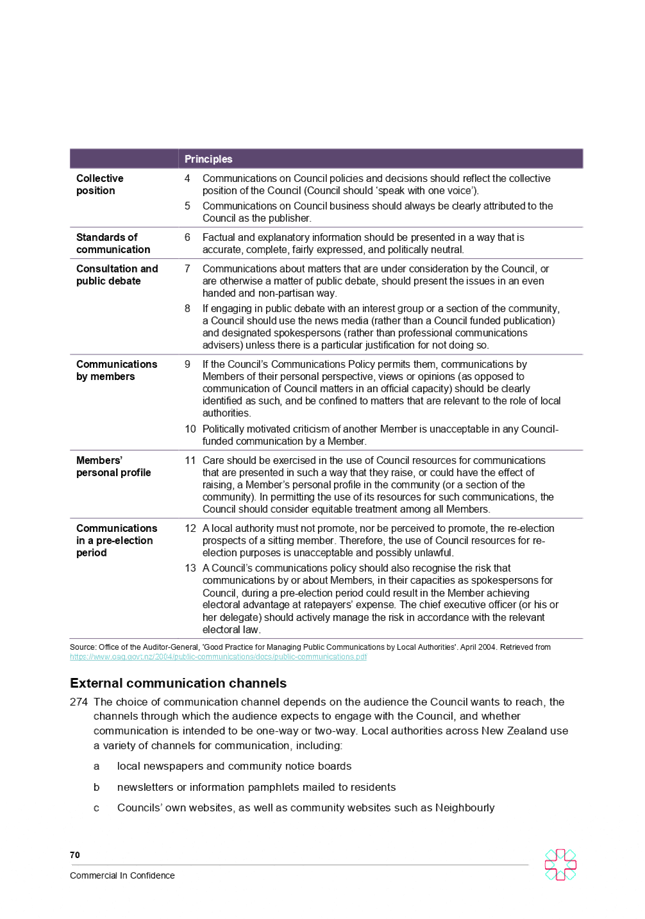
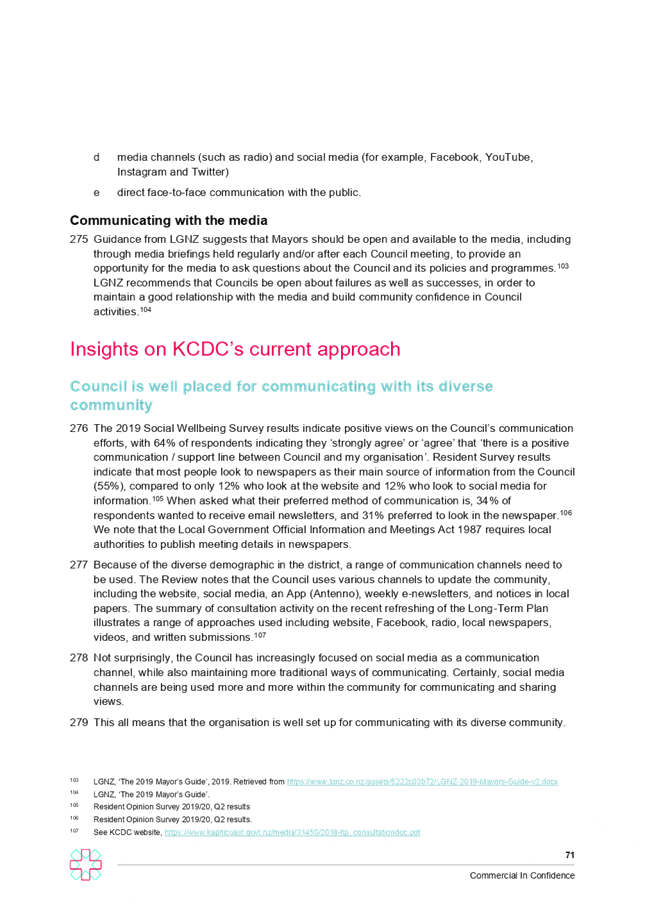



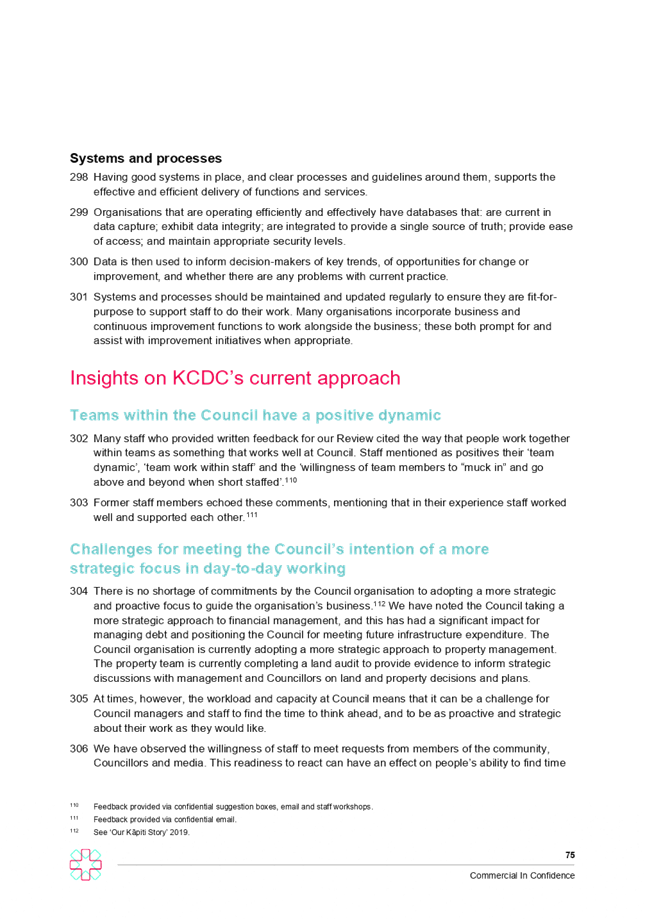
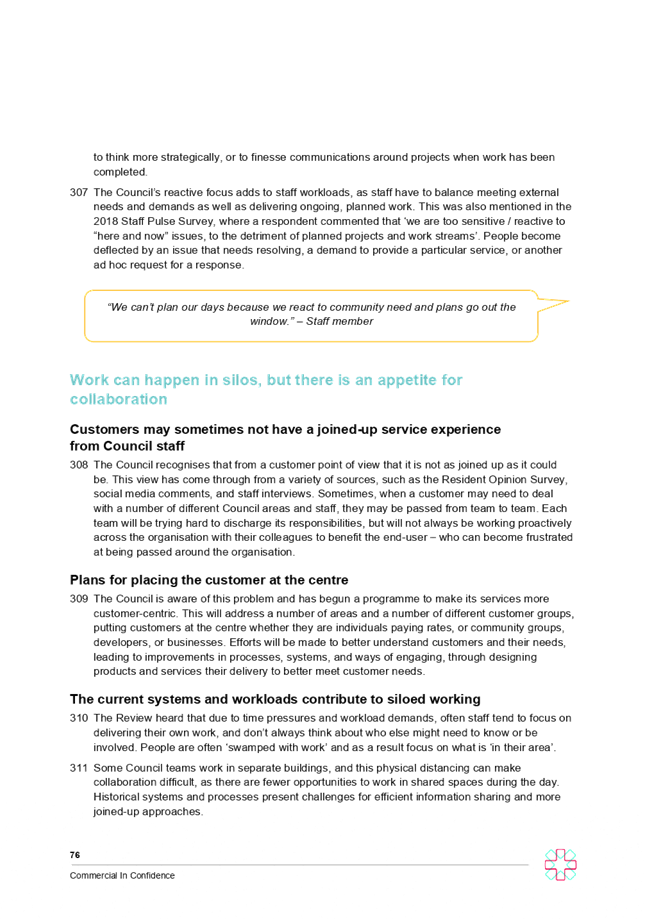


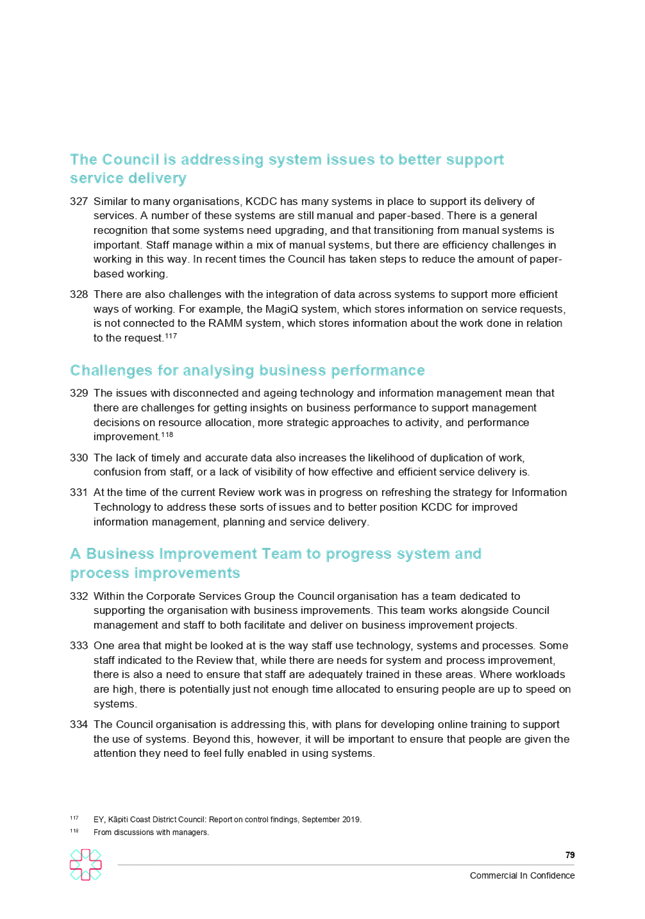


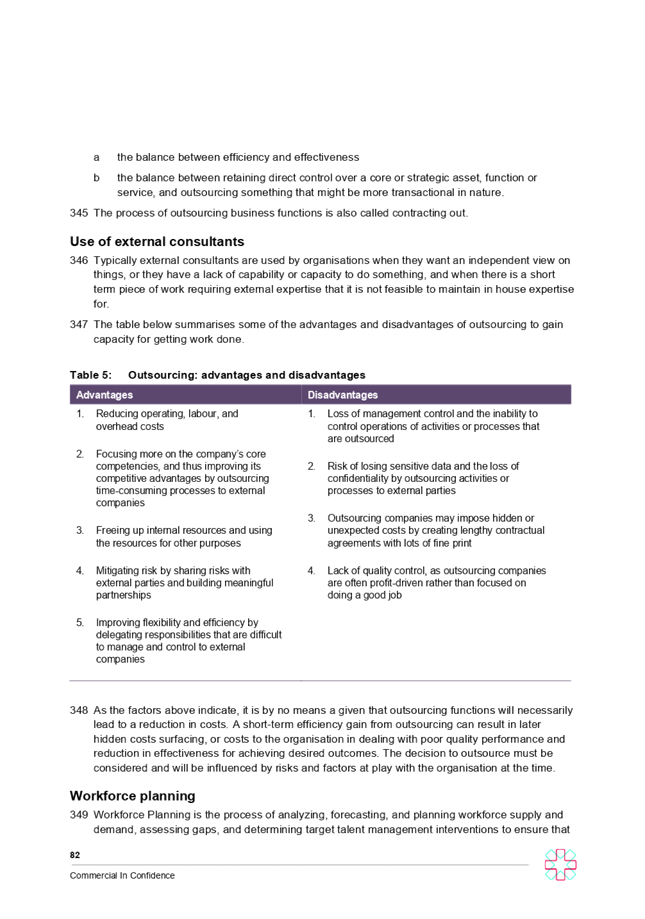
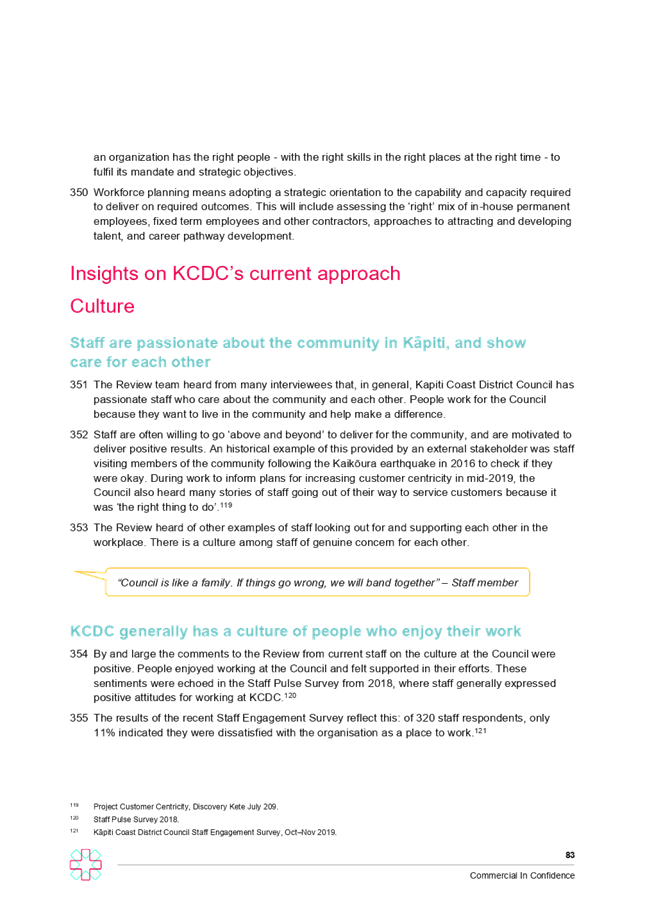
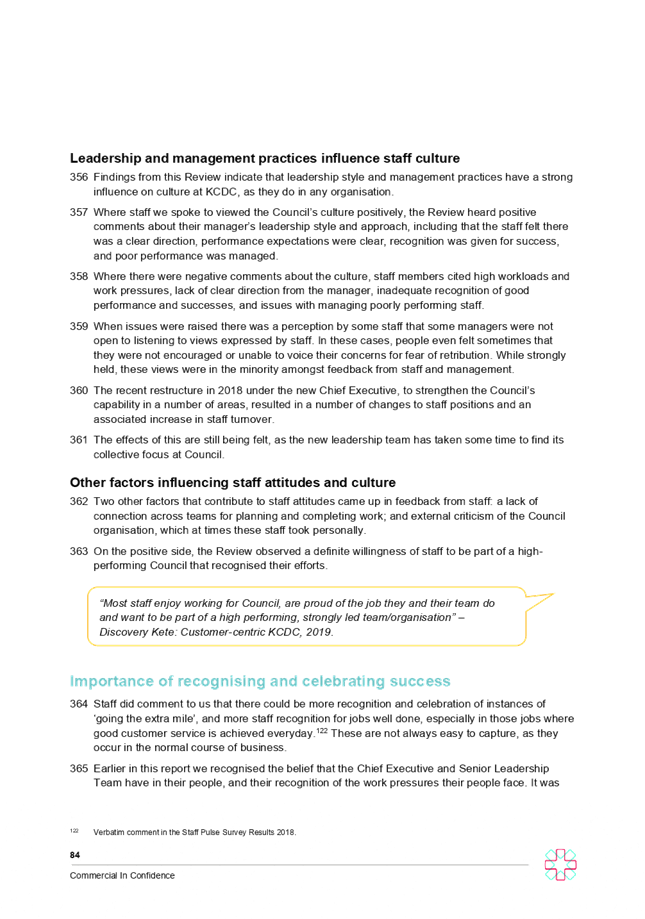

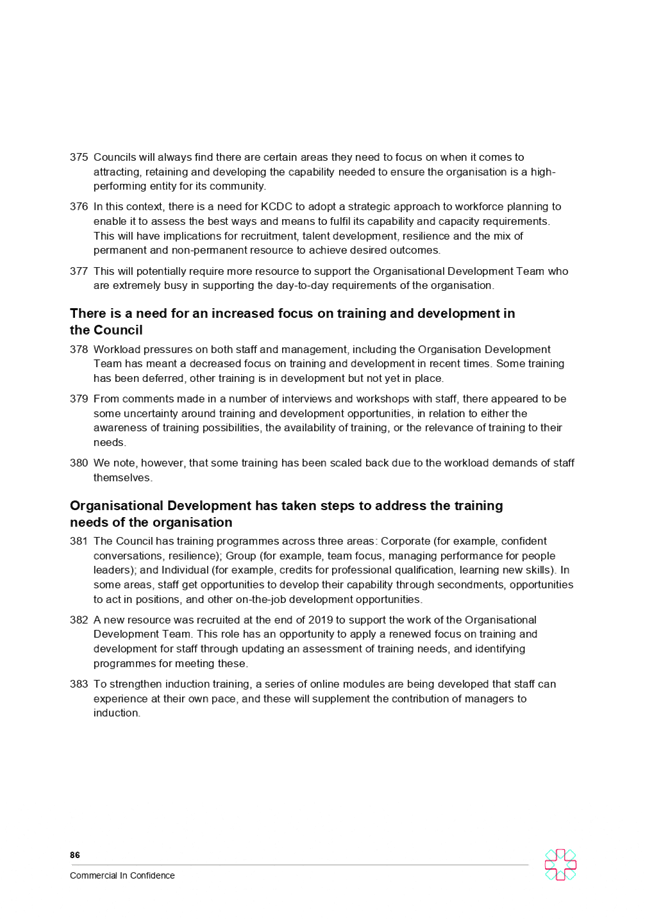

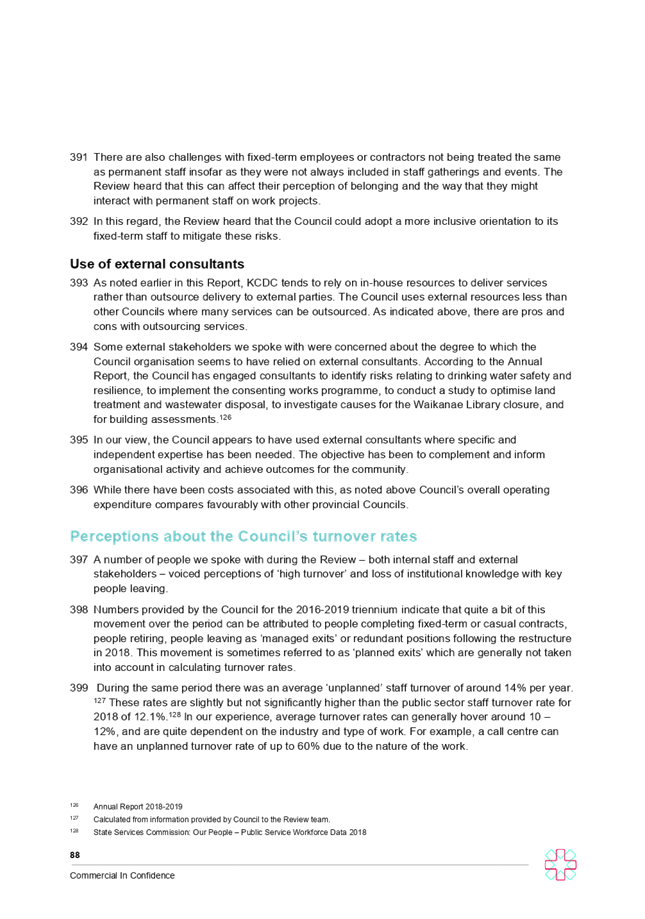


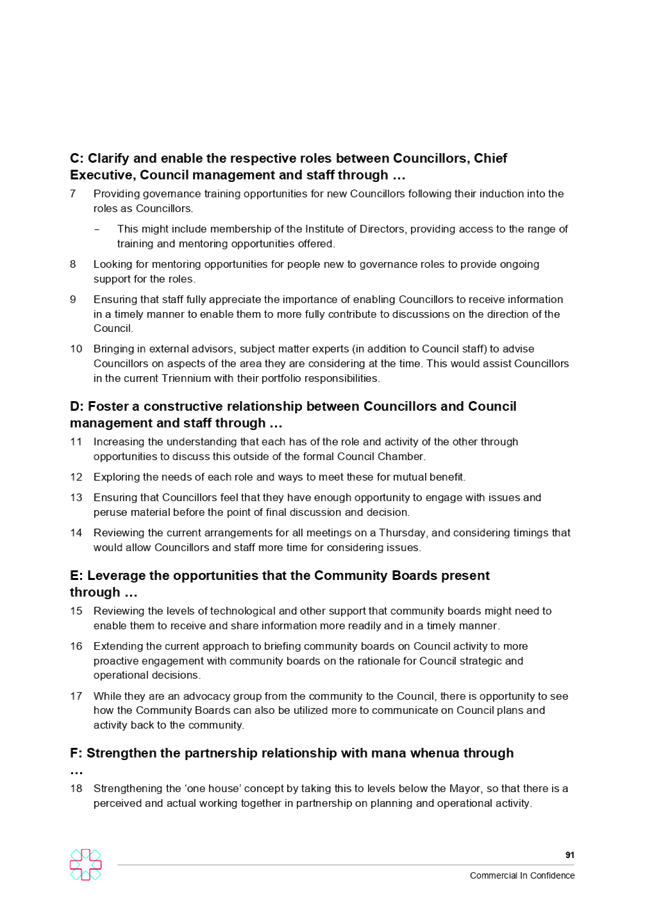
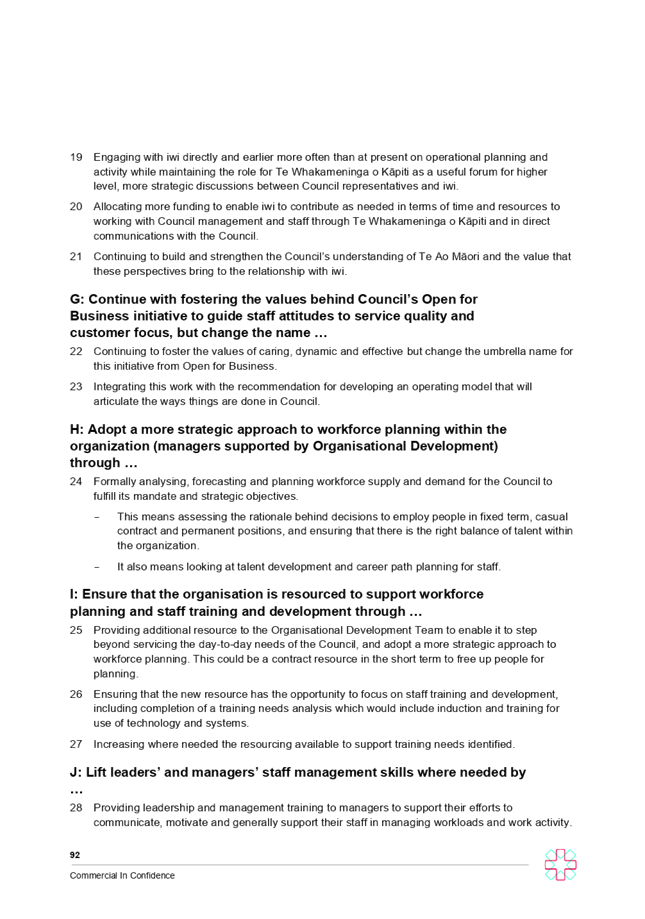

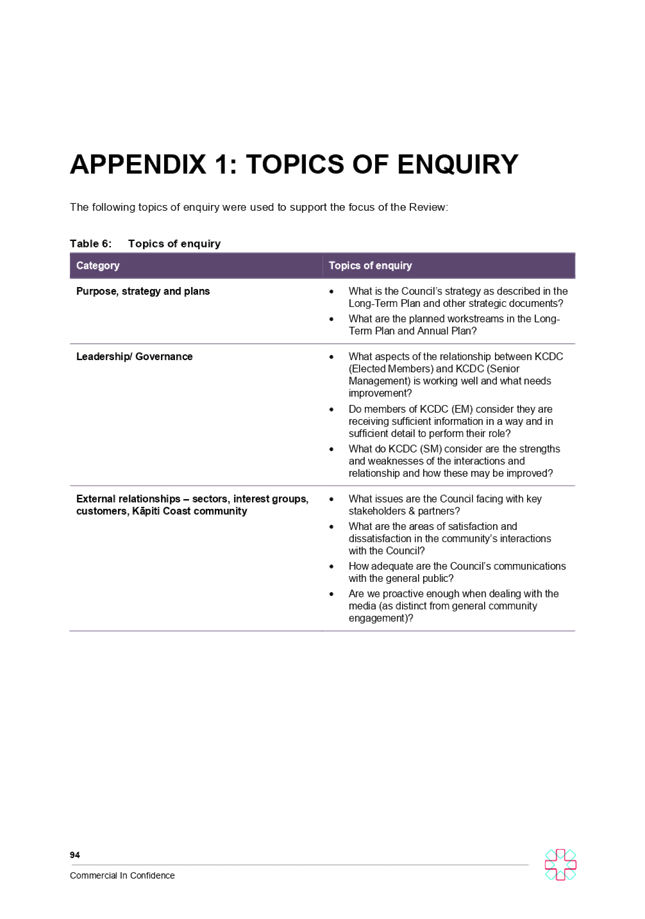
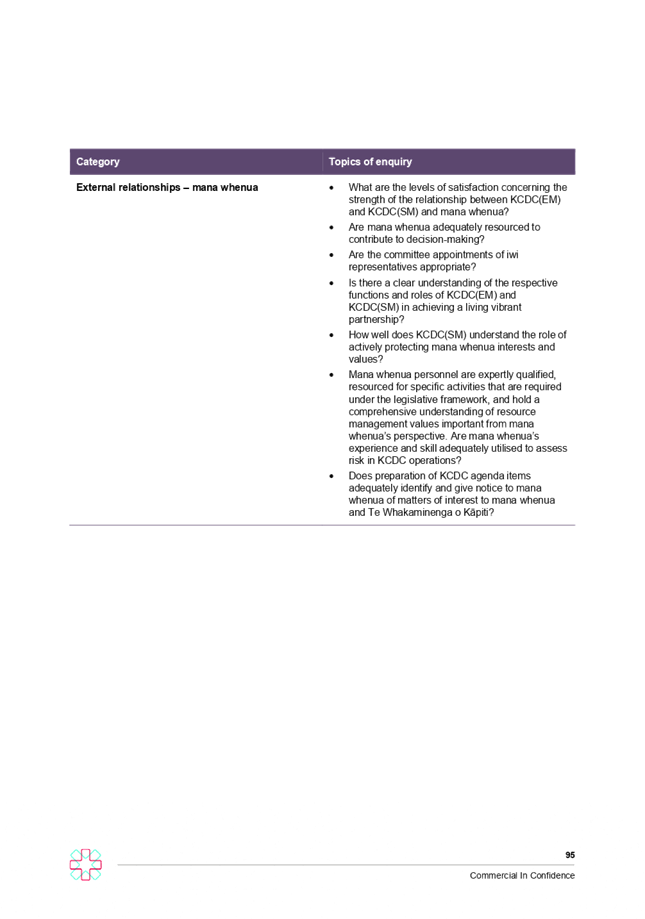
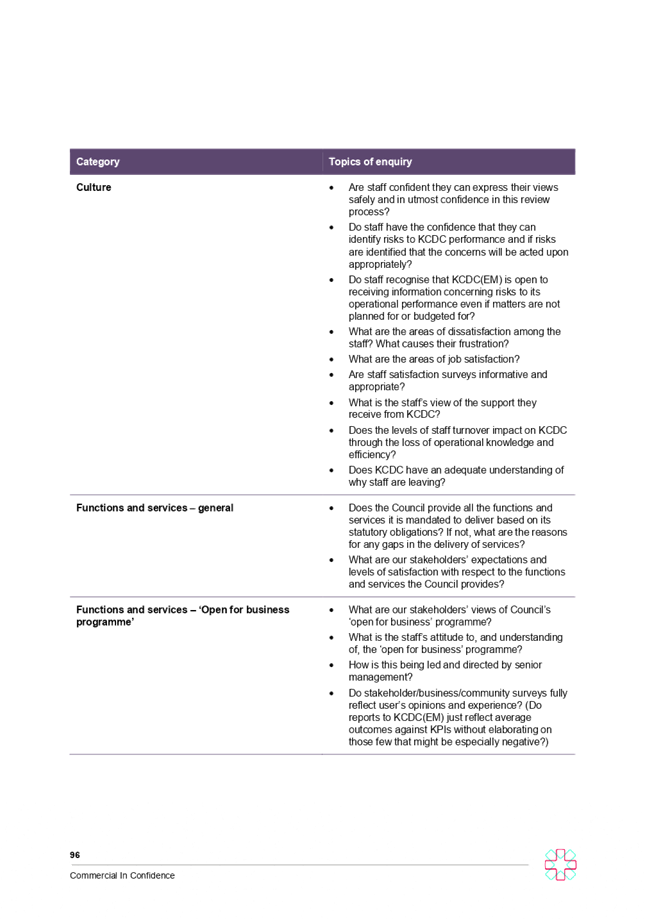
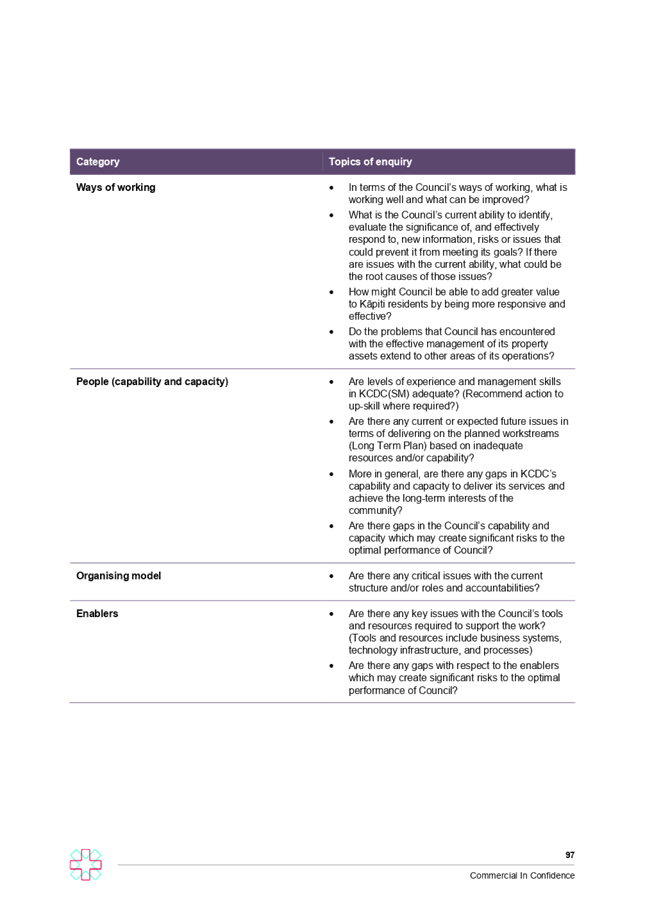
|
Additional Council Meeting Agenda
|
7 June 2022
|
7.2 Mana
whenua representation within Council's Governance Structure
Kaituhi |
Author: Sarah
Wattie, Governance & Legal Services Manager
Kaiwhakamana
| Authoriser: Janice McDougall, Group Manager People and Partnerships
Te pūtake |
Purpose
1 The
purpose of this report is to present options to Council to enhance mana whenua
representation on Council committees and subcommittees.
He
whakarāpopoto | Executive summary
2 Not
required.
Te tuku haepapa
| Delegation
3 Council
holds the delegation for this decision under section A.2 of the Governance
Structure and Delegations 2019-2022.
Taunakitanga | RECOMMENDATIONS
That the
Council:
A. Adopts
the recommended option to enhance mana whenua representation within
Council’s Governance Structure by:
A.1 appointing
one representative from Ngāti Toa Rangātira, Ngā Hapū o
Ōtaki and Ātiawa ki Whakarongotai Charitable Trust to:
A.1.1 the
Strategy and Operations Committee, Appeals Hearing Committee and the Grants
Allocation Subcommittee with full voting rights from 1 July 2021.
A.1.2 attend
all Council meetings and receive all papers, with the ability to contribute to
the debate but not vote.
A.2 appointing
one iwi representative to the Audit and Risk Subcommittee through a formal
recruitment and selection process based on relevant qualifications and
experience.
B. Agrees
to reimburse each Ngāti Toa Rangātira, Ngā Hapū o
Ōtaki and Ātiawa ki Whakarongotai Charitable Trust for the
contribution of their representatives as set out in recommendation A above, by
paying each iwi an annual fee, equivalent to the remuneration of a full-time
elected member (Portfolio B) which is currently $45,156.
C. Agrees
to reimburse the iwi representive appointed to the Audit and Risk Subcommittee
in accordance with Council’s non-elected member remuneration and expense
policy.
D. Notes
that while one person will be appointed to each committee and subcommittee from
each of Ngāti Toa Rangātira, Ngā Hapū o Ōtaki and
Ātiawa ki Whakarongotai Charitable Trust, the relevant person nominated by
iwi may be different for each committee or subcommittee.
E. Notes
that a number of actions will be undertaken by staff to implement the above
resolutions including a letter of appointment to be signed between the Council
(via Common Seal) and each iwi representative.
F. Notes
that the representatives nominated by mana whenua for each committee and
subcommittee will be brought to Council for formal appointment to the relevant
committee(s) as required by the Local Government Act 2022.
G. Agrees
to amend Council’s Governance Structure and Delegations 2019-2022
document as follows:
G.1 Amend
the membership so that one representative from Ngāti Toa Rangātira,
Ngā Hapū o Ōtaki and Ātiawa ki Whakarongotai Charitable
Trust is appointed to:
G.1.1 the
Strategy and Operations Committee, Appeals Hearing Committee and the Grants
Allocation Subcommittee with full voting rights.
G.1.2 attend
all Council meetings and receive all papers, with the ability to contribute to
the debate but not vote.
G.2 Amend
the membership of the Audit and Risk Subcommittee so that one iwi
representative may be appointed through a formal recruitment and selection
process.
G.3 Part
A Section A.1 Partnership Model – paragraph 7 and 8 be replaced with:
“Appointed mana whenua
representatives are members of the Strategy and Operations Committee, Appeals
Hearing Committee and Grants Allocation Subcommittee. They are full members to
these committees and subcommittees with the rights to participate, debate and
vote.
Appointed mana whenua
representatives have the right to attend all Council meetings and contribute to
the debate but not vote. Iwi are to receive all papers relating to Council as
well the committees and subcommittees for which they are appointed. Where an
iwi has submitted to Council on an issue, or has spoken during public speaking
time, the Council iwi representative shall not participate in discussion or
debate on that matter.
The Kāpiti Coast District
Council Code of Conduct for Elected Members will apply to all members during
meetings.”
G.4 The
quorum for meetings be updated as set out in Attachment 1.
Tūāpapa | Background
4 In
recognition of the Crown’s responsibility under Te Tiriti o Waitangi, the
Local Government Act 2002 sets out principles and
requirements for Council to facilitate Māori participation in all
decision-making processes, which includes appropriate consultation with
Māori on different issues (refer section 4, Parts 2 and 6 of the Local
Government Act 2022).
5 Kāpiti
Coast District Council has a history of Māori representation and input
into matters of local governance.
6 Since
1994, Council has been party to a Memorandum of Partnership
with the three local iwi and hapū on the Kāpiti Coast District represented
by Te Rūnanga O Toa Rangātira (Ngāti Toa
Rangatira), Ngā Hapū o Ōtaki and Ātiawa ki Whakarongotai
Charitable Trust. The Memorandum of Partnership sets out principles and
objectives to ensure an effective and meaningful partnership between Council and
iwi. The partnership is reflected in Council’s Governance Structure and
Delegation at A.1.
7 Te
Whakaminenga o Kāpiti was established as the independent advisory forum
for the partnership consisting of a representative of each of Council’s
iwi partners. The forum was intended to strengthen iwi capacity to manage and
maintain mana whenua interests in the district, providing an opportunity to
exchange views on issues that impact on the social, environmental, economic and
cultural wellbeing of tangata whenua.
8 In
September 2017, Ātiawa ki Whakarongotai Charitable Trust commenced an
independent review of their partnership with Council and signalled their
intention to withdraw from Te Whakaminenga o Kāpiti. On 24 November 2019,
Ātiawa ki Whakarongotai Charitable Trust formally withdrew from Te
Whakaminenga o Kāpiti with the result that the forum is not currently
representative of all mana whenua in the district.
9 The
MartinJenkins independent organisational review dated June 2020, identified
Council’s deep commitment its partnership with iwi, along with challenges
in Council’s partnership and engagement with iwi including through Te
Whakaminenga o Kāpiti. The review found iwi are not always adequately
resourced to participate and engage with Council and recommended that more
funding be allocated to facilitate iwi contribution at different levels of
Council. As an outcome of the review, Council agreed to a focus area of
“strong and effective partnerships between elected members, iwi and
management” along with specific actions to realise this, including:
9.1 initiating
a conversation with iwi partners on aspirations of partnership and
opportunities to strengthen this
9.2 initiating
a formal review of Te Whakaminenga o Kāpiti
9.3 working
with iwi partners to develop an approach to more appropriately resource iwi to
participate in the work of Council.
10 Council
recently considered whether to provide for Māori representation within its
representation model. On 29 October 2020 and 6 May 2021, Council considered whether
to establish a Māori ward under section 19Z and Schedule
1A of the Local Electoral Act 2001. Council, guided by the advice of all three
iwi partners, resolved not to establish a Māori ward ahead of the upcoming
2022 local body elections. Iwi expressed their desire to continue discussions
on the matter in the next triennium, and to focus on strengthening their
partnership with the Council in the meantime.
11 Māori wards are just one way to provide for Māori
representation in governance. Council’s current governance structure
allows for the appointment of a Māori representative to the
Strategy and Operations Committee. Consistent with the approach taken by other
local authorities in New Zealand, there are different ways that Council can
strengthen Māori participation in Council’s decision-making
processes. One of these is through Council’s governance structure. This
paper explores the possibilities available to Council in this respect.
He
kōrerorero | Discussion
He
take | Issues
12 Council’s Memorandum of Partnership between Council and mana
whenua states: “the Council and the tangata whenua believe the Treaty of
Waitangi to be a solemn compact between the Crown and the Māori people.
The Treaty signifies a partnership and its principles require the Treaty
partners to act towards each other reasonably and with the utmost good
faith”. The agreement establishes the goal “to forge a relationship
of mutual benefit between the Kāpiti Coast District Council and the
tangata whenua that will develop into an effective partnership,” and a
number of objectives and principles to this effect.
13 Council has been engaging with each of its iwi partners
around actions and measures that each see as critical to give effect to the
partnership between Council and iwi, and strengthening the voice for mana
whenua at a governance level has been a particular focus for the Mayor and
Councillors this triennium. This is particularly evident in the much stronger
reflection of mana whenua values, perspectives and priorities in the strategic
direction set by Council through the Long-term Plan 2021-41, as well as a significant increase to the iwi capacity funding budget.
One of the five community outcomes sought from the activities included in the
plan is: Mana Whenua and Council have a mutually mana-enhancing partnership.
14 More recently the Mayor and Councillors have been committed
to creating space for mana whenua within the Council Chamber, with a number of
invitations for iwi representatives to join them for meetings, briefings and
workshops. But in the absence of a clearly defined role within the governance
structure and adequate resourcing to enable iwi participation, these
opportunities remain largely adhoc.
15 Ātiawa ki Whakarongotai Charitable
Trust, in its review of its partnership with Council, identified the following findings relevant
to Council’s governance arrangements:
15.1 reinstate a direct relationship between
the governance of Ātiawa ki Whakarongotai Charitable Trust and Council
15.2 consolidate Ātiawa ki Whakarongotai
Charitable Trust representation across Council standing committees, joint
committees and other external bodies
15.3 reinstate Te Whakaminenga o Kāpiti to
its original role guiding Council consultation at the right level.
16 To give effect to these findings, the
Ātiawa ki Whakarongotai Charitable Trust review made the following
recommendations:
16.1 that
KCDC provide the ability and resource for the Chair or other appointed
representative of Ātiawa ki Whakarongotai Charitable Trust Board to attend
and contribute to Council and enable the upholding of the partnership.
16.2 that
KCDC provide resourcing to enable operational support to governance
representation at Council level
16.3 Ātiawa
ki Whakarongotai Charitable Trust consolidate their representation on these
other groups by way of as few resourced individuals as possible.
17 Council’s
Iwi Partnerships team have engaged with Ngā Hapū o Ōtaki and
Ngāti Toa Rangatira on these findings and proposed measures to strengthen
iwi participation at a governance level, who have provided indicative support
for enhanced representation at this level.
Legislative
provisions
Elected members to Council
18 Under
sections 5 and 41(2) of the Local Government Act 2002, the membership of
Council is restricted to members who are elected in accordance with the Local
Electoral Act 2001. Māori representation at Council is possible through the election of candidates to one or more Māori wards
or indeed through the election of Māori candidates to general wards. While
non-elected members cannot be appointed to Council with full voting rights,
they are able to attend Council meetings and participate.
Community Board members
19 The membership of Community Boards is also limited under the Local
Electoral Act 2002 and while there is provision for appontments (section 19F),
these must comprise Councillors elected from the relevant ward.
Council’s committees and
subcommitees
20 Council is able to appoint mana whenua representatives to its
committees and subcommittees with full voting rights.
21 Under
clause 32 of Schedule 7 the Local Government Act 2022, Council may delegate its
functions to committees and subcommittees except those expressly prohibited by
the Act. In addition, under
clause 31 of Schedule 7, Council may appoint non-elected members to its
delegated committees and subcomittees, provided those members have “the
skills, attributes or knowledge [to] assist the work of the committee or
subcommittee”. In considering any appointment, consideration should be
given to the purpose of the particular committee or subcomittee to ensure the
effectiveness and efficiency of the particular decision-making body.
Ngā
kōwhiringa | Options
22 The inclusion of mana whenua representatives within Council’s
governance structure provides mana whenua representatives with a direct voice
within Council governance processes. It is therefore one way to provide for
Māori participation in Council decision-making processes, as required
under the Local Government Act 2022, and to strengthen the partnership between
Council and mana whenua.
23 This
report proposes changes to Council’s governance framework for the
remainder of this triennium to increase mana whenua representation across
Council’s governance functions, to achieve the following objectives:
· representation
for each of Council’s three iwi partners on Council and its committees
where practical
· voting
rights for iwi representatives where possible (noting legislative restrictions)
· remuneration
for iwi representatives on comparable terms to current councillors
24 When
the new Council is elected in October 2022, they will need to consider this
matter afresh.
25 A
summary of the proposal is set out in the table below, with further detail on
the recommendations set out in the subheadings that follow.
Table 1: Summary Proposal
|
Kōwhiringa |
Options
|
Tūāhua | Description
|
Hua & Tūraru |
Benefits & Risks
|
|
Option 1 (recommended)
· Iwi
representatives participate at Council and appointed to key committees and
subcommittees - Strategy and Operations Committee, Appeals Hearing Committee
and Grants Allocation Subcommittee with full voting rights (excepting Chief
Executive Performance and Employment)
|
Council representation:
1 representative from each iwi to participate at Council
meetings, contribute to debate and receive all papers (no voting rights)
Committee representation:
1 representative from each iwi on Strategy and Operations,
Appeals Hearing Committee, Grants Allocation Subcommittee (and relevant
grants programmes depending in iwi interest)
1 iwi appointee selected through an independent
recruitment process to Audit and Risk Subcommittee
Rights: full voting rights (except Council);
contribute to debate; receive all papers relating to Council, committees and
subcommittees representatives are appointed to
Remuneration: 100% of salary of elected member
(Portfolio B) paid to iwi to distribute to one or more representatives
Time: Full-time equivalent basis
Accountability: Representatives accountable to iwi
authority and Council
|
Benefit – gives effect to the Memorandum of
Partnership and contributes to the LTP outcome. In addition, directly
responds to feedback from Ātiawa
ki Whakarongotai Charitable Trust review (noting some recommendations not
addressed in full)
Benefit – appropriately resources iwi participation
in governance on comparable terms to elected members
Risk – increased number of members may impact
decision-making processes
Risk – new members to be adequately inducted into Council
processes including standing orders, confidentiality etc
|
|
Option 2 - Status quo
|
Council representation:
Chair of Te Whakaminenga o Kāpiti or their nominated
alternative may attend Council meetings and contribute to the debate, but not
vote
Committee representation:
1 Māori representative to be appointed to Strategy
and Operations
1 representative from each iwi appointed to the Grants
Allocation Subcommittee – CCNZ programme membership
1 tāngata whenua representative appointed to the
Grants Allocation Subcommittee – Community Grants
Rights: full voting rights on relevant
subcommittees
Remuneration: Meeting fees payable per non-elected
member remuneration policy
Time: Per meeting basis
Accountability: Via iwi and Memorandum of
Partnership
|
Benefit – minimal disruption to governance structure
at the end of the triennium
Risk – missed opportunity for Council to strengthen
partnership with mana whenua.
Risk – doesn’t enable representation from each
iwi
Risk – funding currently not commensurate with time
commitment with the risk that iwi representatives not appointed to positions
or unable to carry out role (as per current representative to Strategy and
Operations and Grants Allocation Subcommittees)
Risk - at present Te Whakaminenga o Kāpiti forum is
not currently represented by all iwi partners and as such, is not able to
effectively represent all iwi interests
Risk - risk to relationship with Ātiawa ki Whakarongotai Charitable Trust and other iwi
partners in not responding to review recommendations
|
Objective 1:
Representation for each of Council’s three iwi partners on Council and
its committees
Council
26 In
relation to Council, it is proposed that the governance structure is amended so
that a representative from each iwi may attend all Council meetings and
contribute to the debate but not vote. At present, the Local Electoral Act 2001
restricts voting to democratically elected members of Council.
Strategy and Operations, Grants Allocation and Appeals
Hearing Committees
27 It
is further recommended that the governance structure be amended so that a
representative from each iwi is appointed to the
Strategy and Operations Committee, Appeals Hearing Committee and Grants
Allocation Subcommittee (all relevant grants programmes for which iwi are
interested) with full voting rights.
28 Effective
iwi representation on Strategy and Operations Committee is significant because
this committee of the whole has the delegations to deal with much of
Council’s business – with the exception of decision-making
specifically reserved for Council under Schedule 7, clause 32 of the Local
Government Act 2022 (power to make a rate, power to make a bylaw, power to
borrow money etc).
29 Iwi
representation on the Grants Allocation Subcommittee is also important as it
enables mana whenua to contribute to decision-making on important grants across
the district. It is proposed that representatives are appointed to the various
Council grant subcommittees (Community Grants, Waste Levy Programme,
Districtwide Facility Hire Remission, Heritage Fund), as well as external
grants programmes where this falls within their terms of reference (CCNZ
programme – allows for three iwi representatives).
Audit and Risk Subcommittee
30 Iwi
representation on the Audit and Risk Subcommittee provides mana whenua with the
opportunity to contribute to effective audit and risk management which is an
essential function of local government.
31 The
current composition of Council’s Audit and Risk Subcommittee reflects
best practice for the following reasons:[1]
31.1 as
a subcommittee of Council, it comprises a smaller number of members (five
elected members and two external appointees with voting rights) to enable
Council to effectively and efficiently carry out the audit and risk function
31.2 the
appointment of an independent member as Chair, as well as an additional
independent appointee, with specific audit and risk capability, to ensure a
degree of independence from Council and management and robust consideration of
financial and non-financial risks
31.3 elected
members and appointees to the subcommittee have diverse and appropriate skills
and experience relevant to the role.
32 It
is proposed that only one iwi representative be appointed to the Audit and Risk
Subcommittee, through a formal recruitment and selection process based on
relevant qualifications and experience. The rationale for this is to maintain a
smaller subcommittee of Councillors complimented by appointees with relevant
qualifications and experience, able to efficiently and effectively carry out the
audit and risk function.
Chief
Executive Performance and Employment Subcommittee
33 This
report recommends that Council does not appoint mana whenua representatives to
the Chief Executive Performance and Employment Subcommittee. Under the Local
Government Act 2002, Council is the employing body of the Chief Executive and
this is delegated to a subcommittee to ensure the effective management of this
employment relationship under the Employment Relations Act 2000. Given this
subcommittee’s sole purpose as an employer and the importance of
maintaining clear lines of accountability within the employment relationship, Council
officers do not recommend appointing mana whenua representatives to this
subcommittee.
Other committees and subcommittees
34 There
are other Council committees and subcommittees for which iwi representation is
not possible for the reasons set out below:
34.1 Campe
Estate Subcommittee – membership of this subcommittee is set by the will
of the late Sydney George Campe.
34.2 Joint
Committees – there are restrictions on the number of representatives for
each territorial authority to be appointed to each joint committee
Objective 2: Voting rights for iwi representatives where
possible (noting legislative restrictions)
35 Ensuring
that mana whenua representatives have full voting rights on the committees and
subcommittees they are appointed, to the extent this is permitted by
legislation, helps ensure there is a genuine role for each representative at
the table to make a meaningful contribution to decision-making processes. It is
recommended therefore that iwi representatives are provided voting rights on
the committees to which they are appointed.
Objective 3: Remuneration for iwi representatives on
comparable terms to current councillors
36 Findings
from the MartinJenkins organisation review and the Ātiawa ki
Whakarongotai Charitable Trust independent review illustrate that if iwi are to
have a meaningful role at Council they must be appropriately resourced to do
so.
37 There
are significant demands on Māori entities from a range of government and
other entities. Factoring in commitments relevant to Council’s
partnership with each iwi, including representation at Te Whakaminenga o
Kāpiti (or equivalent) and on operational projects, it is anticipated that
the workload of each representative will be similar to that of an elected
member, notwithstanding the fact that the current proposal does not envisage
mana whenua representation on every committee and subcommittee.
38 It
is recommended therefore, that the remuneration paid to each iwi is equivalent
to that of a Portfolio B elected member, which is currently $45,156. If
an iwi decides to appoint different representatives to the different roles at
Council and its committees and subcommittees, the iwi will be responsible for
apportioning the remuneration to its representatives in accordance with their
role (for instance, on a pro-rata basis). It is proposed that the remuneration
for the Audit and Risk Subcommittee iwi representative will be paid to the
individual on the basis of the non-elected member remuneration and expenses
policy, given this individual is proposed to be appointed through a recruitment
and selection process.
Implementation & next steps
Nomination
and appointment
39 If Council adopts this
proposal and relevant changes to the Governance Structure and Delegations
2019-2022 triennium, Council will liaise with each iwi around iwi
representatives for the remainder of the triennium.
40 Mana whenua may wish to nominate one representative to sit on
all relevant committees and subcommittees, or various representatives,
accounting for individual skillsets and the needs of different committees. This
would not affect the total remuneration paid to each iwi. Mana whenua would be
free to determine how to allocate the total remuneration to their
representatives.
41 Once
nominated, Council will need to formally appoint the nominated iwi
representatives in line with the requirements of the Local Government Act 2002.
42 Mana
whenua appointees will be asked to sign a letter of appointment to cover off on
key aspects to ensure the effectiveness of Council’s decision-making
bodies. This includes:
42.1 the
obligations of non-elected members to comply with relevant local government
legislation, good governance principles, the Code of Conduct for Elected
Members and Standing Orders
42.2 obligations
relating to confidentiality.
Changes to
governance arrangements
43 If
this proposal is adopted, changes to the Governance Structure and Delegations
2019-2022 document will be required as set out in the proposed Recommendations.
44 The
quorum for meetings be updated as set out in Attachment 1.
45 Changes
adopted at this point in time will take effect for the remainder of the
triennium. The new Council will need to determine its governance structure and
whether to continue the partnership model adopted by this Council.
46 Decisions
made at this meeting will not limit Council’s ability to make further
changes to its governance structure or external appointments.
Te
Whakaminenga o Kāpiti
47 Council
has already committed to working with iwi to carry out a formal review of Te
Whakaminenga o Kāpiti. If the proposed changes to the governance structure
are adopted, any implications for Te Whakaminenga o Kāpiti as a
partnership body will be explored as part of that review.
48 It
is proposed that Te Whakaminenga o Kāpiti continue to meet in its current
form while a review is undertaken.
Cultural safety of mana whenua representatives
49 The
inclusion of mana whenua representatives within Council’s governance
structure is likely to stimulate public discussion and debate from different
parts of our community.
50 If
the recommendations in this report are adopted, Council staff will work with
elected members and iwi to determine appropriate measures to assist in ensuring
the cultural safety of those involved in Council and committee meetings.
51 An
interim measure will include staff working with iwi to develop a session on
cultural safety for all iwi and elected members, which would include a clear
communication of protocols by the Mayor and Chief Executive for behaviours that
may breach cultural safety.
52 Moving
forward, cultural safety can be reinforced within a review of Council’s
Code of Conduct for the new triennium, induction and ongoing training
opportunities for staff and elected members.
Tangata whenua
53 Council
has engaged with its iwi partners, Te Rūnanga O Toa Rangātira,
Ngā Hapū o Ōtaki and Āti Awa ki Whakarongotai Charitable
Trust, on the recommendations in this report.
54 This
proposal will assist in giving effect to Council’s Memorandum of
Partnership with mana whenua and Long-term plan outcomes, providing mana
whenua with the opportunity to contribute to Council decision-making and
provide leadership at a governance level within Council.
55 Council
has also committed to other actions to further its partnership with iwi,
further to Āti Awa ki Whakarongotai Charitable Trust’s review of its
partnership with Council. These are considered in a separate report to Council
at the same meeting on 7 June 2022.
Panonitanga āhuarangi | Climate change
56 This
proposal will provide iwi representatives with greater capacity to engage
across Council operations including on the impact of climate change.
Ahumoni me ngā rawa | Financial
and resourcing
Funding for this proposal has been allowed for within the
governance budget as part of the draft Annual Plan 2022-23. The total cost of
remuneration for 3 appointed iwi representatives, each at a current 1 FTE
elected member (Portfolio B) salary is $135,168. This together with support
costs relating to professional development (i.e. induction) and the
reimbursement of other expenses will be funded from the governance budget.
Ture me ngā Tūraru | Legal
and risk
57 This
proposal will assist Council in fulfilling its legislative obligations to
enable democratic local decision-making, to promote the social economic,
environmental and cultural wellbeing of communities in the present and for the
future, and to provide opportunities to foster the capacity of Māori to
contribute to decision-making processes.
58 Council’s
legal team have assisted in drafting a letter of appointment for mana whenua
representatives to cover off on key aspects such as the Code of Conduct for Elected
Members, Standing Orders and confidentiality. It is intended that other key
aspects relevant to the relationship with iwi such as accountability for
funding and expectations around attendance will be captured through annual
capacity funding agreements entered into between Council and iwi.
Ngā pānga ki ngā kaupapa here | Policy impact
59 Council’s
Governance Structure and Delegation document will be updated to reflect
decisions made further to this report as outlined in the recommendations and
discussion section of this report.
Te whakawhiti kōrero me te
tūhono | Communications &
engagement
Te mahere tūhono | Engagement
planning
60 This
proposal is significant as it further the partnership between Council and iwi.
Council has consulted with Ngāti Toa Rangātira, Ngā Hapū o
Ōtaki and Ātiawa ki Whakarongotai Charitable Trust on the recommendations
in this report. Further engagement with Māori and the
community at large is not required under the Local Government Act 2002 or
Council’s Significance and Engagement Policy.
Whakatairanga |
Publicity
61 This
decision will be communicated through Council’s standard publicity
channels with input from mana whenua.
Ngā āpitihanga | Attachments
1. Updates
to Quorums ⇩ 
|
Additional Council Meeting Agenda
|
7 June 2022
|
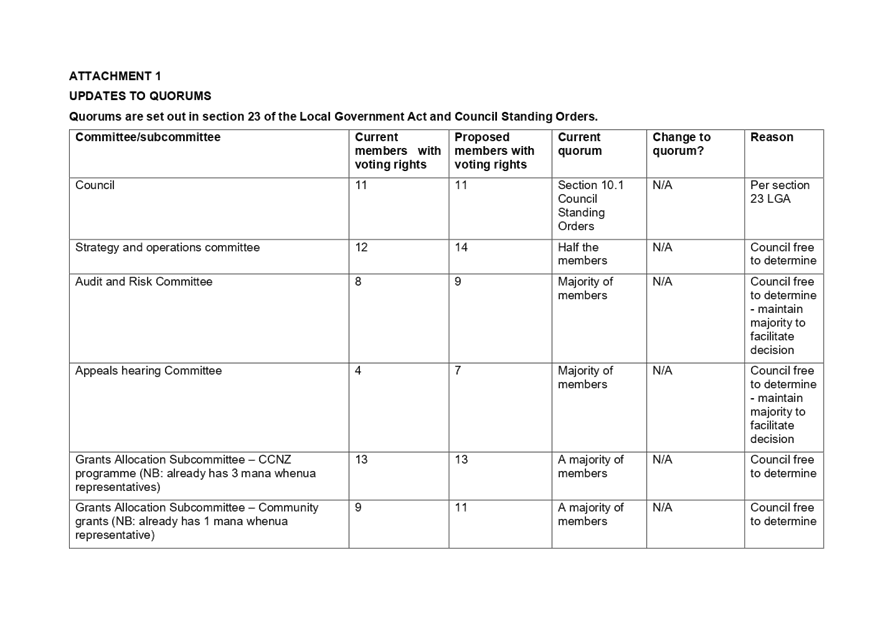

|
Additional Council Meeting Agenda
|
7 June 2022
|
7.3 Road
Stopping and Easement Agreement – legal road adjoining Coastlands, Old
State Highway 1
Kaituhi |
Author: Lynda
Edwardson, Senior Property Advisor
Kaiwhakamana
| Authoriser: Glen O'Connor, Access and Transport Manager
Te pūtake |
Purpose
1 This
report seeks Council’s:
1.1 approval
of the terms of the Road Stopping and Easement Agreement, Coastlands,
Paraparaumu - refer Attachment 1 for a copy of the agreement; and
1.2 authorisation
of the Road Stopping procedures under the Public Works Act 1981.
He
whakarāpopoto | Executive summary
2 Not
required.
Te tuku haepapa
| Delegation
3 The
Council and the Mayor has the delegation to consider, approve and authorise
this matter.
4 This
matter also relates to delegation to dispose of an asset under Section A.2 of
the Governance Structure.
Taunakitanga | RECOMMENDATIONS
That Council:
A. Approve
the terms of the agreement between Council and Sheffield Properties Limited set
out in Attachment 1 of this ‘Road Stopping and Easement Agreement
– Legal Road Adjoining Coastlands, Old State Highway 1’ report
dated 7 June 2022.
B. Note
that the area of road proposed to be stopped is approximately 528 m2 of
land adjoining the Coastlands Shopping Precinct and is shown in red on the map
included as Attachment 2 (‘Stopped Road Land’).
C. Agree
to seek consent from the Minister for Land Information to stop the area of road
described at B under section 116 of the Public Works Act 1981, when that road
formally becomes a local road as part of the Old State Highway 1 Revocation.
D. Should
the Minister for Land Information not agree to stop the area of road under the
Public Works Act 1981:
D.1 Note
that Council and the applicant Sheffield Properties
Limited, proceed with the road stopping under section 342 of the Local
Government Act 1974.
D.2 Agree
to initiate the road stopping procedures under the Local Government Act 1974,
should both Council and Sheffield Properties Limited
agree to proceed under that Act.
E. Note
that upon completion of the road stopping:
E.1 The
stopped road land will be amalgamated with Sheffield Property Limited’s
adjoining property title.
E.2 Sheffield Properties Limited will grant a
relocatable easement to Council for the purpose of providing a public right of
way to and from Coastlands Parade, for the benefit of Council, properties
located on Coastlands Parade, and the public (see area shown green Attachment
2).
E.3 The
Easement Area will be subject to change by mutual agreement to an equivalent
location.
F. Note
that interim measures have been agreed to provide appropriate access in the
period following the transition of Old State Highway 1 to local road, but prior
to completion of the Road Stopping Process. These measures include:
F.1 the
issuing of a licence between Council and Sheffield Properties Ltd to allow
Sheffield Properties Limited to have continued use of the area of Stopped Road.
F.2 Sheffield Properties Limited granting, and Council
accepting, a ‘non-exclusive licence’ for the Council and the public
to pass and repass over Sheffield Properties
Limited’s land on a mutually agreed route to gain access to and
from Coastlands Parade, for the same duration as the licence noted at F.1.
G. Note
that
G.1 the
granting of the public right of way easement is conditional upon the successful
completion of the road stopping and amalgamation of the Stopped Road land into Sheffield
Properties Limited’s adjoining property title.
G.2 if
the road stopping is unsuccessful, the licence granted under F.1 and
non-exclusive licence under F.2, will continue for the term set out in Schedule
1 of the agreement included as Attachment 1.
Tūāpapa | Background
5 The
proposed road stopping and easement will enable aspects of the Paraparaumu
Transport Hub (The Hub) development. The Hub is a project within the Town
Centres and Connectors programme and is a key component of the Paraparaumu Town
Centre Masterplan. The Hub includes significant improvements of the
public spaces directly west of the Paraparaumu Train Station on either side of
Amohia Street and Old State Highway 1.
6 The
Hub will create a unified urban centre and includes a larger and safer bus
interchange, as well as attractive and safe open spaces, connected by a
signalised level crossing. It will improve the public transport
experience for residents and visitors through better connections to the
Coastlands and Kapiti Lights retail areas and beyond.
7 While the Old State Highway 1 is not formally vested in
Council at the date of this report, it will be managed and controlled by
Council once Waka Kotahi have completed the legal revocation process. This is
expected to be completed early 2023.
8 The overall project (and
therefore attached agreement) aligns with the following community outcomes in
the Long-term Plan:
8.1 Mana
whenua and Council have a mutually mana-enhancing partnership.
8.2 Our
communities are resilient, safe, healthy, thriving and connected. Everyone has
a sense of belonging and can access the resources and services they need.
8.3 Our
local economy is prosperous with ample opportunities for people to work and
learn in Kāpiti.
9 Sheffield Properties Limited:
9.1 is the owner of the land (commonly known as
‘Coastlands’) adjoining the proposed road stopping (Stopped Road
Land) which is currently part of Old State Highway 1;
9.2 currently occupies and uses the Stopped Road Land for
carparking purposes associated with the operation of Coastlands Shopping Mall;
and
9.3 has occupied the Stopped Road Land under various leases and
licences granted by Waka Kotahi, most recently being a licence to occupy dated
18 July 2017, which is still current.
10 Officers have worked
with Sheffield Properties Limited to draft an agreement
which is acceptable to both parties. The
Conditional Agreement as set out in Attachment 1, signed by Sheffield Properties Limited and Council’s
Chief Executive dated 29 March 2022, is conditional upon Council approving the
term of the agreement within sixty (60) working days of the date of signing
(i.e. by 27 June 2022). Approval may be given or withheld at the elected
Council’s entire discretion.
Terms of Agreement: Road
Stopping and Interim Access
11 To facilitate The Hub project, Council will need to:
11.1 complete
a road stopping of the ‘Stopped Road Land’ being an area of approximately
528 m2 adjoining Coastlands Shopping Precinct shown red in Attachment
2, under the relevant legislation; and
11.2 grant
a licence to Sheffield Properties Limited (the owners of Coastlands), to allow
them to have continued use of the area of ‘Stopped Road Land’,
until the successful completion of the road stopping process.
12 To
facilitate the project, Sheffield Properties Limited will need to:
12.1 grant a relocatable public right of way easement to Council
on the terms set out in Schedule 3 of the agreement included as Attachment 1;
and
12.2 grant
a non-exclusive licence for Council and the public to pass and repass over Sheffield Properties Limited land on a mutually
agreed route to gain access to and from Coastlands Parade, until the successful
registration of the public right of way easement.
Disposal of the Stopped Road Land
13 Given its long-standing occupation of the Stopped Road Land
(since at least the early 1980’s), Sheffield Properties Limited wishes to
acquire the Stopped Road Land and amalgamate it with its estate.
14 Council does not require the Stopped Road Land for roading
purposes or any other public work and is prepared to facilitate the stopping
and vesting of the Stopped Road Land in Sheffield Properties Limited, as soon
as practical after the Old State Highway 1 is vested in Council as a local road
through the revocation process, subject to
completion of all necessary statutory processes.
15 Council and Sheffield Properties Limited have agreed that
once the Stopped Road Land is vested in Council as a local road, Council will
grant a licence for use of the Stopped Road Land to Sheffield Properties
Limited for consideration of $1, until the road stopping process under the
relevant legislation is complete.
Terms of Agreement: Retention of Access to Coastlands
Parade
16 As part of the design for of The Hub, Council wishes to
remove the left turn vehicular exit from Coastlands Parade (see area shown
light blue on Attachment 2) to the Old State Highway 1, which would
result in a loss of the most direct vehicular access to and from Coastlands
Parade to the wider roading network.
17 To ensure that the public and properties located on
Coastlands Parade retain legal access to and from the Old State Highway 1,
Sheffield Properties Limited has agreed to grant a relocatable public right of
way easement to Council on the terms set out in the agreement.
18 The licence and easement to compensate for the Stopped Road
Land is for consideration of $1. This is considered appropriate
compensation in return for Sheffield Properties Limited’s agreement to
grant Council a public right of way easement enabling the public and business
owners adjoining Coastlands Parade to have legal access rights from the Old
State Highway 1, across Sheffield Properties Limited’s land, to and from
Coastlands Parade.
He
kōrerorero | Discussion
He
take | Issues
19 The
Hub will provide an improved and safer public transport experience. By closing
the left-hand exit from Coastlands Parade to the Old
State Highway 1, a safer pedestrian route to the train and bus station
is achieved.
20 If
the road stopping and easement agreement is not approved, the left hand turn
from Coastlands Parade to the Old State Highway 1, would
not be able to be closed; resulting in The Hub being redesigned and the outcome
of a safer route not being achieved.
21 This
matter has a low degree of significance; however, it is of strategic importance
to Council’s relationship with local business owners in the vicinity
whose direct access from Coastlands Parade to the Old State Highway 1 has been
closed in order to provide a safer vehicular and pedestrian environment in and
around the Paraparaumu Town Centre and the public transport hub.
Ngā
kōwhiringa | Options
Table 1: Table Name
|
Kōwhiringa |
Options
|
Hua | Benefits
|
Tūraru | Risks
|
|
Option A (recommended)
· To stop the area
of road, currently used by Sheffield Properties Limited for Coastlands car
parking, under the PWA or LGA.
· Amalgamate the
‘Stopped Road Land’ into Sheffield Properties Limited adjoining
land title; and
· In lieu of the
Stopped Road Land, Sheffield Properties Limited will grant a public easement
to Council to provide for alternative legal public access from Coastlands
Parade to Old State Highway 1.
· The alternative
public access is required due to the closure of the left-hand exit from
Coastlands Parade to the Old State Highway 1.
|
The benefits of this option are:
· the Hub as
designed will be able to progress.
· a safer
pedestrian route to the bus and train station will be achieved; and
· Alternative legal
access via the relocatable easement to the Old State Highway 1 will be
achieved.
|
The key risk to this option is:
· the road
stopping requires the consent of the Minister for Land Information.
|
|
Option B
· Once the area of
road becomes a local road, negotiation of an exclusive licence / lease to
Sheffield Properties Limited over the land, so they can continue to occupy
the area of road for car parking purposes.
· The licence /
lease agreement will be subject to Sheffield Properties Limited granting to
Council and members of the public alternative access from Coastlands Parade
over their land to and from Old State Highway 1.
|
The benefits of this option are:
· The Public may
have continual access to and from Coastlands Parade.
· Sheffield Properties
Limited will continue to utilise the car parking area located on the area of
Old State Highway 1.
|
The key risk to this option is:
· The left hand
turn from Coastlands Parade to the Old State
Highway 1, may not be able to be ‘closed’ as proposed in The Hub
design. This would result in the need to redesign The Hub and the
outcome of a safer route not being achieved.
· Long term
certainty is unknown when the licence term is required to be
renewed/negotiated.
|
|
Option C
· Continue with
the Status Quo which is Council having no formal agreements in place for
access over Coastlands’ carpark to and from Coastlands Parade.
· When Old State
Highway 1 is transferred to Council it is done free of any licences so
Coastlands will not have legal rights to the existing carparks that are on
the legal road.
|
The benefits of this option are:
· Nil
|
The key risk to this option is:
· The Hub will
have to be redesigned as access to and from Coastlands Parade will not be
guaranteed.
· Long term access
to Coastlands Parade is uncertain through Coastlands’ carpark.
· Uncertainty over
negotiation potential for a long-term licence over either area.
|
22 The
desired outcome is to stop the road currently held under a licence to occupy,
in lieu of a public right of way easement to provide legal enduring access to
and from Coastlands Parade to Old State Highway 1. This will enable The Hub to
proceed as designed therefore proving a safer pedestrian route to and from the
train, bus station and Coastlands Shopping Precinct. This is officers
preferred option (A).
Tangata whenua
23 The
Transport Hub project has support from Te Ātiawa Town Centres Iwi Working
Group which was established in 2015 to ensure that Te Ātiawa ki
Whakarongotai maintained a voice in the design of each town centre project.
24 The
Council has partnered with the Working Group on the design of the Transport
Hub.
Panonitanga āhuarangi | Climate change
25 There
are no Climate change implications specific to the road stopping and easement
agreements sought in this report. However, these agreements will provide
for the creation of a safer and more efficient public transport experience
through the development of The Hub. This is expected to encourage greater
public transport use in the district, which could result in a positive effect
on transport emissions.
26 A
greenhouse gas assessment and carbon inventory will be completed for The Hub
project to estimate emissions produced during construction and over the life of
the assets.
Ahumoni me ngā rawa | Financial
and resourcing
27 The
overall project budget that has been approved by Council includes the cost
associated with setting up of this agreement.
Ture me ngā Tūraru | Legal
and risk
28 Legal
advice from Council’s solicitors Simpson Grierson has been sought to
inform the options set out above. They also prepared the legal agreement
in Attachment 1 of this report, and have confirmed that it is in order
for approval by the Council.
29 The
road stopping process will be undertaken in accordance with legislative and
Council requirements.
30 The
key risk arising from this proposal is that enduring vehicular access to Coastlands
Parade is not guaranteed if the road stopping is not successfully
completed. Under the terms of the agreement, if the road stopping is
unsuccessful, the following agreements will retain status quo access for the
agreed term (currently 5 years):
30.1 a
licence for Sheffield Properties Limited to have continued use of the Road
Stopped Land for carparking purposes, and
30.2 a
‘non-exclusive licence’ for the Council and the public to pass and
repass over Sheffield Properties Limited’s
land on a mutually agreed route to gain access to and from Coastlands Parade.
31 In
this scenario, further legal advice will be sought in relation to a new
agreement for a longer-term solution to ensure ongoing access.
Ngā pānga ki ngā kaupapa here | Policy impact
32 There
are no policy impacts.
Te whakawhiti
kōrero me te tūhono | Communications & engagement
33 Consultation
as required under the relevant legislation will take place. For the
preferred process under the Public Works Act 1981, this will include obtaining
consent from the Minister for Land Information for the road stopping, and
consultation and consent from the adjoining landowners and utility providers.
34 Note
that there is only one adjoining owner which is Sheffield Properties Limited,
and they have agreed to the terms of the agreement which is dependent on the
successful completion of the road stopping.
35 Property
owners adjoining Coastlands Parade have been advised of the proposed change
which will provide secure and enduring legal access for these properties.
They will be advised following the agreement being put in place.
36 In
the unlikely event that the Public Works Act process is unsuccessful, the road
stopping would be undertaken by agreement under the Local Government Act 1974
and full public consultation will be required.
Te mahere tūhono | Engagement
planning
37 An
engagement plan is not needed to implement this decision.
Whakatairanga |
Publicity
38 Council
will use its established communications channels to inform the community of
this decision and to explain the rationale for why it made this decision.
Ngā āpitihanga | Attachments
1. Road
Stopping and Easement Agreement, Coastlands, Paraparaumu ⇩ 
2. Location
of Stopped Road Land, Easement Area and Coastlands Parade ⇩ 
|
Additional Council Meeting Agenda
|
7 June 2022
|
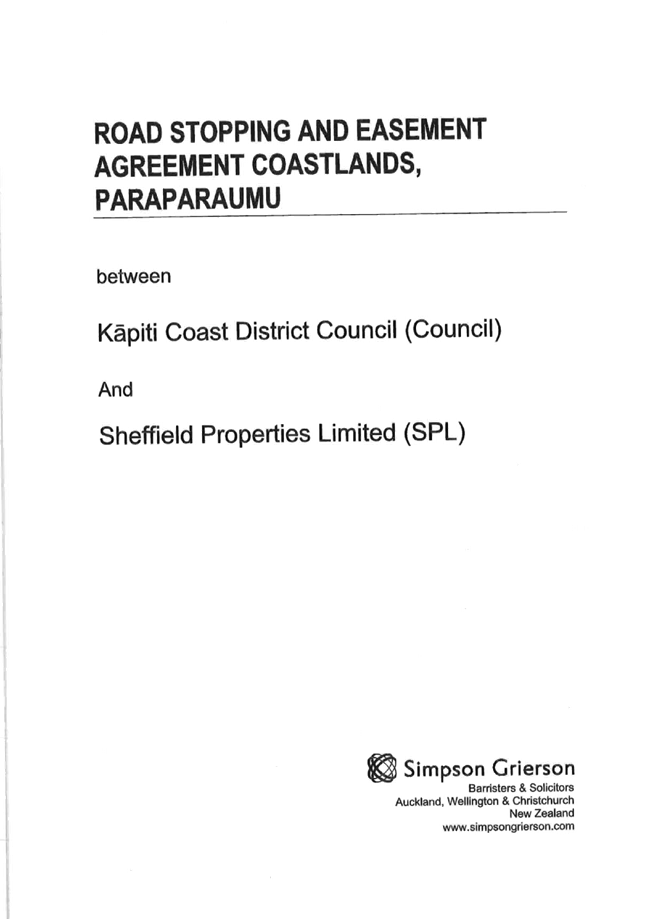
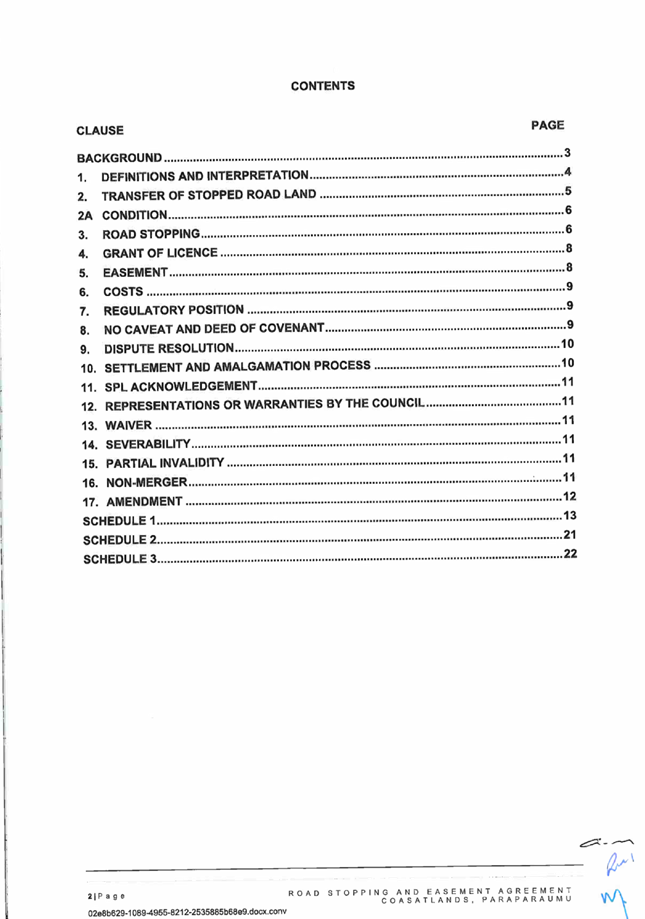

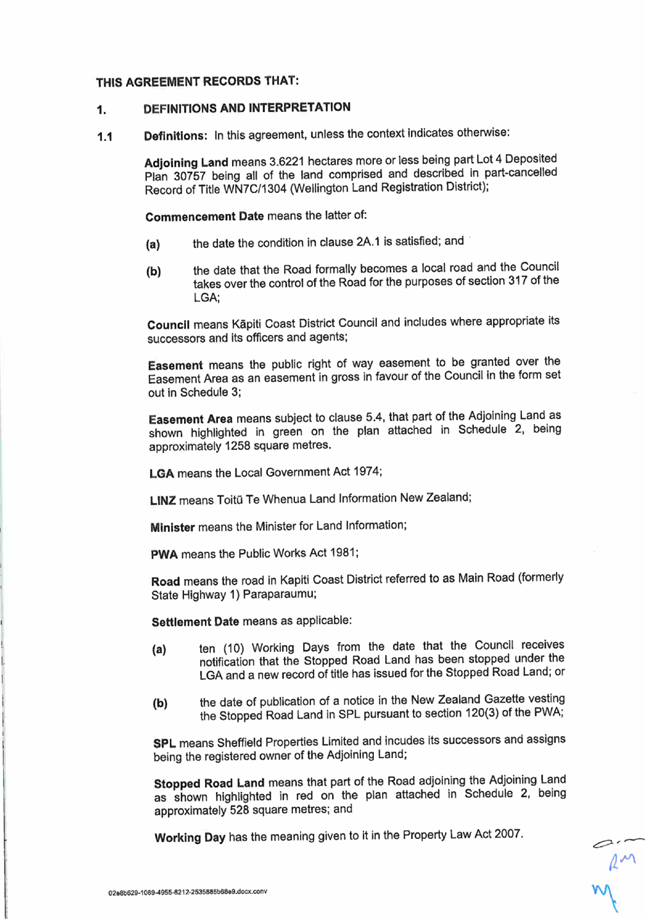

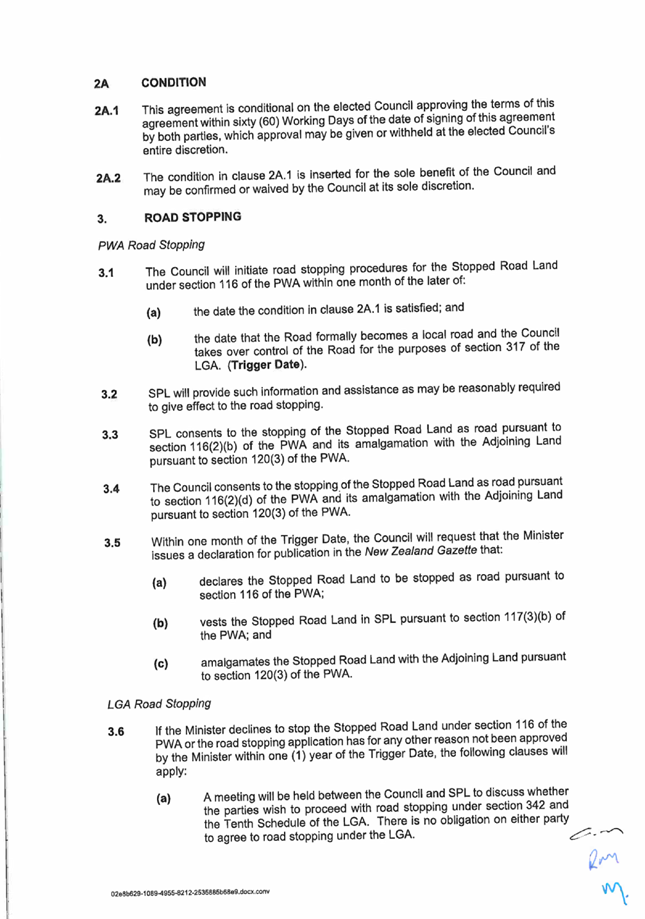
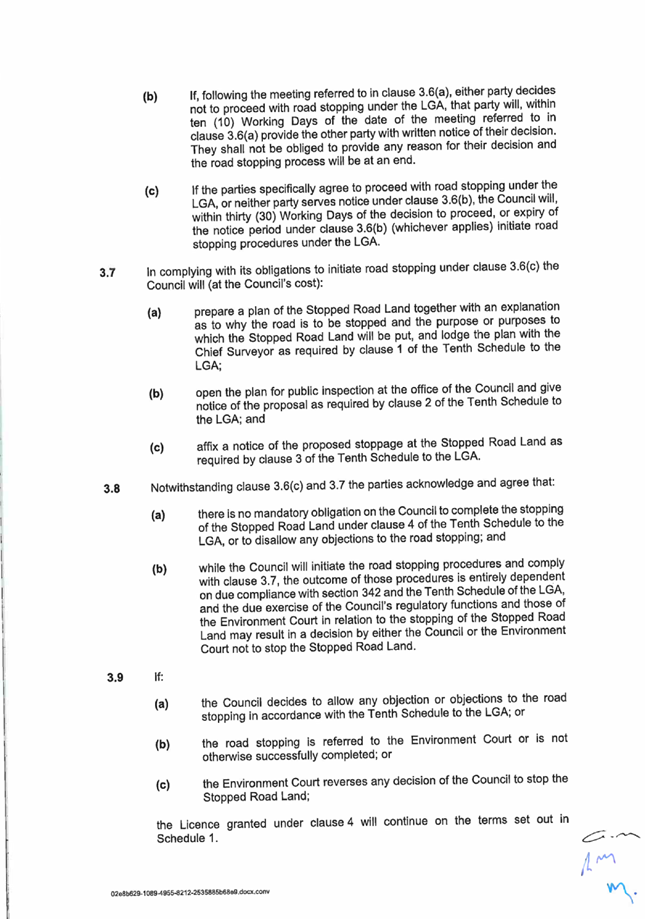
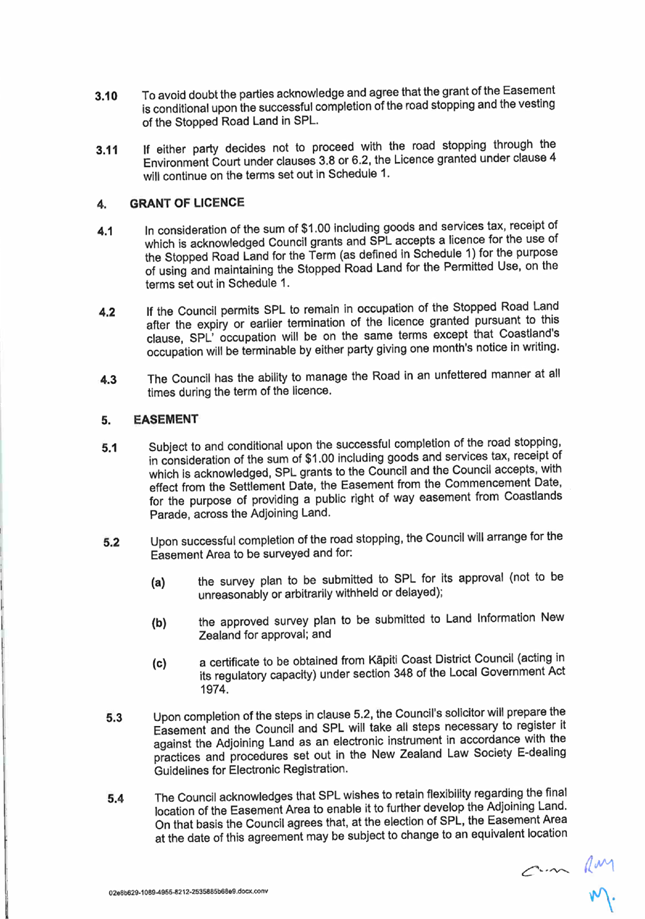

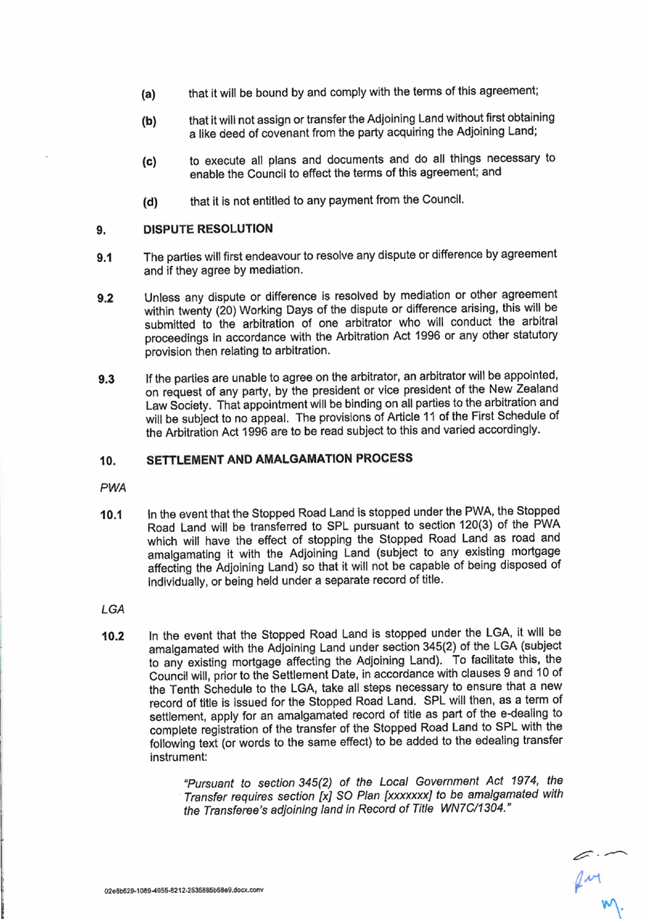

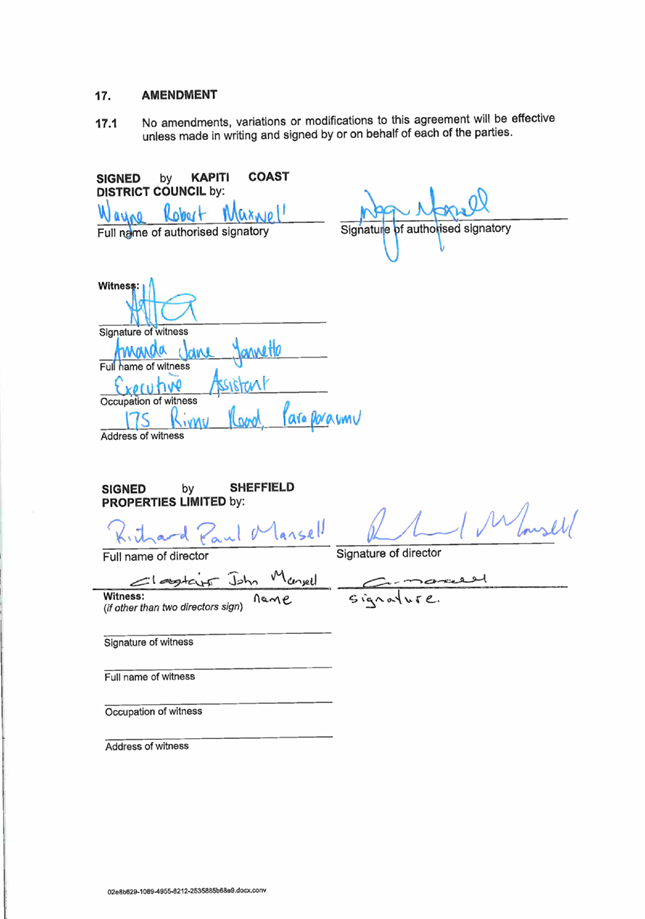
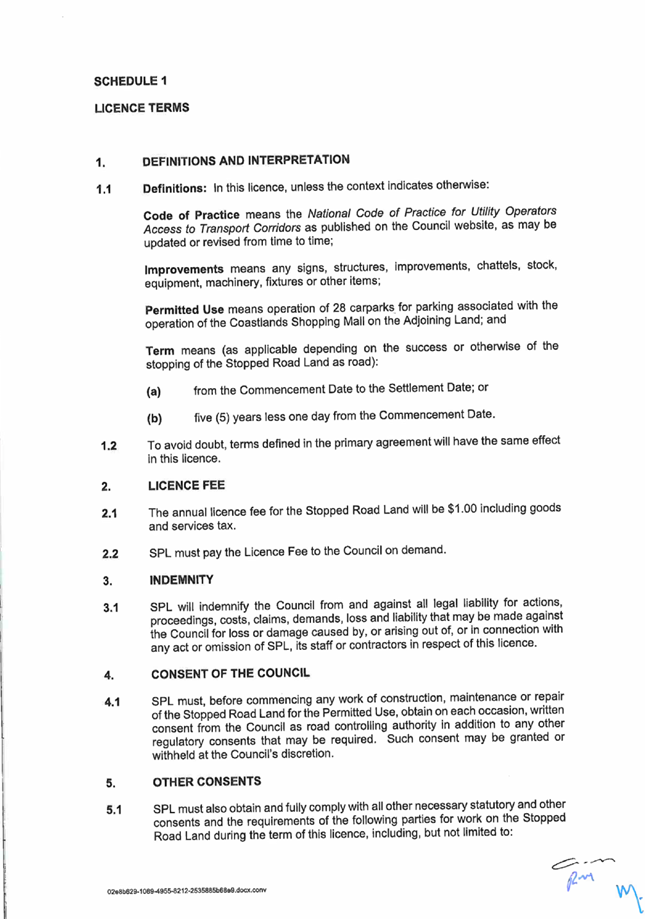
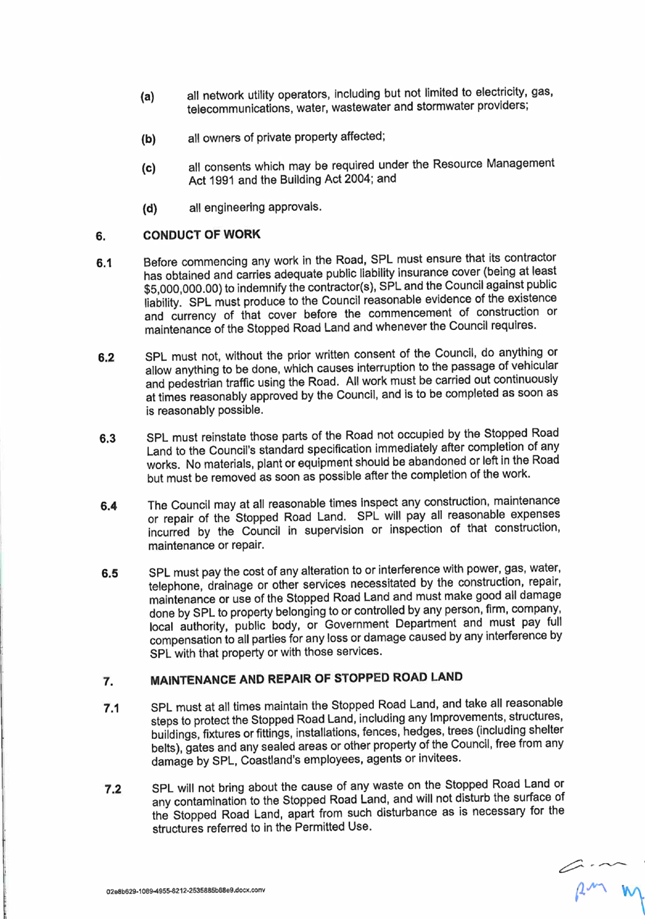
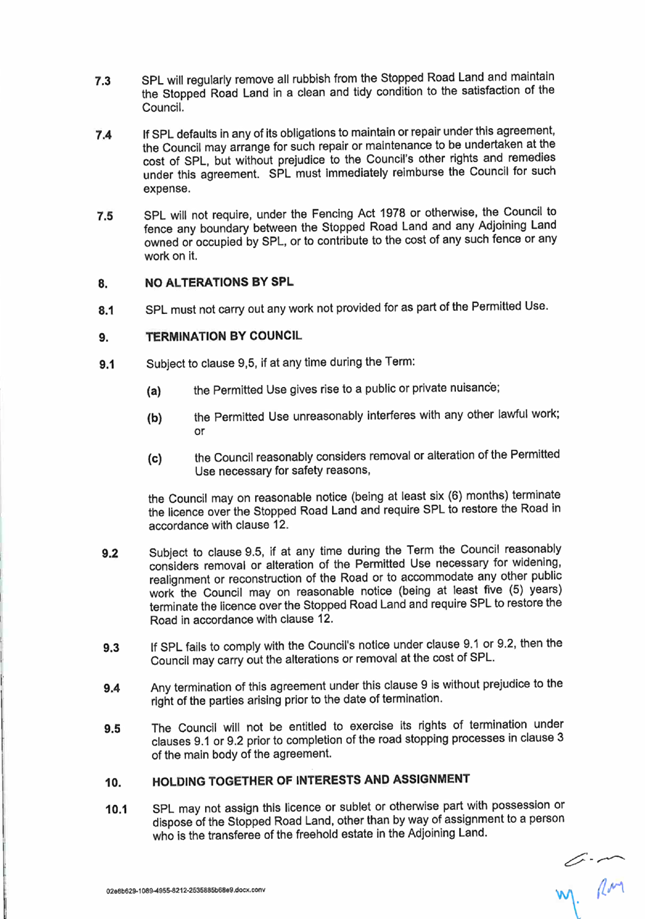
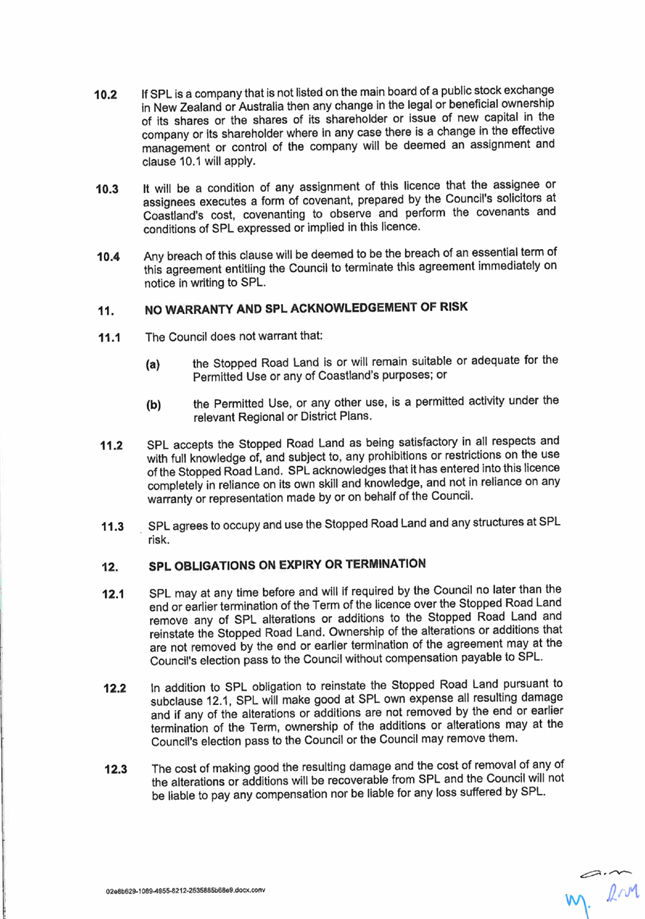
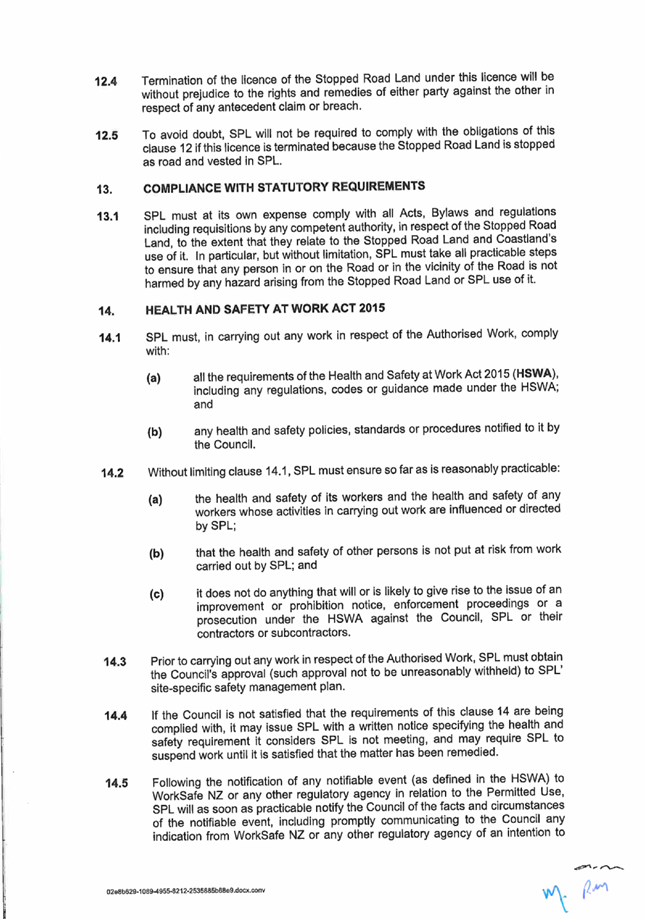
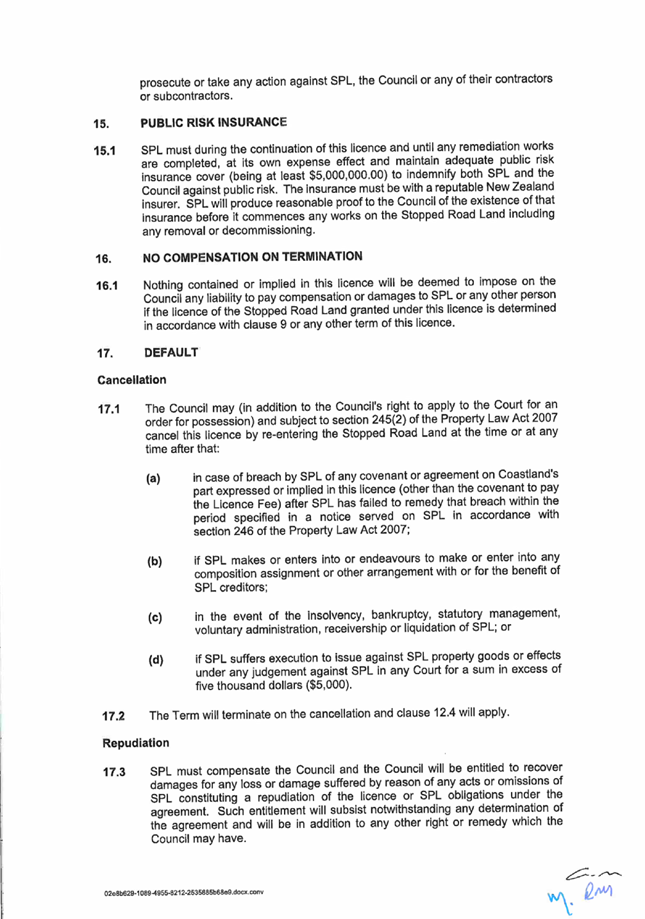
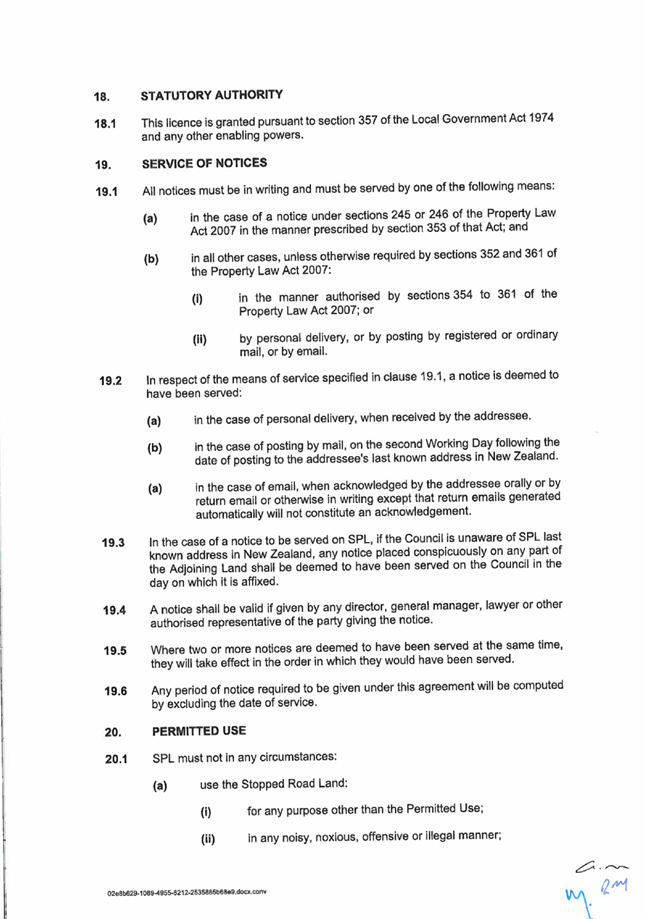
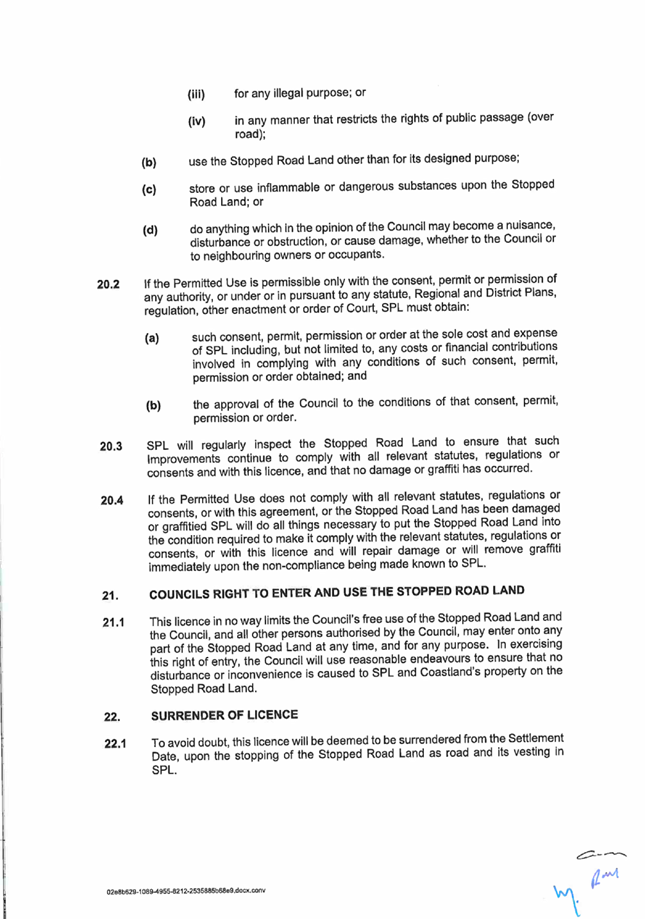
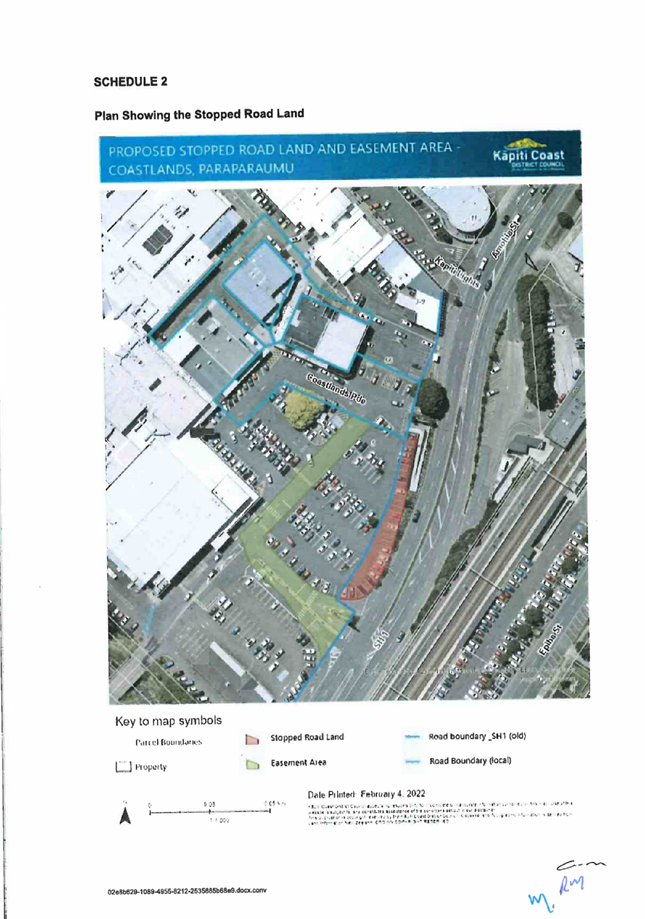

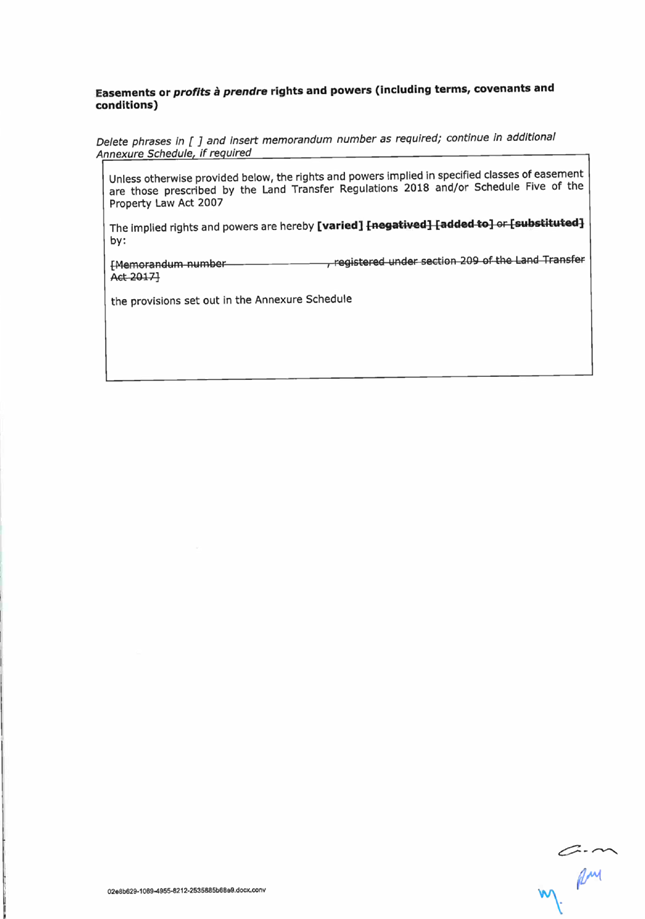
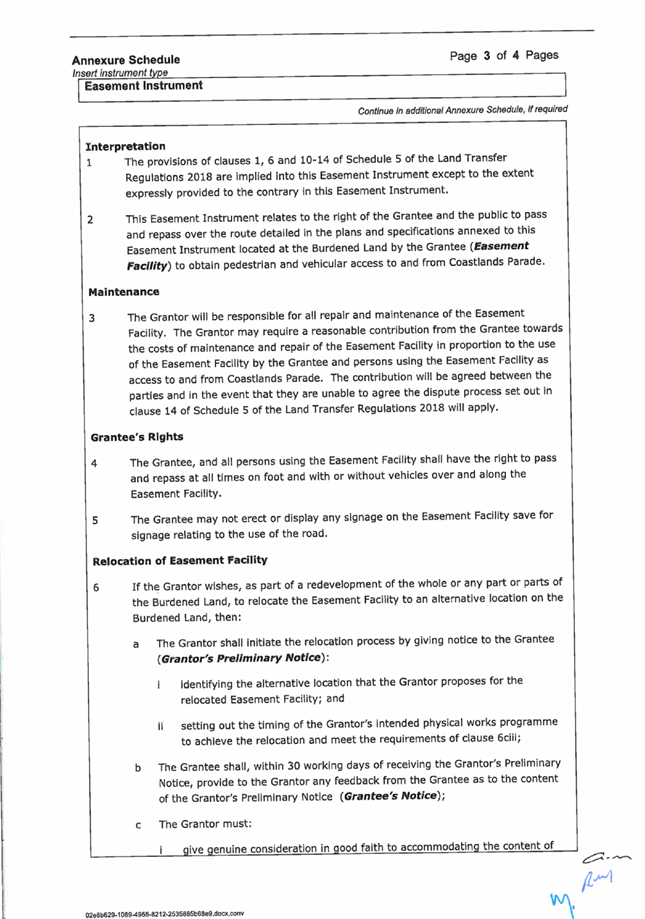
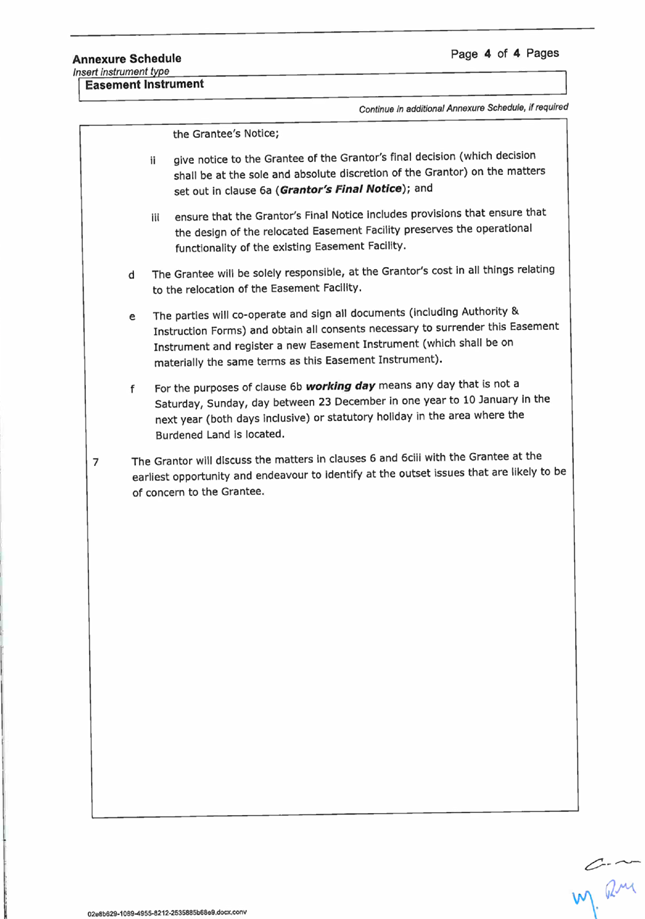
|
Additional Council Meeting Agenda
|
7 June 2022
|

|
Additional Council Meeting Agenda
|
7 June 2022
|
7.4 Omicron
Business Assistance Package for Kapiti Coast Businesses
Kaituhi |
Author: Eva
George, Economic Development Advisor
Kaiwhakamana
| Authoriser: Angela Bell, Strategy Manager
Te pūtake |
Purpose
1 This
paper seeks approval from Council for an Omicron Business Assistance Package
for Kāpiti Coast businesses.
He
whakarāpopoto | Executive summary
2 This
paper provides a summary of the impact that the Omicron outbreak has had on our
local economy and business sector. It includes an overview of previous Council
intervention and makes recommendations for relief measures that could be
implemented to support businesses in the current Omicron outbreak.
Te tuku haepapa
| Delegation
3 Council
has the delegation to consider this matter.
Taunakitanga | RECOMMENDATIONS
That Council:
A. approve
additional funding of $50,000 in the 2022/ 23 FY to undertake targeted
marketing support to help promote local hospitality and retail businesses.
B. approve
the waiver of food licence fees for 12 months, retrospectively from 1 March,
affecting 347 businesses (total expense $45,474).
Tūāpapa | Background
4 Council
approved the Kāpiti Covid Recovery Plan in October 2020. The Plan looked
ahead at how Council would be able to support its community and help the
economy recover.
5 COVID19
has affected us, and has continued to do so, in many different ways. The
outbreak has had a large impact on the New Zealand economy and although the
Kāpiti Coast business sector came out of 2021 comparatively well, since
late February 2022, data is showing a steep decrease in local spending (see
Attachment 1 for further detail).
6 The
Long Term Plan (LTP) identified COVID19 as ‘a challenge affecting
economic development and wellbeing’. Council’s Economic Development
(ED) Team contributes supporting business resilience through activities such
as:
6.1 visitor
attraction;
6.2 business
support and facilitation; and
6.3 workforce
and skills development.
7 The
ED Team has been working with the Economic Development Kotahitanga Board (EDKB)
to implement the Economic Development Strategy (EDS) and the COVID Recovery
Plan and engaging with local industries to understand the challenges and
opportunities they face. The workplan is guided by Destination Management Plan
and the Workforce Plan that have recently been adopted by Council.
8 In
addition to the above workplan, together with the Finance and the Environmental
Health, Licensing & Compliance teams, staff have designed a package to
support those businesses that were heavily impacted by the Omicron outbreak.
He
kōrerorero | Discussion
9 Early
March 2022, the ED Team undertook research which indicated that retailers were
finding the economic climate challenging. A variety of factors were coming to a
head:
9.1 Ongoing
labour shortages are being compounded by Covid-related staff absences;
9.2 Rising
inflation and interest rates, supply chain issues, rising fuel costs, and the
minimum wage rise on 1 April;
9.3
A drop in card transactions in the Kāpiti Coast Region in 2022. Note that
the value of the transactions had increased slightly, due to price inflation in
food and fuel, masking the drop in value of all other categories;
and
9.4 The
peak of Covid infections was expected to occur later in March and in April,
making this a critical time for businesses with many possibly needing to close
partially / temporarily.
10 Early
May, data provided by Marketview confirmed declining Card transactions was a
national trend that was also affecting our local economy, as seen in the graph
below (Table 1). Additionally, targeted data displayed that the hospitality and
retail sectors were the hardest hit (Table 2).
Table 1:
Marketview – COVID19 Weekly Report, Kāpiti Coast, Week ending 1 May
2022
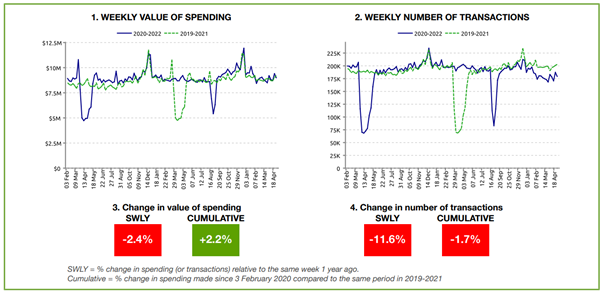
Table 2:
Marketview – COVID19 Weekly Spending Change by Category*, Kāpiti
Coast, Week ending 1 May 2022

*
This table shows a comparison of the value of spending and volume of credit and
eftpos transactions for each week since 3 February 2020 with the Same Week in
2019-2021 (SWLY). Cumulative figures are based on a running total of
spending/transactions since 3 February 2020.
11 In
summary:
11.1 On
1 May, the number of eftpos card transactions had dropped by 11.6% compared to
the same week a year ago.
11.2 The value of transactions across all sectors had dropped by 2.4%
compared to the same week a year ago, however inflation in food and fuel prices
masked the drop in value of transactions in all other categories.
11.3 Overall spend has been decreasing since early February, in time with
the onset of Omicron in our community.
12 The
Marketview data is reflected in the results from a survey undertaken by the ED
Team. Businesses were asked for their views on the local economy and the main
challenges they faced (9 March 2022). The outcome showed the following main
challenges facing our businesses, in order of concern:
12.1 Labour shortages;
12.2 Cashflow issues resulting from business disruption/temporary
closures; and
12.3 Government COVID19 Leave support is insufficient – it only
provides 40% of minimum wage, and some don't qualify.
13 Furthermore, businesses were keen to see how Council could assist
through this period, in addition to Central Government support. In
February this year, Central Government increased its support through:
13.1 COVID-19 Support Payment – for businesses or organisations
which experienced a 40% or more drop in revenue due to COVID-19.
13.2 Small Business Cashflow Scheme:
13.2.1 On 21 March the Small Business Cashflow Scheme loan amount increased
to $20,000 (from $10,000), plus $1,800 per full-time equivalent employee.
13.2.2 A top-up loan is also available for businesses and organisations
that currently have a loan under the original amount.
13.3 Flexibility from IRD on due dates for tax returns, payments,
disclosures, and elections.
He
take | Issues
14 Through
direct engagement with our local business sector, Council staff have become
aware of the challenges that our businesses continue to face. Guided by the
COVID19 Recovery Plan , actions provided by our Council during the initial
COVID19 pandemic (2020/21) included:
14.1 Keeping
the business sector informed about COVID19 support for workers and employers by
Central Government;
14.2 Love
Local marketing campaign by Kapiti Coast District Council;
14.3 Additionally,
Council provided a variety of ‘Financial assistance for Kāpiti
community and business’ measures[2].
This included:
14.3.1 Rates
Package Covid 2020/21 - removed rates late payment penalties for April, May and
June 2020, and provided a June 2020 rates payment holiday for those impacted by
COVID19; and
14.3.2 2020
Business Interruption Credit - credited a quarter of fees for food, alcohol and
outdoor dining licenses paid in FY 2020/21 to reflect the period when
businesses were unable to operate.
14.3.3 Waiving
rent payments for three months for major tenants.
Ngā
kōwhiringa | Options
15 The Omicron outbreak began in early 2022 and its effects on our
local economy have led to a quick review of
previous measures and their appropriateness to be reintroduced to support our
business community during the current Omicron wave
Food Registration Fee
Waiver
16 Given
the particular pressures on the food and beverage sector noted above, Council
staff propose to waive the registration and annual renewal fees for all food
businesses registered by KCDC. These fees relate to businesses that require
either a Food Control Plan (FCP) or a National Programme (NP) - the two types
of risk management tools for food businesses. The fees for these
registrations under the Food Act 2014 are set by Council through the Fees and
Charges Schedule in the Long Term Plan, and are as follows:
16.1 FCP
– $159 for annual registration
16.2 NP
– $159 for two-year registration.
17 As
the fees for NP businesses are for a two-year registration, the proposed waiver
is for 50% of the renewal fee - $79.50.
18 Council
recommends the credit to be applied to all food businesses registered with
KCDC. This was the approach taken in 2020 and provides the most efficient
way of administering the waiver and providing relief to the sector as a whole.
19 Anticipated
costs of the proposed fee waiver are set out in the table below.
Table 3: Number of businesses affected by the food
registration fee waiver

Additional Marketing
Support
20 A
Love Local marketing campaign was undertaken during March and April 2021 lockdown
to encourage local support for businesses. An analysis of the work undertaken
(Attachment 2) indicated the campaign was successful at encouraging the
community to support local retail and hospitality business in particular.
21 Given
the ongoing impacts on the hospitality and retail sector as a result of
Omicron, we recommend Council provides increased marketing and promotion to
support the local Hospitality and Retail sectors at an additional cost of
$50,000. The Economic Development (ED) Team will draft a marketing plan to
achieve maximum reach based on learnings from previous campaigns.
Other Options
Considered
22 Rates
relief. As noted at 14.3.1 above, rates relief was made available to
all ratepayers experiencing hardship in 2020. This relief involved
waivers of penalties and a payment holiday. Our review of these measures found
that these measures are not well targeted to the businesses
currently under pressure (as they apply to all ratepayers) and would be
unlikely to substantially assist those businesses most affected by Omicron.
23 It
is not recommended to include a rates discount in the proposed Omicron Business
Assistance Package.
24 Waiver of rent payments for
major tenants. Rent relief was offered to
major Council tenants in 2020 in response to the initial Covid lockdown when
businesses were unable to operate. Given that these businesses are
currently able to operate under the orange traffic light setting, it is not
considered to be an appropriate measure for the current package of business
support.
25 No
additional business support. The pressures on the retail and hospitality
sector have continued to increase even following the easing of restrictions to
an orange traffic light setting. In this context, Council has a role to
support the local business sector and promote economic wellbeing more broadly.
Therefore, it is considered appropriate for Council to provide some additional
support as proposed above.
Tangata whenua
26 There
are no specific impacts on tangata whenua as a result of this proposal.
The relief package is expected to benefit all food businesses that are part of
the Kāpiti Coast business sector.
Panonitanga āhuarangi | Climate change
27 The
suggested package does have any specific climate change implications. However,
the ED Team continues to encourage and support local businesses to work in
environmentally conscious ways through our ongoing engagements with them.
Ahumoni me ngā rawa | Financial
and resourcing
28 The
proposed relief package will incur an additional cost to Council of $95,474,
made up of:
28.1 $50,000
marketing package over 6 months.
28.2 $45,474
for the food registration fee waiver over 12 months, from March 2022.
Ture me ngā Tūraru | Legal
and risk
29 There
are no specific legal implications of this proposal.
Ngā pānga ki ngā kaupapa here | Policy impact
30 Registration
and annual renewal fees for food businesses are set by Council through the
Schedule of Fees and Charges in the Long Term Plan and relate to the
registration of businesses under the Food Act 2014.
31 The
proposed fee waiver will not impact on the registration of businesses and their
compliance with the Food Act 2014.
32 Due
to the waiver being processed as a credit on accounts, the proposal also
remains consistent with agreed Schedule of Fees and Charges in the Long Term
Plan.
Te whakawhiti kōrero me te
tūhono | Communications &
engagement
Te mahere tūhono | Engagement
planning
33 This matter has a low level of a significance under
Council’s Significance and Engagement Policy. An engagement plan
is not needed for this report to be considered.
Whakatairanga |
Publicity
34 Council will use its established communications channels to
inform food businesses of the waiver of the food registration annual
renewal fee and advise the community and key stakeholders of the Omicron
Business Assistance Package.
Ngā āpitihanga | Attachments
1. Weekly
Card Transaction Measure ⇩ 
2. Business
Support Analysis & Data 2021 ⇩ 
|
Additional Council Meeting Agenda
|
7 June 2022
|
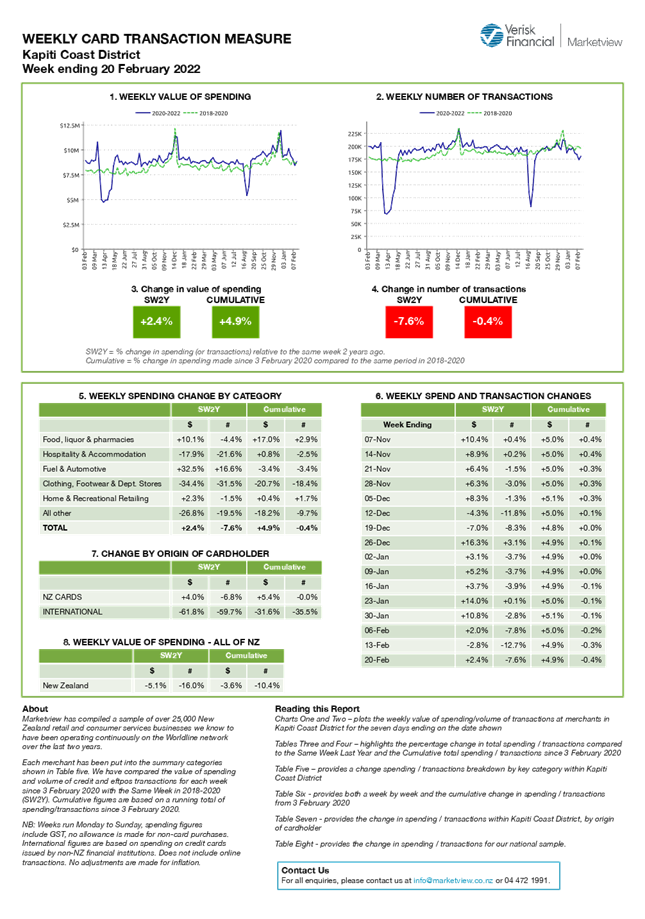
|
Additional Council Meeting Agenda
|
7 June 2022
|
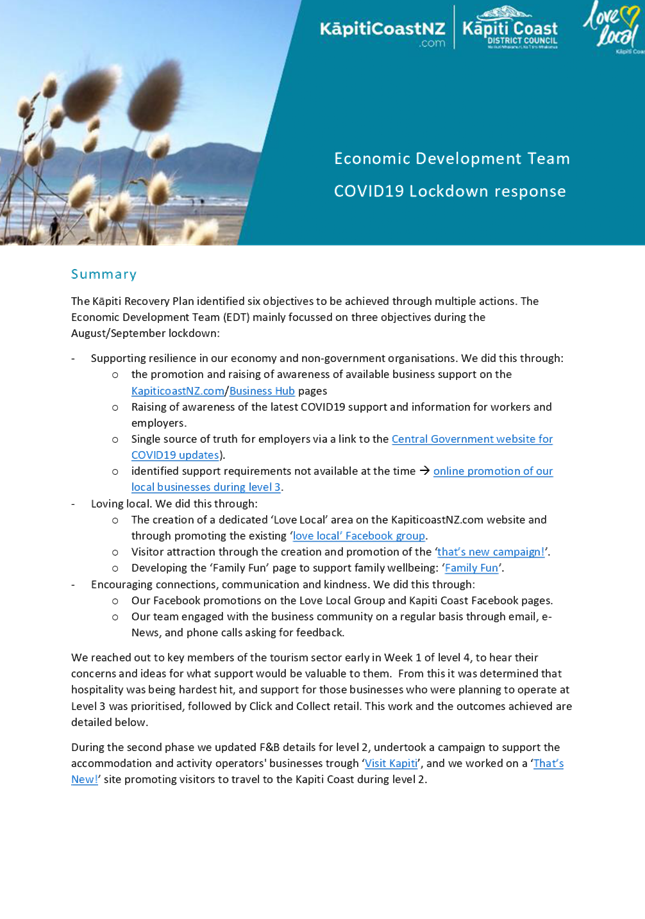
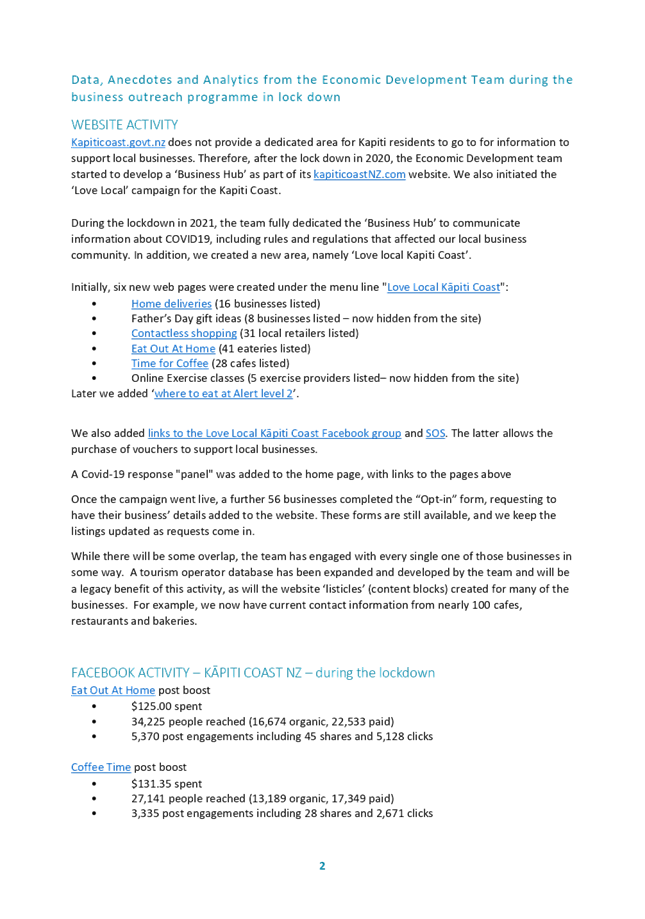
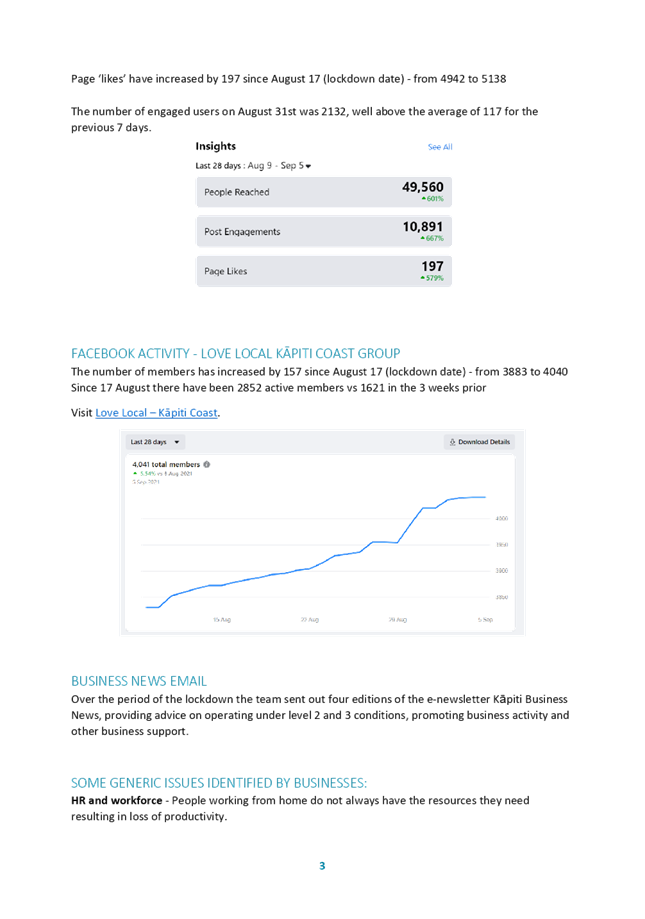
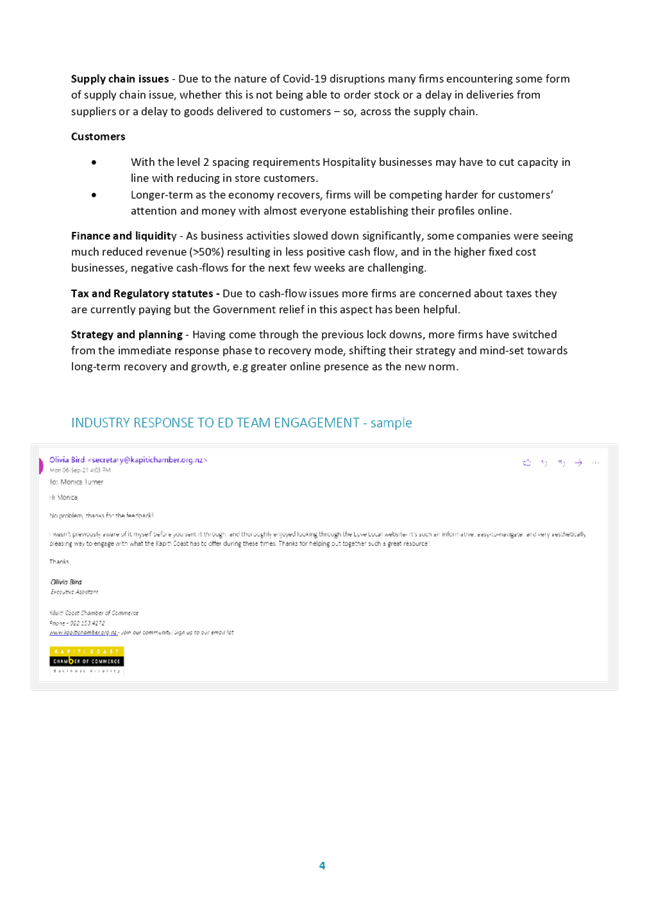
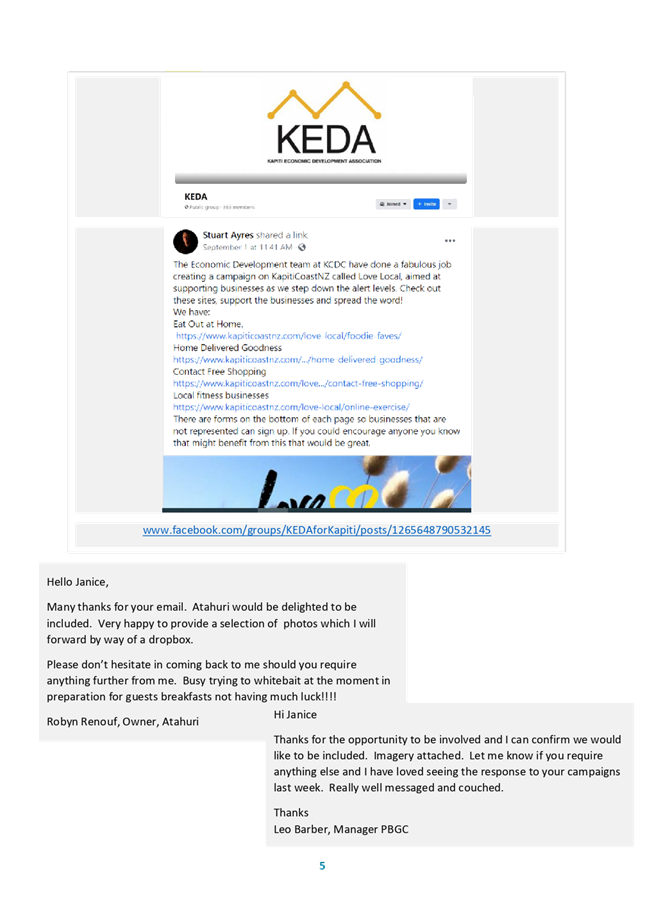

|
Additional Council Meeting Agenda
|
7 June 2022
|
8 Public
Speaking Time
·
Public Speaking Time responses
9 Confirmation
of Public Excluded Minutes
Nil

































































































































































